You are using an out of date browser. It may not display this or other websites correctly.
You should upgrade or use an alternative browser.
You should upgrade or use an alternative browser.
Fiio FW5
- Added by Dsnuts
- Create date
Ichos
Reviewer at hxosplus
Pros: + Great sound quality for the category
+ Fun and entertaining
+ Good bass extension and technicalities
+ Transparent and resolving
+ Dynamic and impactful
+ Wide soundstage
+ Good passive noise attenuation
+ Excellent call quality
+ Lightweight and comfortable
+ Customizable through the FiiO control application
+ Stable connection with low latency
+ Good build quality and IPX4 certification
+ Physical buttons
+ Lightweight charging case
+ Fun and entertaining
+ Good bass extension and technicalities
+ Transparent and resolving
+ Dynamic and impactful
+ Wide soundstage
+ Good passive noise attenuation
+ Excellent call quality
+ Lightweight and comfortable
+ Customizable through the FiiO control application
+ Stable connection with low latency
+ Good build quality and IPX4 certification
+ Physical buttons
+ Lightweight charging case
Cons: - No active noise cancellation
- Rather short battery duration
- Doesn't support aptX HD
- The case feels fragile and plastic
- Rather short battery duration
- Doesn't support aptX HD
- The case feels fragile and plastic
You can read the full FiiO FW5 review with photos and comparisons in my website.

Executive summary
The FiiO FW5 is a TWS earphone that is made with sound quality in mind and doesn't have ANC or any other features that could compromise it. Instead it features an independent audio architecture with a AK4332 high-performance DAC and separate amplifiers in each earpiece.
The FiiO FW5 has a popular, V-shaped tuning with some audiophile essence and good technicalities for the category. The sound is fun and entertaining with great bass that is tight, controlled, dynamic and physically impactful. The tuning is not that neutral but you can listen to classical music without much tonal inaccuracies. The mid-range is slightly recessed but is crystal clear and transparent while the treble is fast and energetic without sounding harsh.
The FiiO FW5 is surprisingly resolving and transparent for a TWS earphone with good detail retrieval. The soundstage is wide and spacious with good positioning accuracy. The overall timbre is quite natural and the sound is very homogeneous thanks for the good drivers implementation.
The FiiO FW5 is further customizable through the FiiO control application which supports a 10-band parametric equalizer. Bluetooth connection is stable and call quality is very good. The FW5 now supports the LDAC codec but no aptX HD.
The FiiO FW5 is well made, it is has physical buttons, it is lightweight and comfortable with good passive noise attenuation. The charging case is compact and lightweight but it feels plastic. Battery duration is average but will last you a day with mixed usage.
In the end, the FiiO FW5 offers exactly what it promises, excellent sound quality that you will rarely find in a TWS earphone, especially for such a competitive price.

Executive summary
The FiiO FW5 is a TWS earphone that is made with sound quality in mind and doesn't have ANC or any other features that could compromise it. Instead it features an independent audio architecture with a AK4332 high-performance DAC and separate amplifiers in each earpiece.
The FiiO FW5 has a popular, V-shaped tuning with some audiophile essence and good technicalities for the category. The sound is fun and entertaining with great bass that is tight, controlled, dynamic and physically impactful. The tuning is not that neutral but you can listen to classical music without much tonal inaccuracies. The mid-range is slightly recessed but is crystal clear and transparent while the treble is fast and energetic without sounding harsh.
The FiiO FW5 is surprisingly resolving and transparent for a TWS earphone with good detail retrieval. The soundstage is wide and spacious with good positioning accuracy. The overall timbre is quite natural and the sound is very homogeneous thanks for the good drivers implementation.
The FiiO FW5 is further customizable through the FiiO control application which supports a 10-band parametric equalizer. Bluetooth connection is stable and call quality is very good. The FW5 now supports the LDAC codec but no aptX HD.
The FiiO FW5 is well made, it is has physical buttons, it is lightweight and comfortable with good passive noise attenuation. The charging case is compact and lightweight but it feels plastic. Battery duration is average but will last you a day with mixed usage.
In the end, the FiiO FW5 offers exactly what it promises, excellent sound quality that you will rarely find in a TWS earphone, especially for such a competitive price.
Last edited:
o0genesis0o
Headphoneus Supremus
Pros: + Large, open, 3D soundstage
+ Punchy but controlled bass and percussions
+ Excellent instrument separation
+ Tonally correct
+ Stable connection
+ Parametric EQ
+ Punchy but controlled bass and percussions
+ Excellent instrument separation
+ Tonally correct
+ Stable connection
+ Parametric EQ
Cons: - Thick case
- Volume buttons borderline unusable
- Micro details are merely good
- Somewhat generic tuning due to the twin peaks at 2kHz and 5kHz
- No LDAC support (yet)
- Volume buttons borderline unusable
- Micro details are merely good
- Somewhat generic tuning due to the twin peaks at 2kHz and 5kHz
- No LDAC support (yet)
Recently, I managed to complete my dream portable head-fi setup, consisting of an excellent music player (M6U), a nice pair of earbuds (FF5), and excellent IEMs. The whole setup can be packed neatly in my briefcase and follow me everywhere.
I must have spent much time listening to this incredible setup, right?
Not quite. Most of my listening in the last few weeks was done with a pair of True Wireless Stereo (TWS) IEMs from Fiio. And no, it was not just for writing this review.
Let’s talk about Fiio FW5.
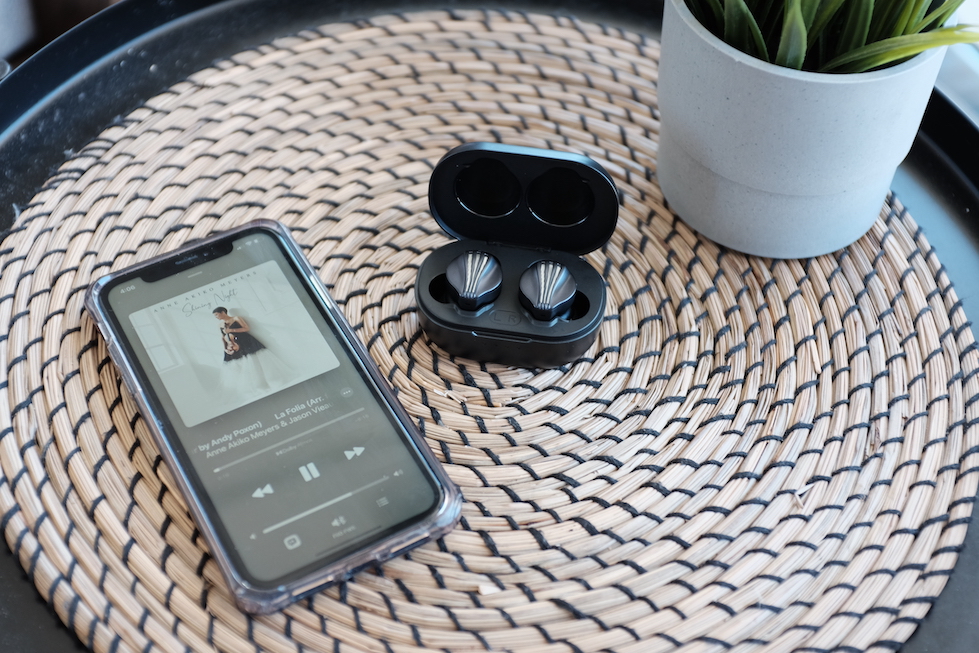
We all know that TWS are Bluetooth IEMs that do not rely on any wire to connect with each other and a source device, such as your phone. So which wire, in particular, was removed by TWS?
I have always thought the removed wire is the IEM cable (you know, the copper or silver strings that divide this head-fi hobby into “believers” and “objectivists” camps). However, as I hold the FW5 in my hands, it suddenly dawns on me that it is not the electrical cable that was chopped off.
It is the digital cable (e.g., USB) connecting your phone with your audio chain, including DAC, amplifier, IEM cable, and IEMs. When you start music on your phone, the 1s and 0s are transmitted wirelessly via Bluetooth (rather than a USB cable) to the DAC chip within each earpiece. The DAC chips then transform the 1s and 0s into electrical signals. The built-in amplifiers make the signals larger to drive the speakers (drivers), delivering sound to your ears. Bluetooth codecs such as AAC and LDAC, then, can be considered the “quality” of the digital cable. One day, when Bluetooth can transmit as fast and as many 1s and 0s as USB cables, we will have wireless systems that behave exactly like wired setups.
In other words, when you hold a pair of TWS in your palm, you are holding a full-fledged portable setup, not just two earpieces with their wires chopped off. This, my friends, is an impressive feat of engineering (and perhaps why it has been so tricky for traditional IEM manufacturers to make decent TWS).
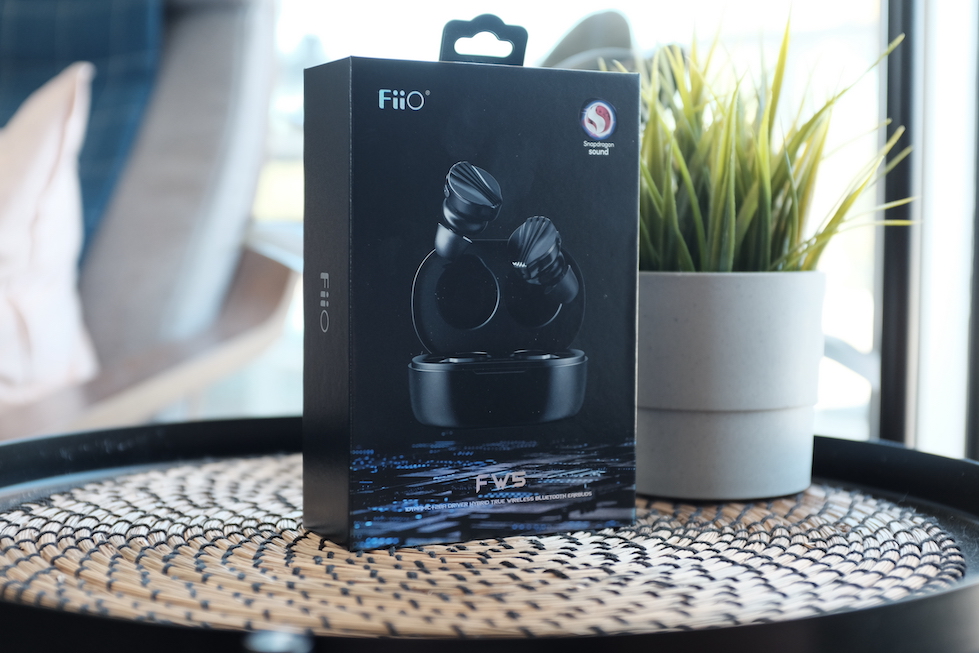

Fiio FW5 is a midrange entry (number 5 in the name) in the main product lines of Fiio (FW - Fiio Wireless). The packaging reflects this position. If you have seen any Fiio product, then you know the drill: thick cardboard box with holographic prints and logos, magnetic flaps, two layers of custom foam inserts holding the goodies, and an abundance of accessories.
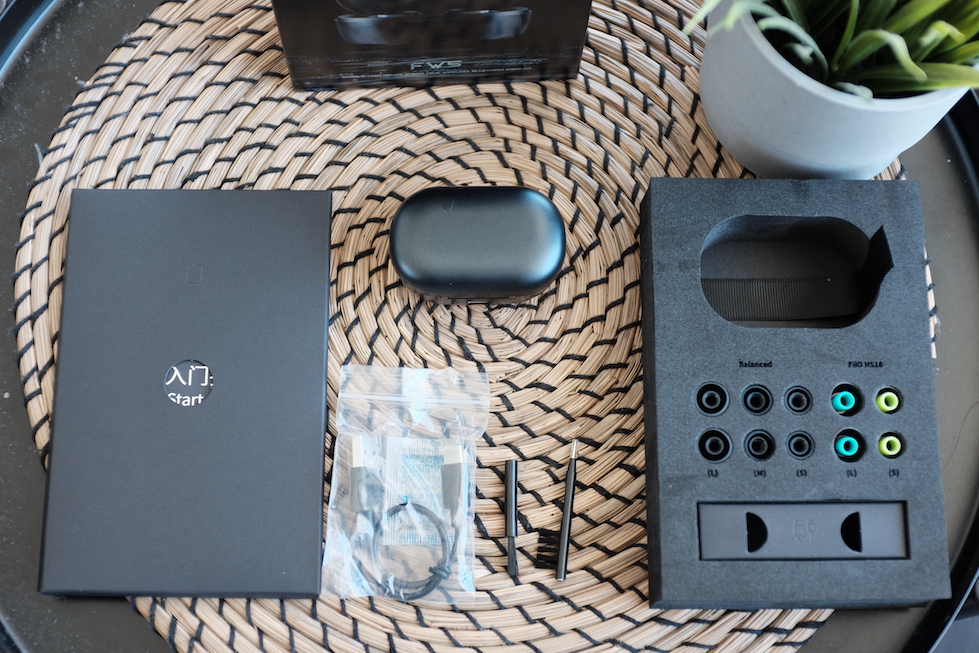
FW5 comes with a nice USB-C cable, two cleaning tools, and two sets of ear tips.
Your choices of ear tips include the classic “balanced” silicone tips and the newly released HS18 tips. They change the sound and comfort noticeably, so I recommend trying them all. I personally settled for a pair of medium HS18 tips.
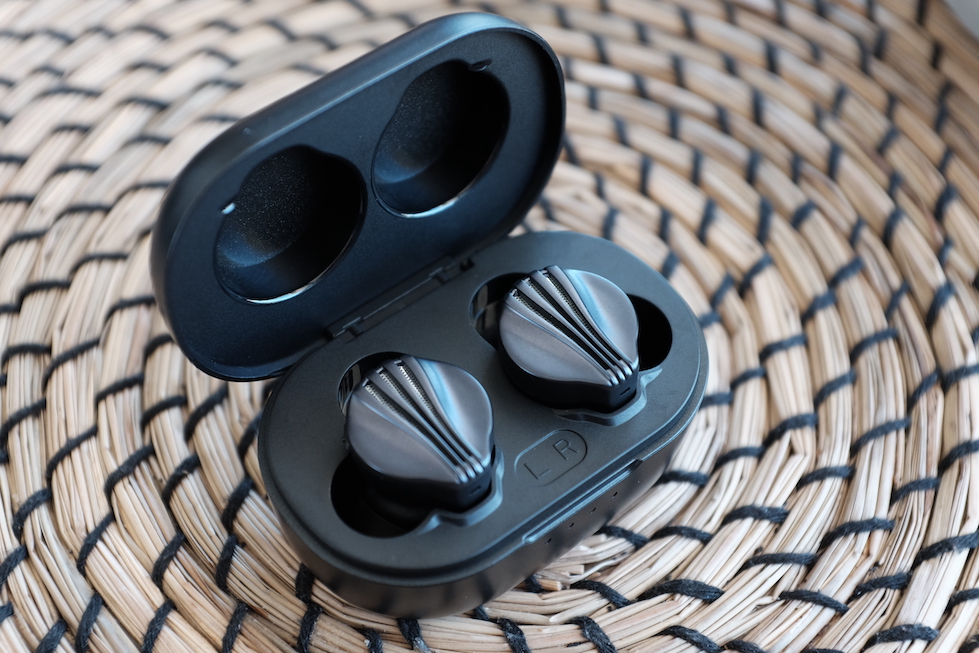
Let’s talk about the earpieces.
At a glance, it’s immediately apparent that Fiio draws inspiration from their iconic FD5 and FD7. According to Fiio, these IEMs are semi-open even though they have IPX4 water resistance. I can confirm that FW5 has a large and open soundstage, just like the FD and JD series IEMs.
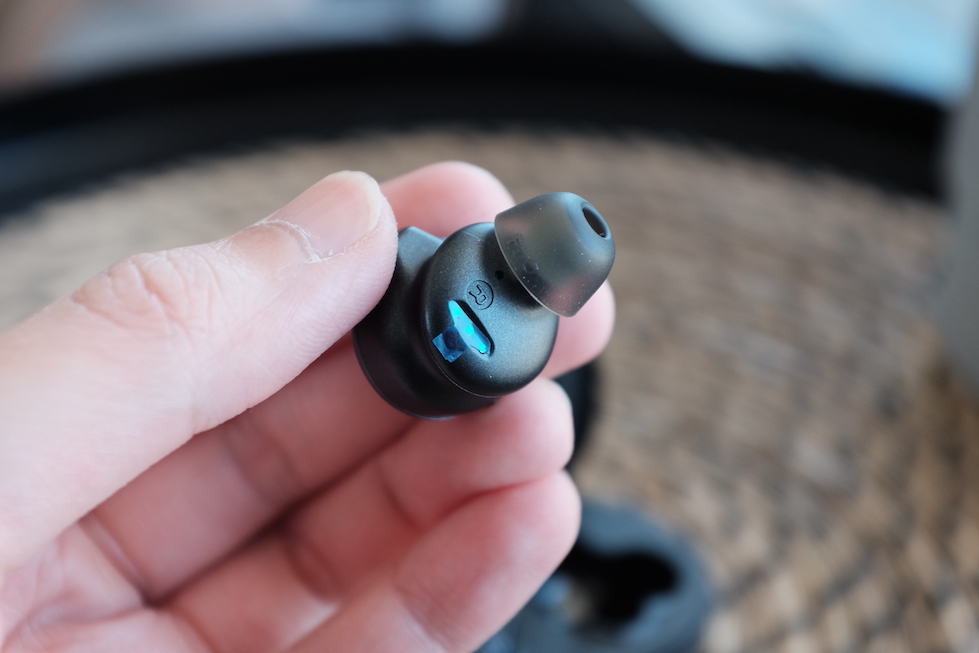
Luckily, the rest of the earpieces is lightweight plastic rather than stainless steel, like FD5 and FD7. The part touching your ears has the same shape as the Apple EarPods, allowing the earpieces to lock into place against the concha of your ears. Instead of a simple opening like the EarPods, FW5 terminates with a medium-sized nozzle placed at an angle. By twisting the earpieces back and forth, you can angle the nozzle just right against your ear canal for a comfortable and secure fit.

There are two buttons on each earpiece, bringing to a total of four buttons. These can adjust the volume, control playback, accept phone calls, and invoke voice assistants.
I have a bone to pick with Fiio regarding the volume control. Simply put, the volume buttons are too insensitive. At first, I thought the volume control did not work due to some compatibility issues. And then, I realised that I needed to tap and hold the volume button a bit for the change to register, but not too long since FW5 would recognise a song skip request.
It should be noted that FW5 has independent volume control.It means that the volume buttons control how much FW5 amplifies the music. The system volume, such as on your phone, determines how loud the source music is for FW5 to amplify. Due to the issues with the volume buttons, I keep FW5’s internal volume at around 75% and use the phone to control the volume.
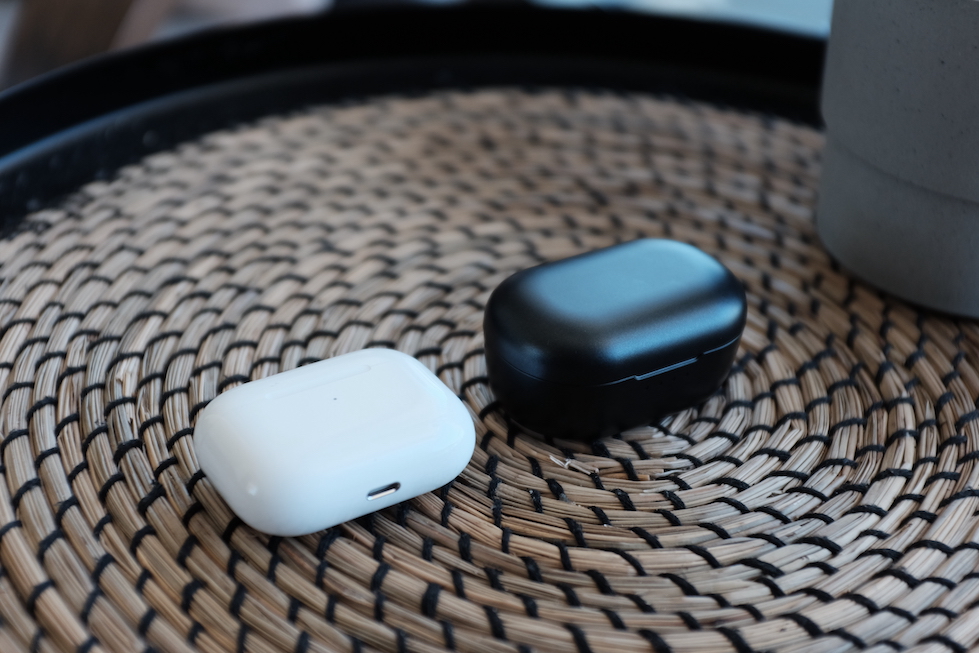
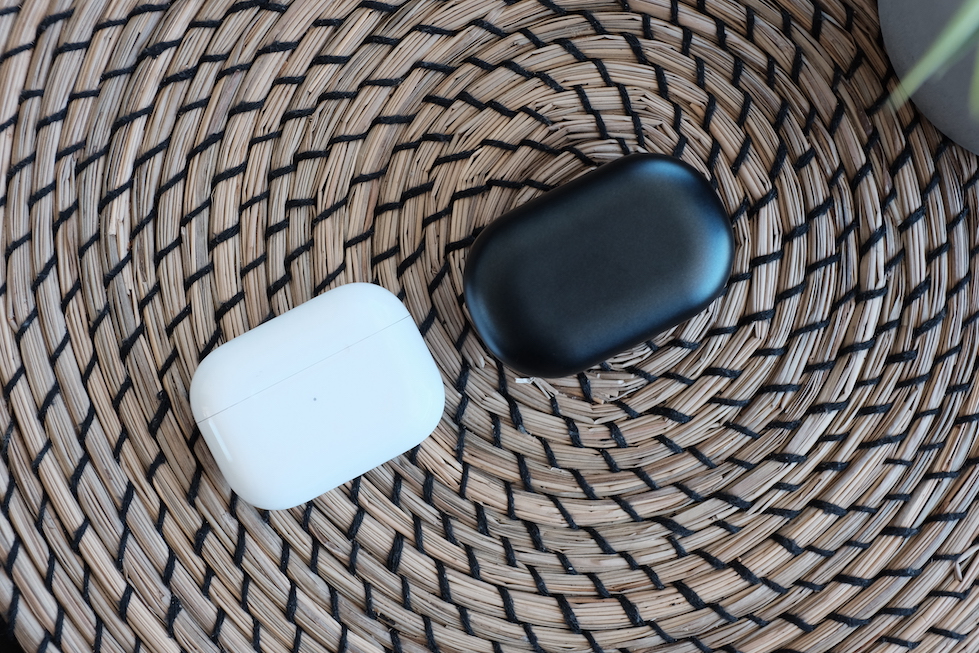
Let’s talk about the case. It is pretty simple. Some would even say it is cheap looking and feeling. I don’t mind, though I have complaints about the case design. Firstly, it is too thick to store comfortably in my trouser pocket (“is it an FW5 in your pocket, or are you happy to see me”). Secondly, I mistakenly kept trying to pry open the case from the hinge side due to the symmetric design. With the AirPods Pro, at least I can feel the coldness of the metal hinge in order to orient myself.
Within the app, you can also turn on “game mode” to reduce latency. You can also prevent FW5 from being fully charged to increase the longevity of the batteries (yes, batteries: one in each earpiece and a larger one in the case).
The Bluetooth connectivity of FW5 is quite decent. I can leave my iPhone in the living room when doing housework in the kitchen. I can put my phone in my pocket without worrying about arbitrary cut-offs that plague my BTR5 2019. However, I have seen complaints about poor Bluetooth reception. Because my unit is perfectly fine, we can conclude that the issue is not systemic. If you have connectivity issues, you should discuss them with Fiio for a solution.
There are some hiccups now and then. For instance, sometimes my phone connects to only one earpiece. Sometimes, the sound is 1 or 2 seconds behind YouTube videos. Sometimes, the connection drops randomly for a fraction of a second, even though the phone is in my hands. These minor issues highlight the difficulty of achieving the spotless experience of AirPods. However, given how good these IEMs sound, I find these issues manageable.
There is no active noise cancellation, meaning when you are on a very loud bus, for instance, the music would be drowned out. In most situations, even on a busy street, passive isolation of FW5 is adequate.
I’ll pitch FW5 against full-fledge wired IEMs powered by a proper desktop setup, my K7 DAC/amp combo. Moreover, I’ll pair FW5 with my iPhone via AAC. This pairing is a handicap to FW5 because AAC generally prevents Bluetooth DAC/amp from offering full fidelity and soundstage. My reason is simple: I want to see how a practical everyday carry setup competes against a purposely built setup for audio enjoyment.
Instead of “high brow” audiophile lossless recordings, let’s stick to the casual listening theme and use available music on YouTube. My belief is that if an audio chain is good, it should make everything you listen to sound good.
Noted that I use HS18 ear tips for these comparisons. These tips reduce the midbass of HS18 noticeably, giving a “tighter” bass response. Other tips can produce noticeably different impressions.
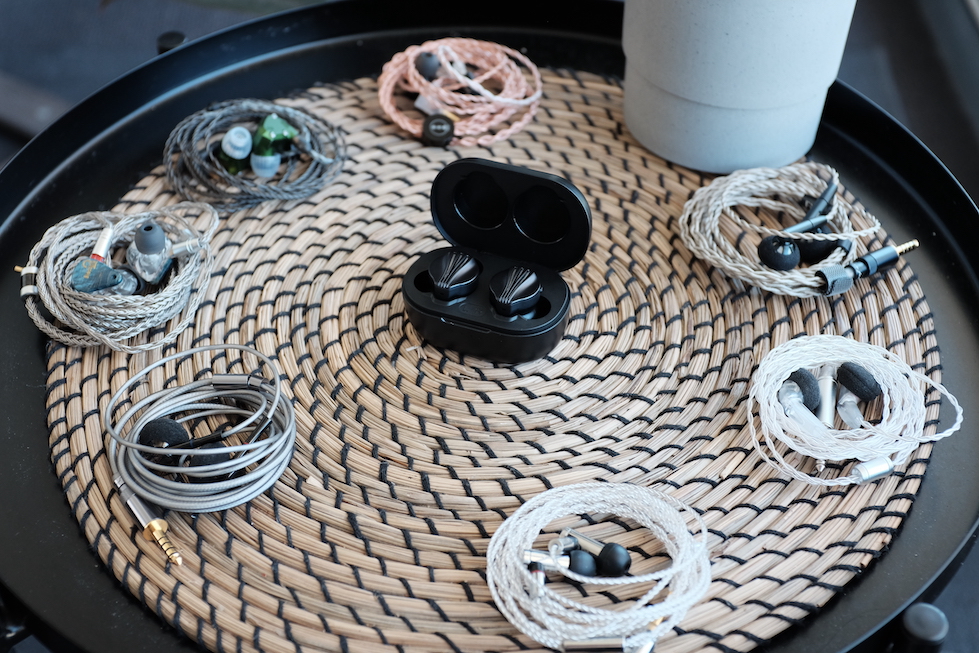
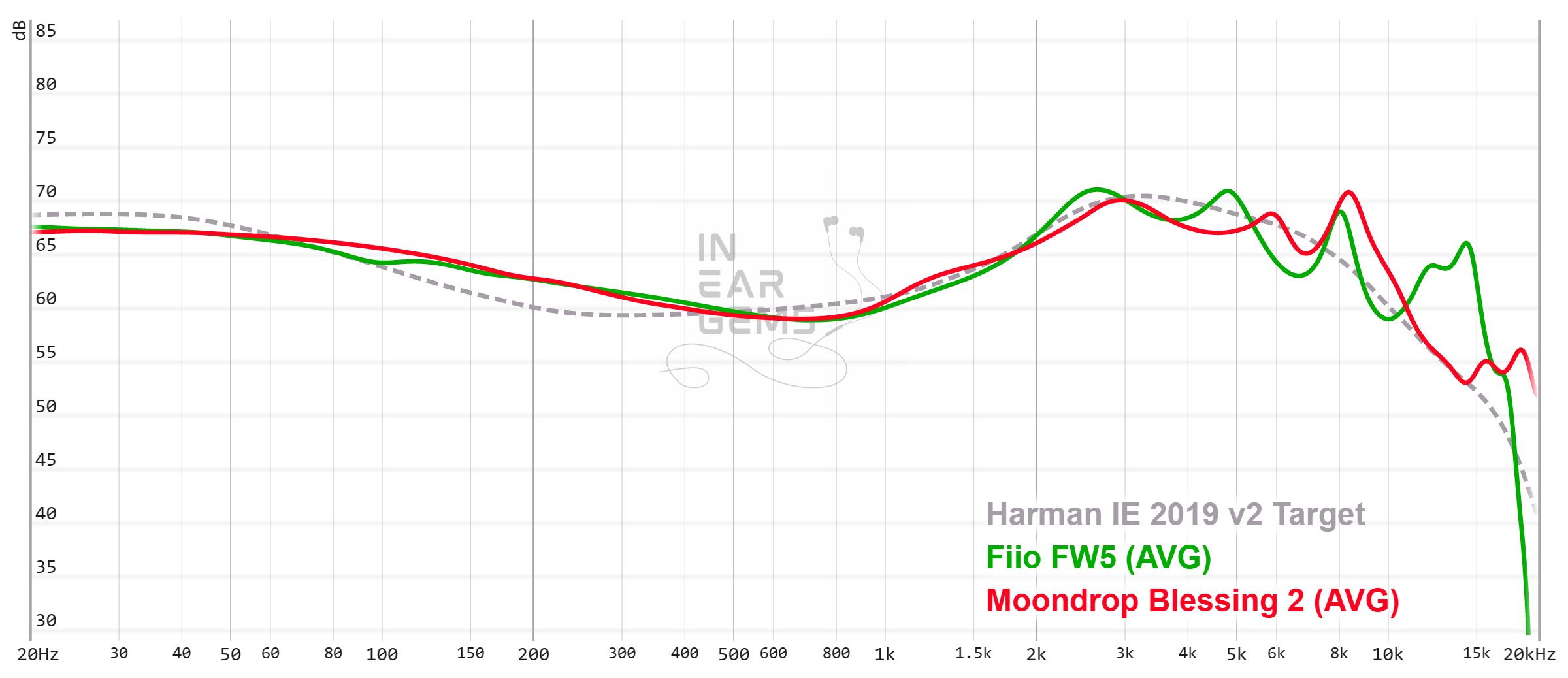
Tonality or “tuning” is where objectivity and subjectivity meet. Objectivity exists in the squiggly lines above, called Frequency Response (FR) graphs. They are created by sweeping a signal from 20Hz to 20kHz and measuring the corresponding loudness coming from an IEM. Unless a human operator deliberately tampers with the microphone or the data, FR does not care about the price or prestige of an IEM and, therefore, is “objective.”
However, human listeners are not microphones. Our ears and brain interpret the sound and decide whether it is “enjoyable.” It is also beneficial to remember that when you play a note on a musical instrument, multiple sounds (fundamental and harmonic) appear simultaneously and mix together. Achieving a life-like balance between frequencies and adding a tasteful amount of imbalance (“colouring the sound”) is the hallmark of an excellent tonality.
Enough with the theory. How does FW5 sound?
Classic Fiio’s single dynamic driver sound with a twist.
Let’s talk about the classic dynamic driver sound. Simply put, it’s a Harman-inspired sound with extra bass punch and warmth.Besides small wiggles between 2.5kHz and 10kHz, FW5 generally traces the Harman target with only one significant deviation: extra energy from 150Hz (the bass “punch” region) to around 3-400Hz (the “warmth” or “note thickness” region).
As FW5 traces Harman’s target decently well, it side-steps most tonality and timbre problems. I can try to give you some concrete indicators from recordings, but that wouldn’t add anything to the point that FW5 sounds correct. Vocals, bands, orchestras, electronic instruments. Everything sounds natural and realistic with an extra dose of warmth (some may say “musical”). The warmth is not overdone to the point of muddying the midrange.
The deviation of FW5 from the target in the lower frequencies removes that sense of detached bass and colder tonality of some IEMs, such as Monarch MkII. Instead, FW5 has a punchy bass and a vibrant midrange. It means you can hear the “boom boom” of the bass, not just the low-pitched “brrrr” rumble. Vocals and instruments have more bloom, warmth, and richness without being too muddy or unnatural.
Does that mean FW5 has “bass bleed”? In some sense, yes, because some vocals and instruments do feel a bit “denser” than in real life. But I would offer two points for consideration. Firstly, at no point does the midrange become muddy or masked by the “boom boom” from the bass. Secondly, FW5 matches Moondrop Blessing 2 exactly, measurement-wise, from 20Hz to 1kHz. Does Blessing 2 has “bass bleed”?

Let’s talk about the “twist.” I want to direct your attention to the peak in the air region, starting from 10kHz, where FW5’s BA drivers take over from the dynamic driver. Fans of the TIA technology from 64 Audio might recognise this peak and its benefits: highlighting micro-details such as room reverbs, enlarging the soundstage and giving it a “3D” illusion.
All of these benefits are here with FW5, with an unfortunate drawback: BA timbre. Some high notes can sound “scratchy” or “grainy”. It only happens sometimes. However, when a high-pitched note falls on the right part of the spectrum, you would scratch your head and say, “oh, that’s … odd?”
With all these praises, you would think I’m thoroughly pleased with FW5’s tonality. Oh no, my friends. I do have some bones to pick with Fiio: the “cat ear” tuning. The twin peaks at 2.5kHz and 5kHz, in particular.
What’s so wrong with this tuning?
It’s helpful to consider a visual example by thinking of a photo. You can see the edges of various shapes and objects, such as houses, cars, and people. The peaks at 2.5kHz and 5kHz act like sharpening filters for photos, which make all the edges more contrasty and noticeable, creating the illusion of “sharpness” or “resolution.” Abusing sharpening filters makes the images harsh, grainy, and unpleasant. It’s the same situation in the audio world. The “cat ear” tuning sharpens the initial attacks of vocals, string plucks, and stick impacts on the drums. When overused, the sharpening can lead to harshness and masking of fine details in music, some of which are carried in the 3-4kHz region.
Not to say that FW5 sounds artificially sharpened or harsh. In fact, the amount of “cat ear” was just to the point of giving FW5 some highlights and sparkles. However, FW5 lacks the smoothness and natural sense of detail in the midrange that I associate with “excellent” or “refined” tuning. For instance, when I listen to Survivor’s Eye of The Tiger, I can hear all the instruments and vocals clearly due to their crisp “edge”. Still, some fine details within the midrange are masked. I said “masked” because I can still hear textures in the voice and instruments, but I have to look for them or turn up the volume.
Conclusion? I consider FW5’s tuning as 4/5 - Good. I like the fact that it does not have tonal problems. I like the TIA-inspired treble tuning. I’m disappointed by the cat ears. If anything, the cat ears make FW5 sound a bit generic.

Resolution is a fascinating subject due to the difficulty of pinning what it really is. To me, “resolution” can be separated into “macro” and “micro” levels. The “macro resolution” is synonymous with instrument separation. In general, if note attacks are very crisp and precise, musical instruments in a song would be distinctive even when they overlap on the soundstage. The “micro resolution” dictates how many details you can hear at the note tails. Many IEMs are good at macro- but mediocre at micro-resolution. A few are vice versa.
FW5 is proficient at macro-resolution, meaning it renders complex and dense recordings such as One-winged Angel with a high degree of clarity, crispness and separation. All instruments have well-defined “edges”, making it easy for me to identify and follow them. Of course, a part of this advantage comes from the large soundstage that pushes instruments further from each other. However, FW5 is no slouch, even when instruments overlap in the mix. For instance, in the section from around 1:00 of One-winged Angel, when the whole orchestra plays together, I can still distinguish the instruments and hear the clarinets and flutes through the dense string section. When the choir comes in at around 1:22, I can hear voices, not just a blob of vocals.
FW5’s micro-resolution, unfortunately, is not as good as its macro-resolution. Let’s take Rasputin cover by Aurora as an example. FW5 does an outstanding job rendering elements of the mix, particularly the beautiful backing vocal. It’s easy to pinpoint and follow the backing vocal, a feat achieved by only some wired IEMs. However, I always feel that a small layer of detail and texture, the “breaths” in Aurora’s voice, is not highlighted enough. It is there, I can hear it if I pay attention, but it is masked by the “starting edge” of musical notes.
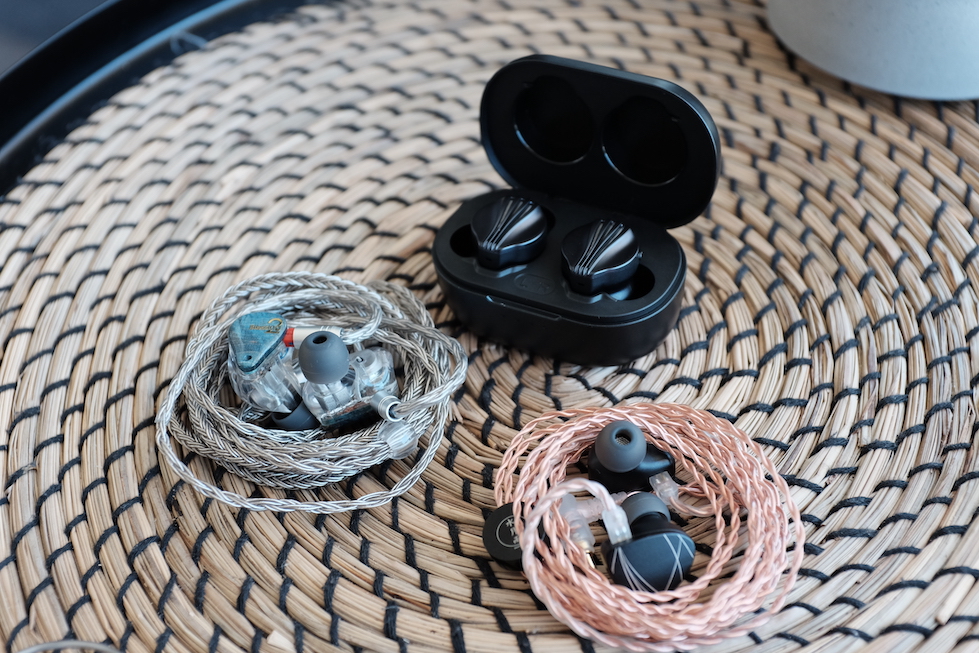
Alright, so FW5’s resolution is good. But how good? Let’s make some comparisons.
Firstly, let’s compare with Moondrop Aria (3/5 - Average), driven by a desktop rig. With the One-winged Angel, at first glance (listen), I said, “they are exactly the same.” But then, as the music gets denser, the Aria starts to fall behind with its slightly woolly fuzzy presentation. The difference reveals itself the clearest with the choir. The best way I can explain is to think of Aria as a 720p screen, whilst FW5 is a 1080p screen. At a glance, they are equally sharp. But if you spend more than a minute with them, you start to see the difference.
Secondly, let’s compare with Moondrop Blessing 2 (4/5 - Good), again, driven by a desktop rig. Now, we are talking! With One-winged Angel, I hear a nearly identical tonal balance. FW5 sounds slightly crisper and more separated. On the other hand, Blessing 2 does have a slight edge in micro-detail. For instance, there is a small detail of key pressing on the flute within the first 30 seconds of the track. Blessing 2 highlights this detail, whilst FW5 takes effort to detect.
The Rasputin cover by Aurora further highlights the difference between FW5 and Blessing 2. The TWS has a clear edge in macro-resolution, evidenced by the clarity of the backing vocal. Blessing 2 shows a clear advantage in micro-resolution, in the texture and breathiness of the vocals, right from the first words by Aurora.
In summary, I consider FW5’s resolution as 4/5 - Good. Even in a very unfavourable testing condition, the TWS traded blows with the venerable Blessing 2, the flag bearer of 4/5 resolution.
FW5’s bass carries the typical characteristics of Fiio dynamic driver IEMs, meaning abundant but manageable in quantity. In fact, its bass shelf is identical to that of Moondrop Blessing 2. There is a strong sense of sub-bass, meaning there is a sensation of physical rumble and power behind drum hits. The midbass is not neglected, so you would hear “boom boom” in your music rather than only feeling the rumble.
The bass quality is where FW5 pulls ahead of Blessing 2. Let’s take Eye of the Tiger by Survivor as an example. The difference between FW5 and Blessing 2 is immediately noticeable from 0:30 when both the kicks and the bass guitar started. The kicks have satisfying THUMPs. The start of kicks, when the beater hits the drum, is snappy rather than slightly soft and “slow”, like Blessing 2.
The most interesting difference, to me, is the bass guitar. Simply put, I have never been able to hear and distinguish the bass from the kick when I use my Andromeda, Blessing 2, and a few other “neutral” IEMs without mid-bass. But with FW5, I can detect the bass guitar and recognise the notes it plays. A good example is around 0:50.
On the other side of the spectrum, the cymbals and hi-hats cut through the mix cleanly. Perhaps a little bit too hot for me if I always listen to cymbals and hi-hats. I don’t, so a bit of sizzle is alright.

Conclusion? I would say FW5’s bass and percussion rendering is 4/5 - Good. Totally proper, totally correct, totally respectable. One step above the usual textureless woofers out there. But at the same time, it lacks a “special sauce” that makes me want to write long paragraphs to describe it. It’s simply “good.”

Stereo imaging or “soundstage” is a psychoacoustic illusion that different recording elements appear at various locations inside and around your head. Your brain creates based on the cues in the recording, which are enhanced or diminished by your IEMs, your DAC, and your amplifier. Some IEMs present a wide but flat soundstage. Some show a “3D” soundstage with layering, depth, and height. In rare cases, with some specific songs, some IEMs can trick you into thinking that the sound comes from the environment (a.k.a., “holographic”)
Open back design and TIA-like treble air. Unsurprisingly, FW5 performs mightily in both soundstage size and imaging accuracy.
Let’s take Vivaldi’s Winter performed by the Early Music ensemble Voices of Music, as an example. The FW5 places me at the front-most seat or even the conductor podium. The whole ensemble is spread around me, with a clear sense of depth and layering.For instance, the lute (guitar?) on the right side sounds closer to me than the cello at the back rather than on the same flat plane. When I closed my eyes and tried to forget that I was listening to a recording, I was somewhat convinced I was in a concert hall. (Somewhat. These are a nice pair of earphones, not a VR headset.)
Let’s compare it with Moondrop Blessing 2 (4/5 - Good). The venerable IEM can somewhat match the width of FW5’s soundstage. However, it is entirely outclassed by FW5’s depth and layering. For instance, FW5 renders the section from around 0:56 of Winter with the soloist standing closer to me. The orchestra forms a dome, further away and wrapping around the soloist. Blessing 2, on the other hand, puts everything on the same thin and dense plane. The illusion of being in a concert hall rarely appears with Blessing 2.
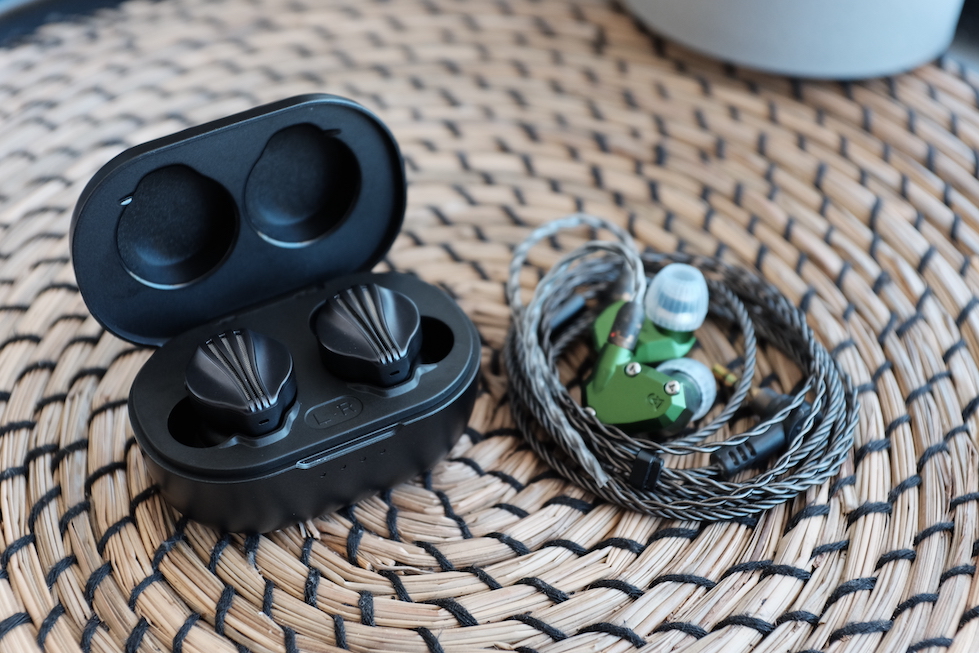
Let’s bring out the big gun, my Andromeda 2020 (5/5 - Excellent). The way Andromeda and FW5 place instruments on the soundstage are pretty similar. Both paint a 3D picture rather than a flat and wide soundstage. However, the Andromeda sounds more “real” due to its boomy and muddy tuning. For instance, cellos sound clean and clear with FW5 but boomy with Andromeda. Coincidentally, cellos don’t sound that clean in real life, at least at my local concert halls. So in some senses, Andromeda does a better job of tricking me into thinking I was in the hall. At the end of the day, I think it is a matter of preference. Both IEMs do a similar job at presenting a soundstage.
In conclusion, I rate FW5’s soundstage imaging 5/5 - Excellent. It does an outstanding job, not just “for the price” or “for a TWS.” It’s simply excellent.
My APP is equipped with comply foam tips. I also have set up the personalised spatial audio feature. Let me elaborate a bit for readers unfamiliar with APP. These devices have Active Noise Cancellation (ANC), which relies on microphones and signal processing to mix a “negative copy” of the noises around you into your music to cancel out the noises. Doing so can introduce different degrees of degradation to the sound quality. Therefore, in this test, I disabled the ANC.
Another nice feature of the APP is spatial audio. No, it’s not just about playing Dolby Atmos content. AirPods Pro can apply signal processing directly to any audio stream to extend the soundstage. The latest software version of AirPods Pro introduces a personalised spatial audio mode, in which you can use an iPhone camera to make a 3D scan of your face and ears so that the APP can adapt itself to your personal HRTF function. Does it work? Sometimes. In my case, APP EQs a bit extra upper midrange in addition to cross-feeding and other audio tricks.
Let’s take One-winged Angel as the example again for comparison. Tuning-wise, APP feels “hollower” than FW5, possibly due to some dip around 1kHz to extend the soundstage size. This hollowness does get annoying after a while.
However, the most annoying issue of the APP, to me, is the merely average resolution that it shows. Regardless of whether digital signal processing tricks are on or off, APP does not sound very crisp and detailed. For instance, FW5 renders the choir as a collection of voices. APP renders the choir as a blob of vocal sounds. In other words, it sounds like an Aria or similar IEMs at the 3/5 resolution level. FW5, on the other hand, trades blow with good performers like Blessing 2.
How is the soundstage? APP with spatial audio can sound larger sometimes. In some tracks, APP can sound like I left speakers on in my room. However, APP can also sound hollow and unnatural. Meanwhile, FW5 consistently sounds large but never triggers the uncanny feeling of APP.
Conclusion? I’m not too fond of the APP. I use FW5 daily when I cannot carry my DAP and wired IEMs. Or when I watch a few YouTube videos or a show.
However, many manufacturers see the writings on the wall.
If you have read the R&D stories of Fiio FW5, you can sense anxiety and pessimism. In some senses, Fiio’s worries are not totally unfounded from the perspective of a consumer product. The lack of LDAC is a contention point to some listeners (Though my A/B tests in this article show that even the inferior AAC codec did not have any issue). There were some reports of spotty Bluetooth connection. There are some usability hiccups, such as the insensitive volume buttons. The case could be thinner for improved pocketability.
However, looking at FW5 from an “audiophile” perspective shows a much more positive picture. Simply put, these are good-sounding IEMs. Tonality, though it could be further polished, is balanced and correct. The bass is taut and lively without overwhelming. The resolution is good. Soundstage imaging is top-notch. The value proposition of FW5 further heightens if we consider that this product replaces not just a pair of IEMs but also the dual-AKM DAC and amplifier sitting between your phones and the IEMs. If you are in situations where you can’t bring your DAP and wired IEM but want to keep the sweet, sweet head-fi sound quality, these FW5 are worth consideration.
Pros:

Updated: February 12, 2023
I must have spent much time listening to this incredible setup, right?
Not quite. Most of my listening in the last few weeks was done with a pair of True Wireless Stereo (TWS) IEMs from Fiio. And no, it was not just for writing this review.
Let’s talk about Fiio FW5.

Forewords
- This review is based on a review sample from Fiio (Thank you!). I have no affiliation with or financial interest in Fiio. FW5 retails for around AUD $250.
- You should treat this review as subjective impressions of an audio geek rather than an “objective truth” about the IEM. Your experience with any IEM would change depending on your DAC/AMP, music library, ear tips, and listening volume.
- I believe that great IEMs are the ones that can achieve multiple difficult things simultaneously: (1) high resolution (elements of a mix are crisp, easy to follow and full of texture), (2) 3D soundstage with a strong sense of layering and depth, (3) bold and natural bass, (4) natural timbre and balanced tonality that can work with any genre of music.
- I rate IEMs on the scale from 1 (poor) to 5 (outstanding). The scale centres around 3, indicating “average”, “adequate”, or “acceptable” performance. Scores are assigned by A/B tests against benchmark IEMs representing how each score band sounds.
- Ranking list and measurement database can be found on my IEM review blog.
Specs
- Driver: 1DD + 2BA
- Connector Type: Bluetooth
- DAC: 2 x AK4332
- Impedance: Unknown
- Sensitivity: Unknown
- Water resistance: IPX4
What is TWS anyway?
No, I’m not asking a profound question. I had an epiphany when wrapping up this review, so I wish to share it with you.We all know that TWS are Bluetooth IEMs that do not rely on any wire to connect with each other and a source device, such as your phone. So which wire, in particular, was removed by TWS?
I have always thought the removed wire is the IEM cable (you know, the copper or silver strings that divide this head-fi hobby into “believers” and “objectivists” camps). However, as I hold the FW5 in my hands, it suddenly dawns on me that it is not the electrical cable that was chopped off.
It is the digital cable (e.g., USB) connecting your phone with your audio chain, including DAC, amplifier, IEM cable, and IEMs. When you start music on your phone, the 1s and 0s are transmitted wirelessly via Bluetooth (rather than a USB cable) to the DAC chip within each earpiece. The DAC chips then transform the 1s and 0s into electrical signals. The built-in amplifiers make the signals larger to drive the speakers (drivers), delivering sound to your ears. Bluetooth codecs such as AAC and LDAC, then, can be considered the “quality” of the digital cable. One day, when Bluetooth can transmit as fast and as many 1s and 0s as USB cables, we will have wireless systems that behave exactly like wired setups.
In other words, when you hold a pair of TWS in your palm, you are holding a full-fledged portable setup, not just two earpieces with their wires chopped off. This, my friends, is an impressive feat of engineering (and perhaps why it has been so tricky for traditional IEM manufacturers to make decent TWS).
In the box


Fiio FW5 is a midrange entry (number 5 in the name) in the main product lines of Fiio (FW - Fiio Wireless). The packaging reflects this position. If you have seen any Fiio product, then you know the drill: thick cardboard box with holographic prints and logos, magnetic flaps, two layers of custom foam inserts holding the goodies, and an abundance of accessories.

FW5 comes with a nice USB-C cable, two cleaning tools, and two sets of ear tips.
Your choices of ear tips include the classic “balanced” silicone tips and the newly released HS18 tips. They change the sound and comfort noticeably, so I recommend trying them all. I personally settled for a pair of medium HS18 tips.

Let’s talk about the earpieces.
At a glance, it’s immediately apparent that Fiio draws inspiration from their iconic FD5 and FD7. According to Fiio, these IEMs are semi-open even though they have IPX4 water resistance. I can confirm that FW5 has a large and open soundstage, just like the FD and JD series IEMs.

Luckily, the rest of the earpieces is lightweight plastic rather than stainless steel, like FD5 and FD7. The part touching your ears has the same shape as the Apple EarPods, allowing the earpieces to lock into place against the concha of your ears. Instead of a simple opening like the EarPods, FW5 terminates with a medium-sized nozzle placed at an angle. By twisting the earpieces back and forth, you can angle the nozzle just right against your ear canal for a comfortable and secure fit.

There are two buttons on each earpiece, bringing to a total of four buttons. These can adjust the volume, control playback, accept phone calls, and invoke voice assistants.
I have a bone to pick with Fiio regarding the volume control. Simply put, the volume buttons are too insensitive. At first, I thought the volume control did not work due to some compatibility issues. And then, I realised that I needed to tap and hold the volume button a bit for the change to register, but not too long since FW5 would recognise a song skip request.
It should be noted that FW5 has independent volume control.It means that the volume buttons control how much FW5 amplifies the music. The system volume, such as on your phone, determines how loud the source music is for FW5 to amplify. Due to the issues with the volume buttons, I keep FW5’s internal volume at around 75% and use the phone to control the volume.


Let’s talk about the case. It is pretty simple. Some would even say it is cheap looking and feeling. I don’t mind, though I have complaints about the case design. Firstly, it is too thick to store comfortably in my trouser pocket (“is it an FW5 in your pocket, or are you happy to see me”). Secondly, I mistakenly kept trying to pry open the case from the hinge side due to the symmetric design. With the AirPods Pro, at least I can feel the coldness of the metal hinge in order to orient myself.
Software and connectivity
FW5 can be controlled by the same Fiio control application used for BTR5, BTR7, and other Fiio Bluetooth devices. The app is a bit clunky to use, but at least it has parametric EQ. As far as I know, this EQ profile is stored within the FW5, meaning EQ works with any source device. I consider this feature a big plus.Within the app, you can also turn on “game mode” to reduce latency. You can also prevent FW5 from being fully charged to increase the longevity of the batteries (yes, batteries: one in each earpiece and a larger one in the case).
The Bluetooth connectivity of FW5 is quite decent. I can leave my iPhone in the living room when doing housework in the kitchen. I can put my phone in my pocket without worrying about arbitrary cut-offs that plague my BTR5 2019. However, I have seen complaints about poor Bluetooth reception. Because my unit is perfectly fine, we can conclude that the issue is not systemic. If you have connectivity issues, you should discuss them with Fiio for a solution.
Usability
FW5 works as expected. When I open the lid, the earpieces connect. The earpieces disconnect when I put the back and close the cover. The TWS plays video without noticeable delays. It records voice with the same quality as the built-in microphone of my phone. It isolates as well as any semi-open IEM.There are some hiccups now and then. For instance, sometimes my phone connects to only one earpiece. Sometimes, the sound is 1 or 2 seconds behind YouTube videos. Sometimes, the connection drops randomly for a fraction of a second, even though the phone is in my hands. These minor issues highlight the difficulty of achieving the spotless experience of AirPods. However, given how good these IEMs sound, I find these issues manageable.
There is no active noise cancellation, meaning when you are on a very loud bus, for instance, the music would be drowned out. In most situations, even on a busy street, passive isolation of FW5 is adequate.
How it sounds
Let’s do something different and totally “unfair” in this review, shall we?I’ll pitch FW5 against full-fledge wired IEMs powered by a proper desktop setup, my K7 DAC/amp combo. Moreover, I’ll pair FW5 with my iPhone via AAC. This pairing is a handicap to FW5 because AAC generally prevents Bluetooth DAC/amp from offering full fidelity and soundstage. My reason is simple: I want to see how a practical everyday carry setup competes against a purposely built setup for audio enjoyment.
Instead of “high brow” audiophile lossless recordings, let’s stick to the casual listening theme and use available music on YouTube. My belief is that if an audio chain is good, it should make everything you listen to sound good.
Noted that I use HS18 ear tips for these comparisons. These tips reduce the midbass of HS18 noticeably, giving a “tighter” bass response. Other tips can produce noticeably different impressions.

Tonality and Timbre: 4/5 - Good
Frequency response of FW5 against Blessing 2 and the Harman in-ear target. Measurements were done with an IEC-711-compliant coupler and might only be compared with other measurements from this same coupler. Visit my graph database for more comparisons.
Tonality or “tuning” is where objectivity and subjectivity meet. Objectivity exists in the squiggly lines above, called Frequency Response (FR) graphs. They are created by sweeping a signal from 20Hz to 20kHz and measuring the corresponding loudness coming from an IEM. Unless a human operator deliberately tampers with the microphone or the data, FR does not care about the price or prestige of an IEM and, therefore, is “objective.”
However, human listeners are not microphones. Our ears and brain interpret the sound and decide whether it is “enjoyable.” It is also beneficial to remember that when you play a note on a musical instrument, multiple sounds (fundamental and harmonic) appear simultaneously and mix together. Achieving a life-like balance between frequencies and adding a tasteful amount of imbalance (“colouring the sound”) is the hallmark of an excellent tonality.
Enough with the theory. How does FW5 sound?
Classic Fiio’s single dynamic driver sound with a twist.
Let’s talk about the classic dynamic driver sound. Simply put, it’s a Harman-inspired sound with extra bass punch and warmth.Besides small wiggles between 2.5kHz and 10kHz, FW5 generally traces the Harman target with only one significant deviation: extra energy from 150Hz (the bass “punch” region) to around 3-400Hz (the “warmth” or “note thickness” region).
As FW5 traces Harman’s target decently well, it side-steps most tonality and timbre problems. I can try to give you some concrete indicators from recordings, but that wouldn’t add anything to the point that FW5 sounds correct. Vocals, bands, orchestras, electronic instruments. Everything sounds natural and realistic with an extra dose of warmth (some may say “musical”). The warmth is not overdone to the point of muddying the midrange.
The deviation of FW5 from the target in the lower frequencies removes that sense of detached bass and colder tonality of some IEMs, such as Monarch MkII. Instead, FW5 has a punchy bass and a vibrant midrange. It means you can hear the “boom boom” of the bass, not just the low-pitched “brrrr” rumble. Vocals and instruments have more bloom, warmth, and richness without being too muddy or unnatural.
Does that mean FW5 has “bass bleed”? In some sense, yes, because some vocals and instruments do feel a bit “denser” than in real life. But I would offer two points for consideration. Firstly, at no point does the midrange become muddy or masked by the “boom boom” from the bass. Secondly, FW5 matches Moondrop Blessing 2 exactly, measurement-wise, from 20Hz to 1kHz. Does Blessing 2 has “bass bleed”?

Let’s talk about the “twist.” I want to direct your attention to the peak in the air region, starting from 10kHz, where FW5’s BA drivers take over from the dynamic driver. Fans of the TIA technology from 64 Audio might recognise this peak and its benefits: highlighting micro-details such as room reverbs, enlarging the soundstage and giving it a “3D” illusion.
All of these benefits are here with FW5, with an unfortunate drawback: BA timbre. Some high notes can sound “scratchy” or “grainy”. It only happens sometimes. However, when a high-pitched note falls on the right part of the spectrum, you would scratch your head and say, “oh, that’s … odd?”
With all these praises, you would think I’m thoroughly pleased with FW5’s tonality. Oh no, my friends. I do have some bones to pick with Fiio: the “cat ear” tuning. The twin peaks at 2.5kHz and 5kHz, in particular.
What’s so wrong with this tuning?
It’s helpful to consider a visual example by thinking of a photo. You can see the edges of various shapes and objects, such as houses, cars, and people. The peaks at 2.5kHz and 5kHz act like sharpening filters for photos, which make all the edges more contrasty and noticeable, creating the illusion of “sharpness” or “resolution.” Abusing sharpening filters makes the images harsh, grainy, and unpleasant. It’s the same situation in the audio world. The “cat ear” tuning sharpens the initial attacks of vocals, string plucks, and stick impacts on the drums. When overused, the sharpening can lead to harshness and masking of fine details in music, some of which are carried in the 3-4kHz region.
Not to say that FW5 sounds artificially sharpened or harsh. In fact, the amount of “cat ear” was just to the point of giving FW5 some highlights and sparkles. However, FW5 lacks the smoothness and natural sense of detail in the midrange that I associate with “excellent” or “refined” tuning. For instance, when I listen to Survivor’s Eye of The Tiger, I can hear all the instruments and vocals clearly due to their crisp “edge”. Still, some fine details within the midrange are masked. I said “masked” because I can still hear textures in the voice and instruments, but I have to look for them or turn up the volume.
Conclusion? I consider FW5’s tuning as 4/5 - Good. I like the fact that it does not have tonal problems. I like the TIA-inspired treble tuning. I’m disappointed by the cat ears. If anything, the cat ears make FW5 sound a bit generic.
Resolution, Detail, Separation: 4/5 - Good

Resolution is a fascinating subject due to the difficulty of pinning what it really is. To me, “resolution” can be separated into “macro” and “micro” levels. The “macro resolution” is synonymous with instrument separation. In general, if note attacks are very crisp and precise, musical instruments in a song would be distinctive even when they overlap on the soundstage. The “micro resolution” dictates how many details you can hear at the note tails. Many IEMs are good at macro- but mediocre at micro-resolution. A few are vice versa.
FW5 is proficient at macro-resolution, meaning it renders complex and dense recordings such as One-winged Angel with a high degree of clarity, crispness and separation. All instruments have well-defined “edges”, making it easy for me to identify and follow them. Of course, a part of this advantage comes from the large soundstage that pushes instruments further from each other. However, FW5 is no slouch, even when instruments overlap in the mix. For instance, in the section from around 1:00 of One-winged Angel, when the whole orchestra plays together, I can still distinguish the instruments and hear the clarinets and flutes through the dense string section. When the choir comes in at around 1:22, I can hear voices, not just a blob of vocals.
FW5’s micro-resolution, unfortunately, is not as good as its macro-resolution. Let’s take Rasputin cover by Aurora as an example. FW5 does an outstanding job rendering elements of the mix, particularly the beautiful backing vocal. It’s easy to pinpoint and follow the backing vocal, a feat achieved by only some wired IEMs. However, I always feel that a small layer of detail and texture, the “breaths” in Aurora’s voice, is not highlighted enough. It is there, I can hear it if I pay attention, but it is masked by the “starting edge” of musical notes.

Alright, so FW5’s resolution is good. But how good? Let’s make some comparisons.
Firstly, let’s compare with Moondrop Aria (3/5 - Average), driven by a desktop rig. With the One-winged Angel, at first glance (listen), I said, “they are exactly the same.” But then, as the music gets denser, the Aria starts to fall behind with its slightly woolly fuzzy presentation. The difference reveals itself the clearest with the choir. The best way I can explain is to think of Aria as a 720p screen, whilst FW5 is a 1080p screen. At a glance, they are equally sharp. But if you spend more than a minute with them, you start to see the difference.
Secondly, let’s compare with Moondrop Blessing 2 (4/5 - Good), again, driven by a desktop rig. Now, we are talking! With One-winged Angel, I hear a nearly identical tonal balance. FW5 sounds slightly crisper and more separated. On the other hand, Blessing 2 does have a slight edge in micro-detail. For instance, there is a small detail of key pressing on the flute within the first 30 seconds of the track. Blessing 2 highlights this detail, whilst FW5 takes effort to detect.
The Rasputin cover by Aurora further highlights the difference between FW5 and Blessing 2. The TWS has a clear edge in macro-resolution, evidenced by the clarity of the backing vocal. Blessing 2 shows a clear advantage in micro-resolution, in the texture and breathiness of the vocals, right from the first words by Aurora.
In summary, I consider FW5’s resolution as 4/5 - Good. Even in a very unfavourable testing condition, the TWS traded blows with the venerable Blessing 2, the flag bearer of 4/5 resolution.
Percussion and Bass: 4/5 - Good
Percussion and bass rendering reflect how well the tuning and technical performance of an IEM work together to recreate realistic sound of drum sets and bass instruments. Good drum hits have a crisp attack (controlled by frequencies from 4kHz to 6kHz), full body (midbass frequencies around 200Hz), and physical sensation (sub-bass frequencies around 50Hz). Good technical performance (“fast” driver) ensures that bass notes can be loud yet detailed. IEMs that cannot control bass very well tend to reduce the bass’ loudness to prevent muddiness.FW5’s bass carries the typical characteristics of Fiio dynamic driver IEMs, meaning abundant but manageable in quantity. In fact, its bass shelf is identical to that of Moondrop Blessing 2. There is a strong sense of sub-bass, meaning there is a sensation of physical rumble and power behind drum hits. The midbass is not neglected, so you would hear “boom boom” in your music rather than only feeling the rumble.
The bass quality is where FW5 pulls ahead of Blessing 2. Let’s take Eye of the Tiger by Survivor as an example. The difference between FW5 and Blessing 2 is immediately noticeable from 0:30 when both the kicks and the bass guitar started. The kicks have satisfying THUMPs. The start of kicks, when the beater hits the drum, is snappy rather than slightly soft and “slow”, like Blessing 2.
The most interesting difference, to me, is the bass guitar. Simply put, I have never been able to hear and distinguish the bass from the kick when I use my Andromeda, Blessing 2, and a few other “neutral” IEMs without mid-bass. But with FW5, I can detect the bass guitar and recognise the notes it plays. A good example is around 0:50.
On the other side of the spectrum, the cymbals and hi-hats cut through the mix cleanly. Perhaps a little bit too hot for me if I always listen to cymbals and hi-hats. I don’t, so a bit of sizzle is alright.

Conclusion? I would say FW5’s bass and percussion rendering is 4/5 - Good. Totally proper, totally correct, totally respectable. One step above the usual textureless woofers out there. But at the same time, it lacks a “special sauce” that makes me want to write long paragraphs to describe it. It’s simply “good.”
Stereo Imaging (Soundstage): 5/5 - Excellent

Stereo imaging or “soundstage” is a psychoacoustic illusion that different recording elements appear at various locations inside and around your head. Your brain creates based on the cues in the recording, which are enhanced or diminished by your IEMs, your DAC, and your amplifier. Some IEMs present a wide but flat soundstage. Some show a “3D” soundstage with layering, depth, and height. In rare cases, with some specific songs, some IEMs can trick you into thinking that the sound comes from the environment (a.k.a., “holographic”)
Open back design and TIA-like treble air. Unsurprisingly, FW5 performs mightily in both soundstage size and imaging accuracy.
Let’s take Vivaldi’s Winter performed by the Early Music ensemble Voices of Music, as an example. The FW5 places me at the front-most seat or even the conductor podium. The whole ensemble is spread around me, with a clear sense of depth and layering.For instance, the lute (guitar?) on the right side sounds closer to me than the cello at the back rather than on the same flat plane. When I closed my eyes and tried to forget that I was listening to a recording, I was somewhat convinced I was in a concert hall. (Somewhat. These are a nice pair of earphones, not a VR headset.)
Let’s compare it with Moondrop Blessing 2 (4/5 - Good). The venerable IEM can somewhat match the width of FW5’s soundstage. However, it is entirely outclassed by FW5’s depth and layering. For instance, FW5 renders the section from around 0:56 of Winter with the soloist standing closer to me. The orchestra forms a dome, further away and wrapping around the soloist. Blessing 2, on the other hand, puts everything on the same thin and dense plane. The illusion of being in a concert hall rarely appears with Blessing 2.

Let’s bring out the big gun, my Andromeda 2020 (5/5 - Excellent). The way Andromeda and FW5 place instruments on the soundstage are pretty similar. Both paint a 3D picture rather than a flat and wide soundstage. However, the Andromeda sounds more “real” due to its boomy and muddy tuning. For instance, cellos sound clean and clear with FW5 but boomy with Andromeda. Coincidentally, cellos don’t sound that clean in real life, at least at my local concert halls. So in some senses, Andromeda does a better job of tricking me into thinking I was in the hall. At the end of the day, I think it is a matter of preference. Both IEMs do a similar job at presenting a soundstage.
In conclusion, I rate FW5’s soundstage imaging 5/5 - Excellent. It does an outstanding job, not just “for the price” or “for a TWS.” It’s simply excellent.
Some Comparisons
In this section, I compare FW5 with the only other TWS in my collection: the mighty Apple AirPods Pro (APP). You can use my ranking list to compare FW5 with others. Due to how I rank IEMs, if two IEMs score the same, they perform more or less similarly.My APP is equipped with comply foam tips. I also have set up the personalised spatial audio feature. Let me elaborate a bit for readers unfamiliar with APP. These devices have Active Noise Cancellation (ANC), which relies on microphones and signal processing to mix a “negative copy” of the noises around you into your music to cancel out the noises. Doing so can introduce different degrees of degradation to the sound quality. Therefore, in this test, I disabled the ANC.
Another nice feature of the APP is spatial audio. No, it’s not just about playing Dolby Atmos content. AirPods Pro can apply signal processing directly to any audio stream to extend the soundstage. The latest software version of AirPods Pro introduces a personalised spatial audio mode, in which you can use an iPhone camera to make a 3D scan of your face and ears so that the APP can adapt itself to your personal HRTF function. Does it work? Sometimes. In my case, APP EQs a bit extra upper midrange in addition to cross-feeding and other audio tricks.
Let’s take One-winged Angel as the example again for comparison. Tuning-wise, APP feels “hollower” than FW5, possibly due to some dip around 1kHz to extend the soundstage size. This hollowness does get annoying after a while.
However, the most annoying issue of the APP, to me, is the merely average resolution that it shows. Regardless of whether digital signal processing tricks are on or off, APP does not sound very crisp and detailed. For instance, FW5 renders the choir as a collection of voices. APP renders the choir as a blob of vocal sounds. In other words, it sounds like an Aria or similar IEMs at the 3/5 resolution level. FW5, on the other hand, trades blow with good performers like Blessing 2.
How is the soundstage? APP with spatial audio can sound larger sometimes. In some tracks, APP can sound like I left speakers on in my room. However, APP can also sound hollow and unnatural. Meanwhile, FW5 consistently sounds large but never triggers the uncanny feeling of APP.
Conclusion? I’m not too fond of the APP. I use FW5 daily when I cannot carry my DAP and wired IEMs. Or when I watch a few YouTube videos or a show.
Conclusion
Is there much life left in the portable “audiophile” market? For fans like me and you, we would love to respond with a resounding “YES.”However, many manufacturers see the writings on the wall.
If you have read the R&D stories of Fiio FW5, you can sense anxiety and pessimism. In some senses, Fiio’s worries are not totally unfounded from the perspective of a consumer product. The lack of LDAC is a contention point to some listeners (Though my A/B tests in this article show that even the inferior AAC codec did not have any issue). There were some reports of spotty Bluetooth connection. There are some usability hiccups, such as the insensitive volume buttons. The case could be thinner for improved pocketability.
However, looking at FW5 from an “audiophile” perspective shows a much more positive picture. Simply put, these are good-sounding IEMs. Tonality, though it could be further polished, is balanced and correct. The bass is taut and lively without overwhelming. The resolution is good. Soundstage imaging is top-notch. The value proposition of FW5 further heightens if we consider that this product replaces not just a pair of IEMs but also the dual-AKM DAC and amplifier sitting between your phones and the IEMs. If you are in situations where you can’t bring your DAP and wired IEM but want to keep the sweet, sweet head-fi sound quality, these FW5 are worth consideration.
Pros:
- Large, open, 3D soundstage
- Punchy but controlled bass and percussions
- Excellent instrument separation
- Tonally correct
- Stable connection
- Parametric EQ
- Thick case
- Volume buttons borderline unusable
- Micro details are merely good
- Somewhat generic tuning due to the twin peaks at 2kHz and 5kHz
- No LDAC support (yet)

Updated: February 12, 2023
Last edited:
View previous replies…
o0genesis0o
@Bay Jingles no one beats apple in terms of seamless user experience on iphone. I have to go with airpods pro 2.
B
Bay Jingles
The reason I am interested in this headset is, as you know, the sound quality. Is APP2 incomparably worse in terms of sound quality?
o0genesis0o
APP1 is worse. I haven’t heard APP2 but impressions I got from others it that it’s a big improvement.
Moonstar
100+ Head-Fier
Pros: Versatile Sound Tuning,
Airy & Spacious Atmosphere,
Powerful and Clean Output (AK4332 DAC Chip + QCC 5141 BT SoC),
Very Stabile Connection with Low Latency,
LHDC BT Codec Support,
IPX4,
FiiO APP Control,
Good Value for your Money
Airy & Spacious Atmosphere,
Powerful and Clean Output (AK4332 DAC Chip + QCC 5141 BT SoC),
Very Stabile Connection with Low Latency,
LHDC BT Codec Support,
IPX4,
FiiO APP Control,
Good Value for your Money
Cons: No LDAC support (may come with a further FW update),
No Active Noise Cancellation,
No Touch Controls (a matter of preference)
No Active Noise Cancellation,
No Touch Controls (a matter of preference)
FiiO FW5 TWS IEM Review
Introduction:
FiiO FW5 is the brand new True Wireless (TWS) earphone of the company with a 2BA + 1DD Hybrid Driver configuration that has some pretty interesting features such like an independent AK4332 DAC chipset, Qualcomm QC5141 Bluetooth SoC with LHDC, AptX Adaptive codec support, IPX4 Water Resistance, up to 7hours of battery life and many more.
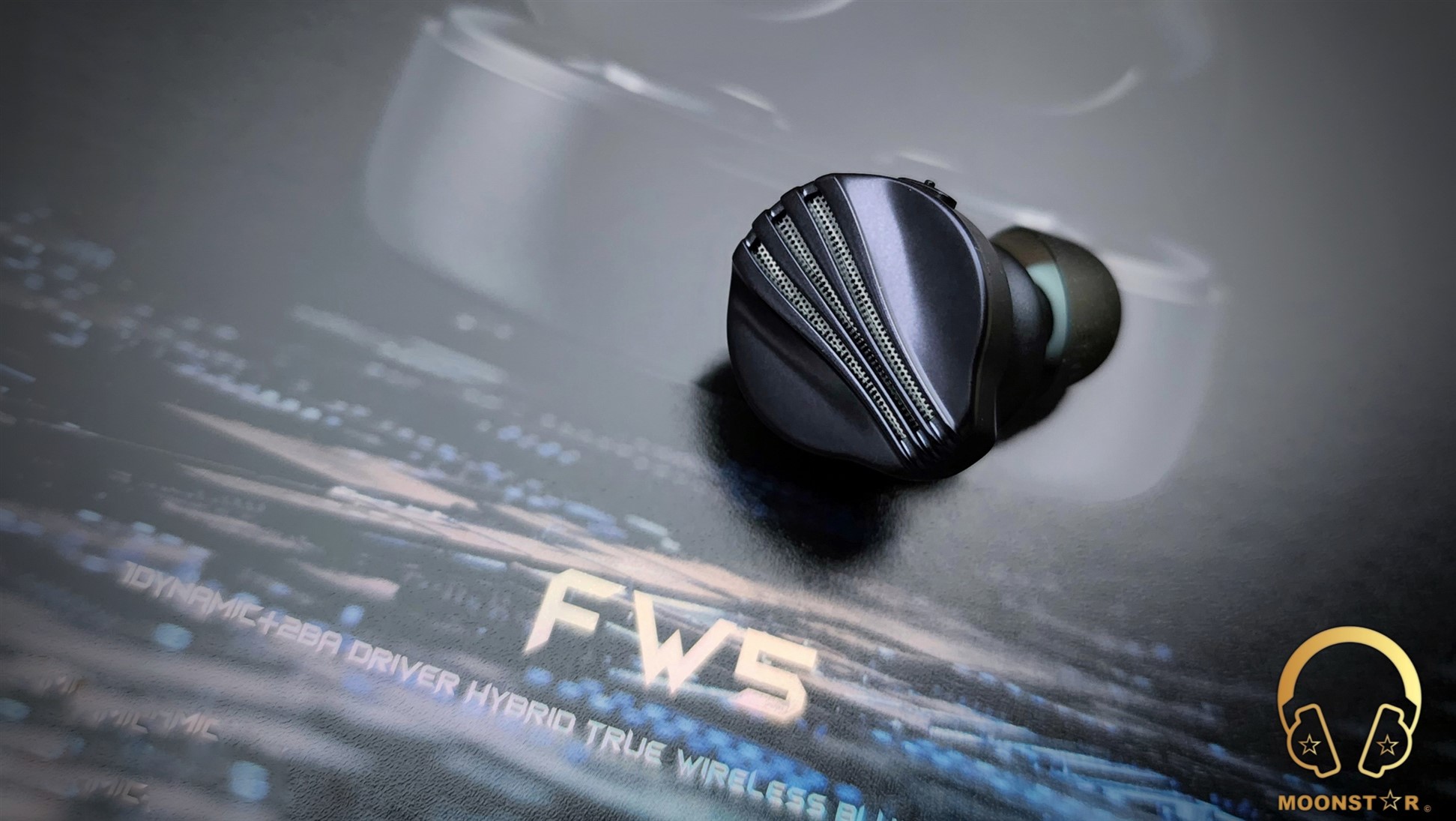
Disclaimer:
I would like to thank FiiO for providing me the FW5 TWS Earphone for review purposes. I am not affiliated with FiiO beyond this review and these words reflect my true and unaltered opinions about the product.
Price & Availability:
The actual price for the FiiO FW5 TWS Earphone is 134.99 US$. More information’s can be found under the link below;
Package & Accessories:
The black rectangular box with the illustration of the FiiO FW5 looks pretty nice. This box reflects the companies new design language for the presentation of their latest products.
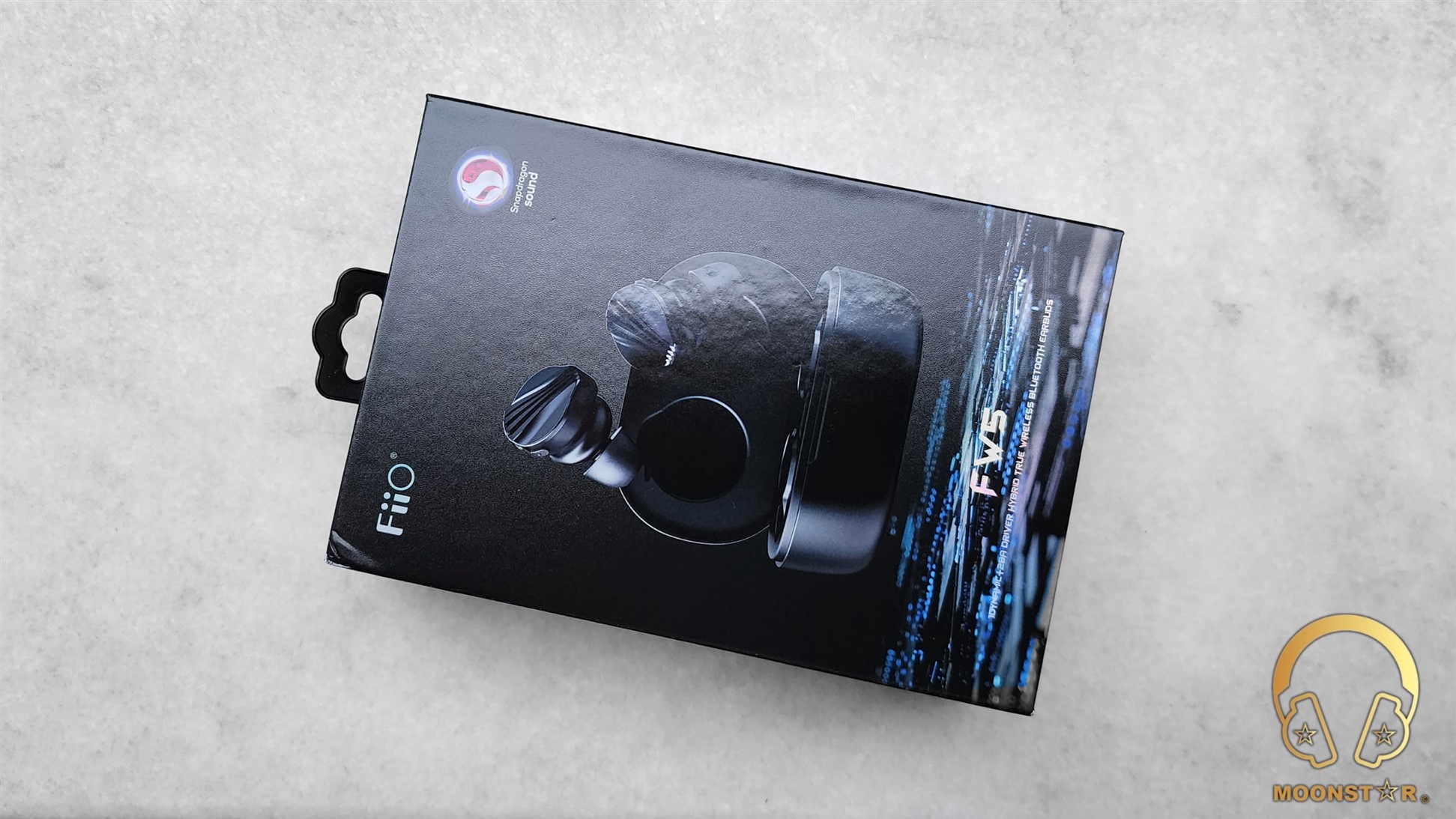
This box contains the following items/accessories;
- 1x pair of FiiO FW5 TWS Earphones
- 1x Charging Case
- 3x pairs of FiiO HS18 Silicone Ear Tips (S/M/L)
- 3x pairs of Balanced Silicone Ear Tips (S/M/L)
- 1x Cleaning Tool
- 1x Cleaning Brush
- 1x USB Type-C Charging Cable
- 1x Print Material (User Manual, Quick Start Guide, Warranty Card)
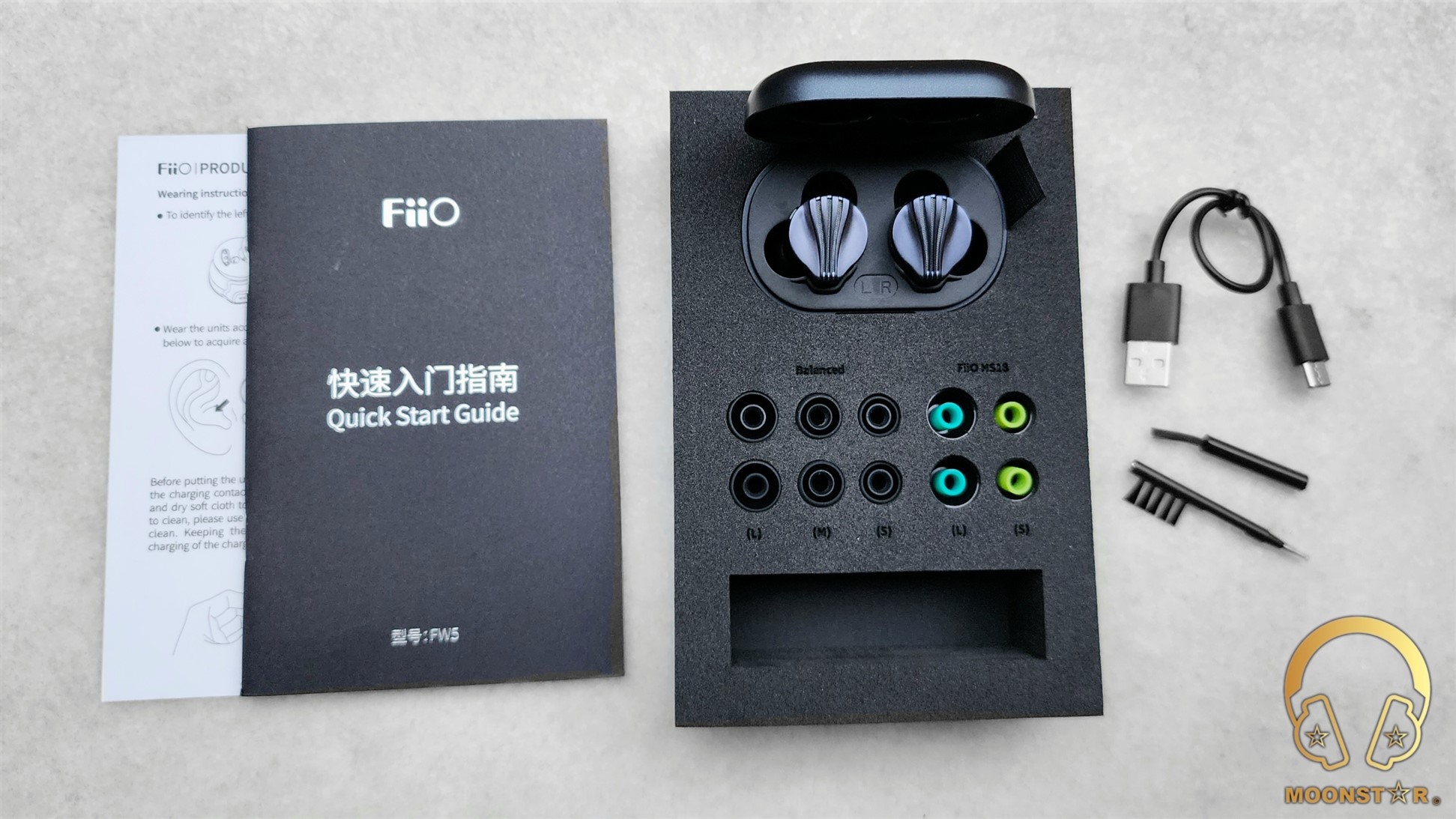

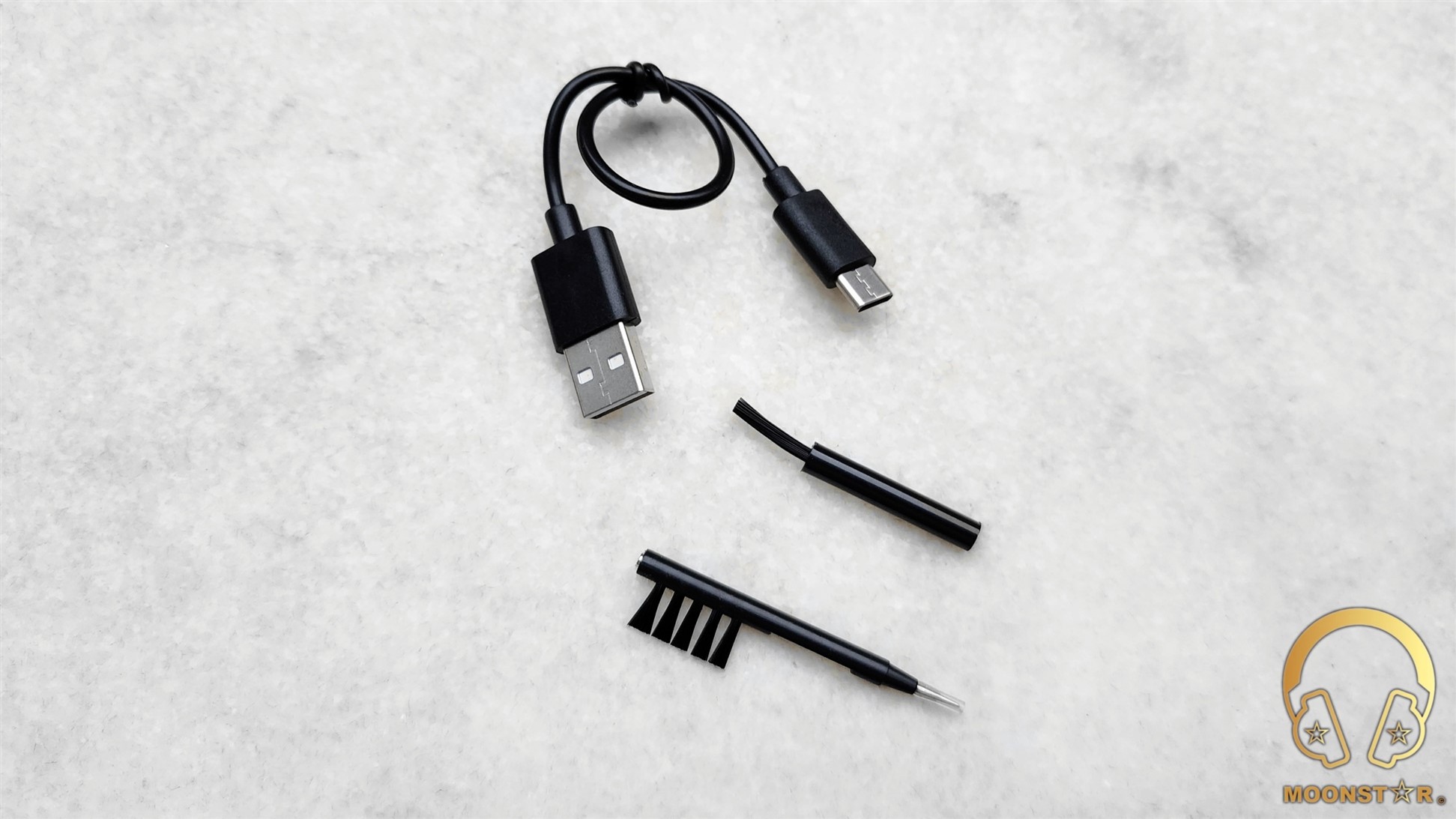
Design & Build Quality:
The FiiO FW5 is a very esthetic looking True Wireless (TWS) earphone that shows an excellent build quality same like all previous products I have tested of the company. Each of the monitor features a Hybrid Driver configuration, which is a combination of 2x Balanced Armature Drivers + 1x 10mm dia. DLC Diaphragm Dynamic Driver with a PU gasket. The 10mm Dynamic Driver is responsible for the Lows and Mids, while the two Knowles BA Drivers are dedicated for the Highs.
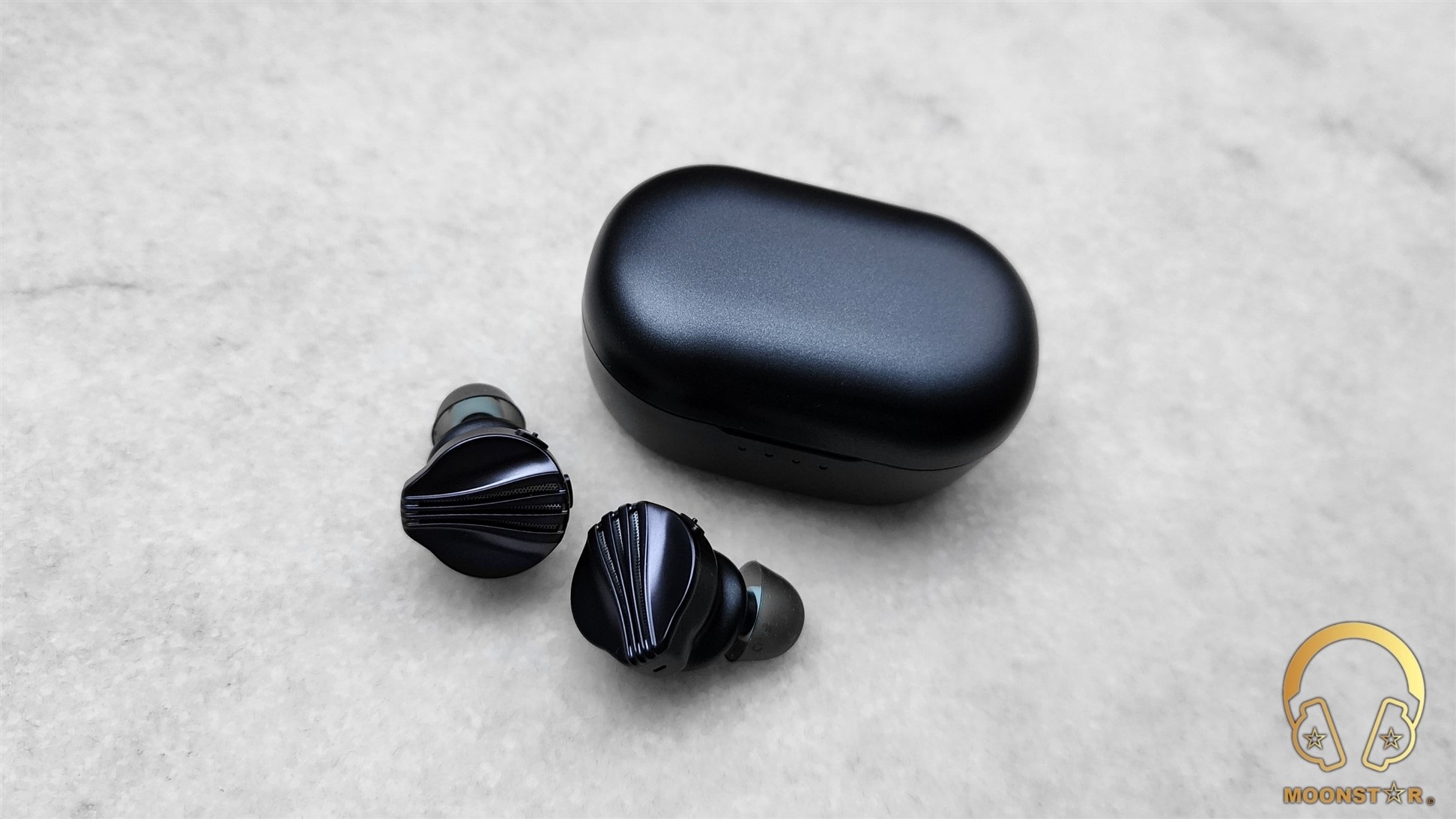
The faceplate has a gorgeous design that looks similar to the one that was found on the FD7 flagship In-Ear Monitor of the company. The rear surface of the faceplate is equipped with multiple components such like an air guiding mesh, followed by a water-resistant sound-permeable cotton part and a FPC antenna.
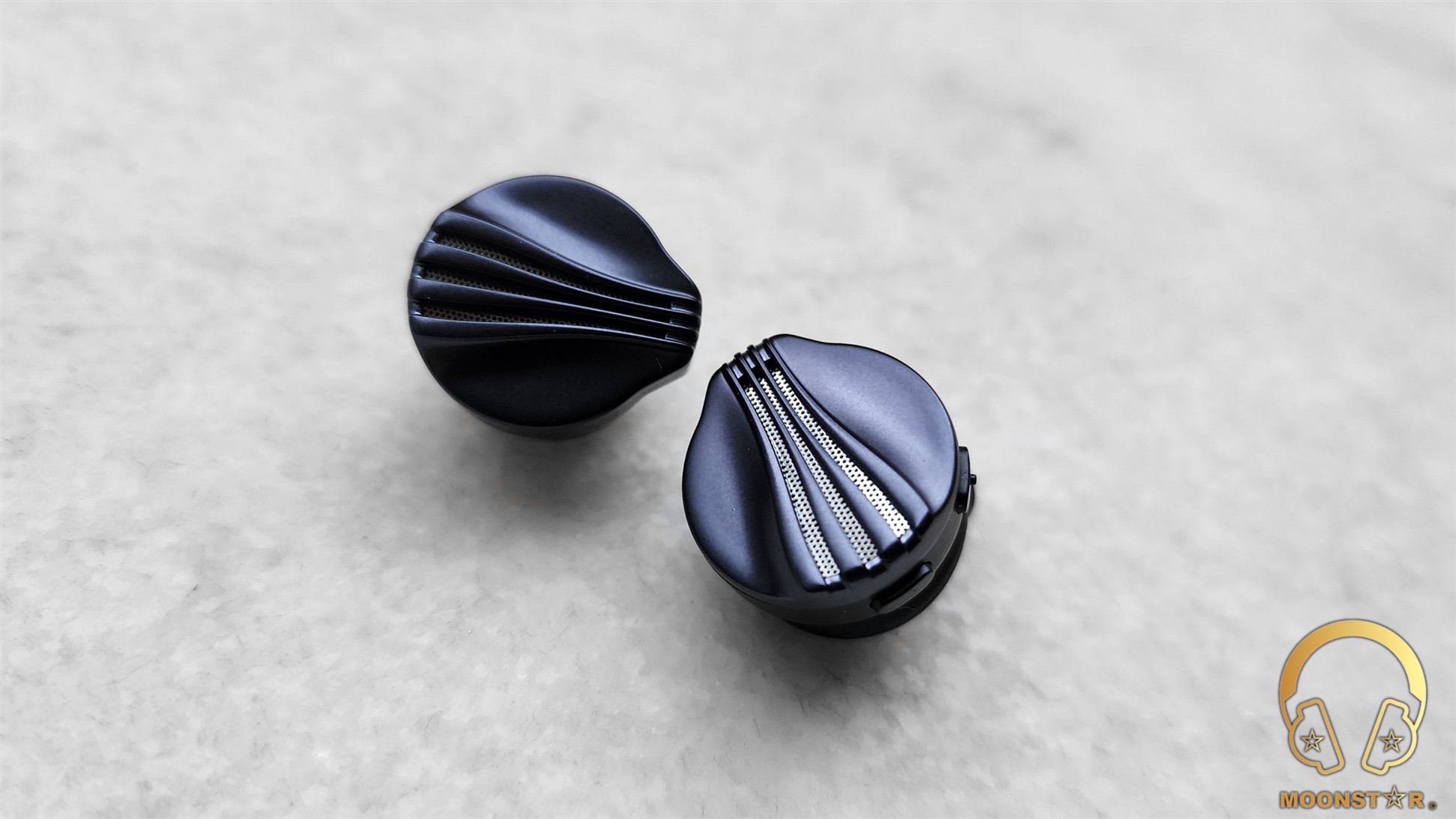
The faceplate with a semi open back design and the has a small LED light status indicator behind it.
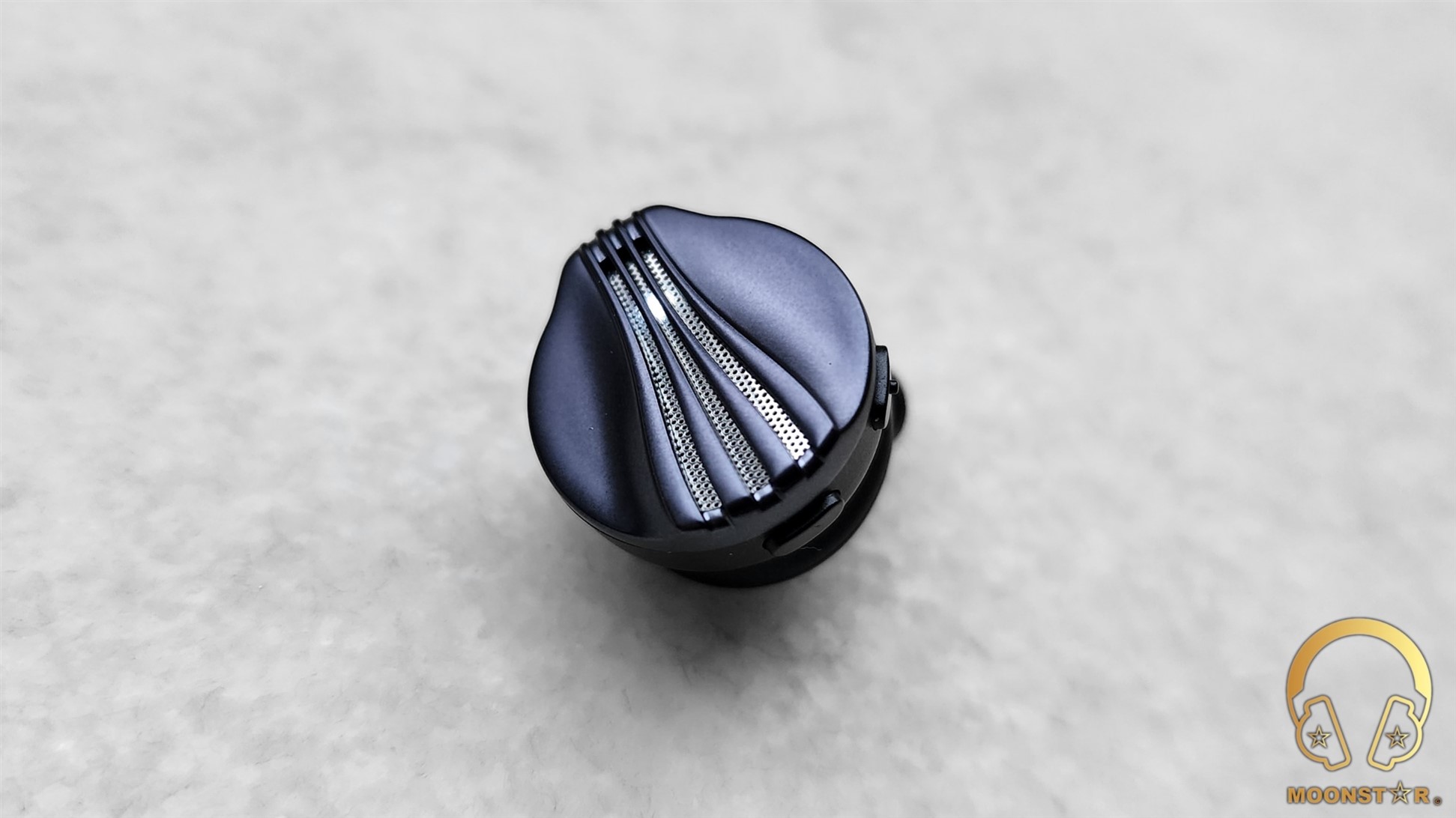
On the top of each ear piece are two multifunctional buttons one for volume, track, reset, etc. while the other button is dedicated for power on/off, activation of voice assistance, call answer, etc.
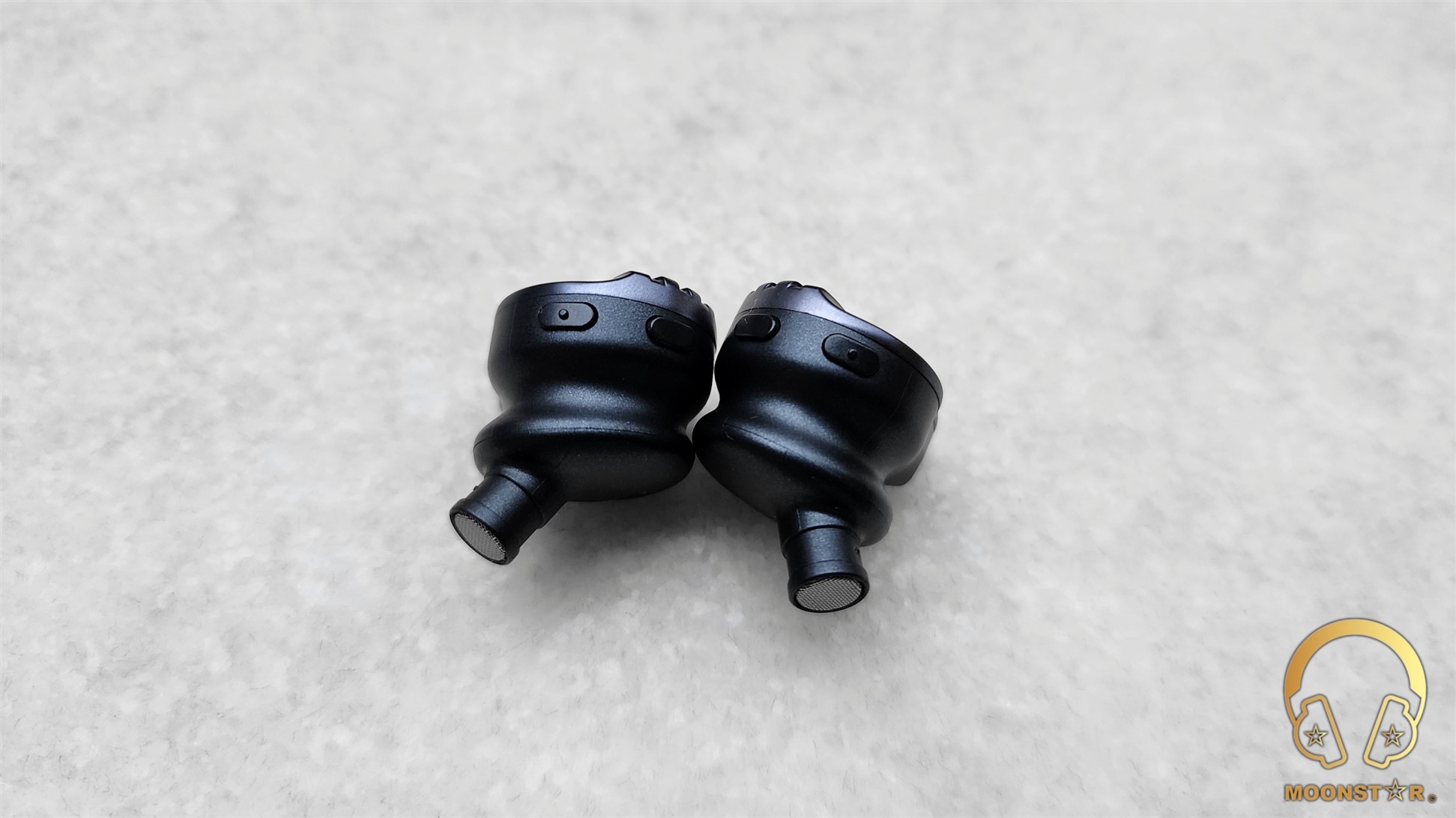
The inner surface of each monitor features a slightly angles sound nozzle with a fine metal mesh on the top.
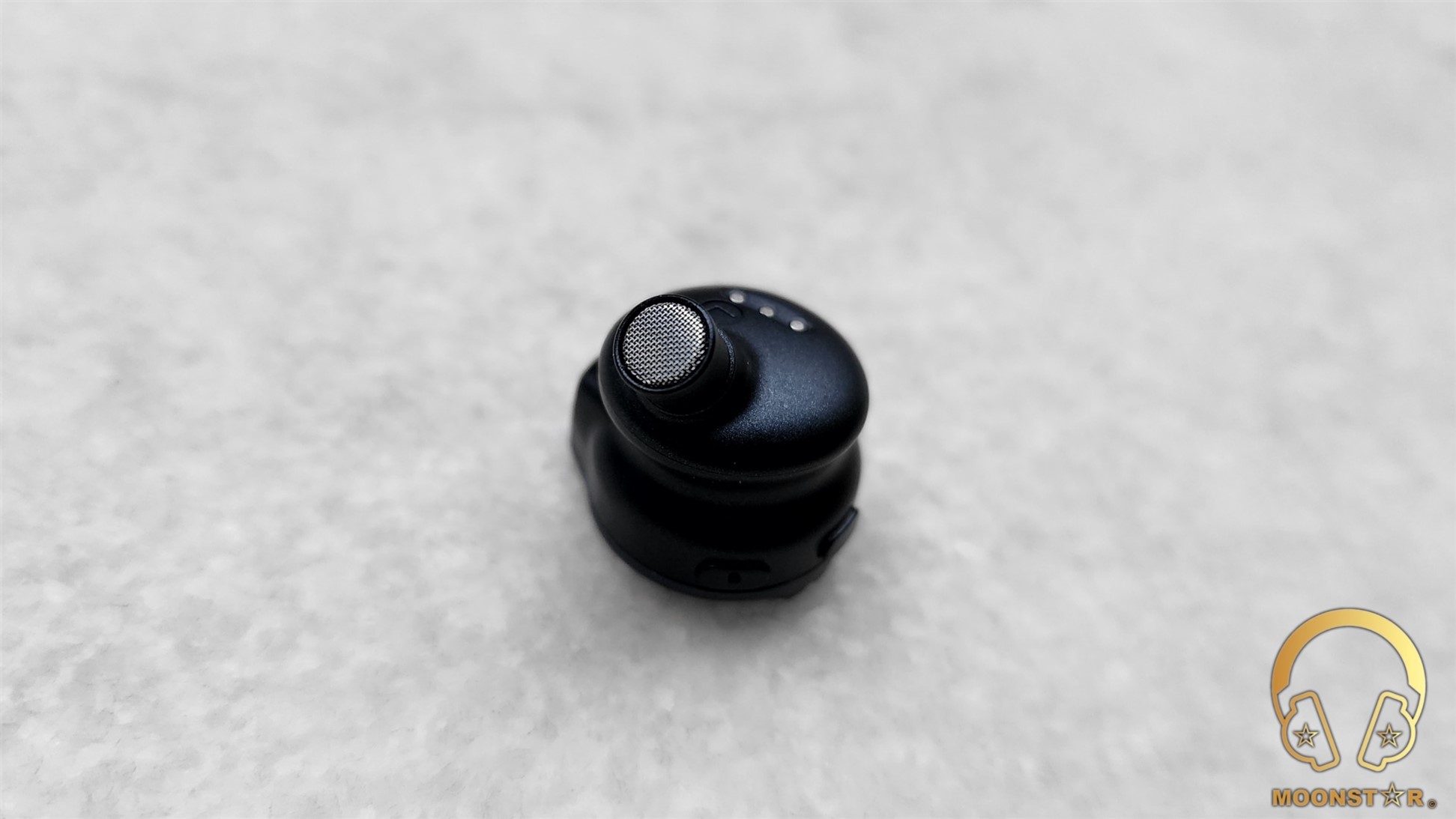
Near the sound nozzle is a small opening dedicated for the 10mm dia. large Dynamic Driver. This opening is equipped with water-resistant sound-permeable cottons to fulfill the IPX4 water resistance. Here area also the L (Left) or R (Right) markings and 3 metal connectors in gold color.
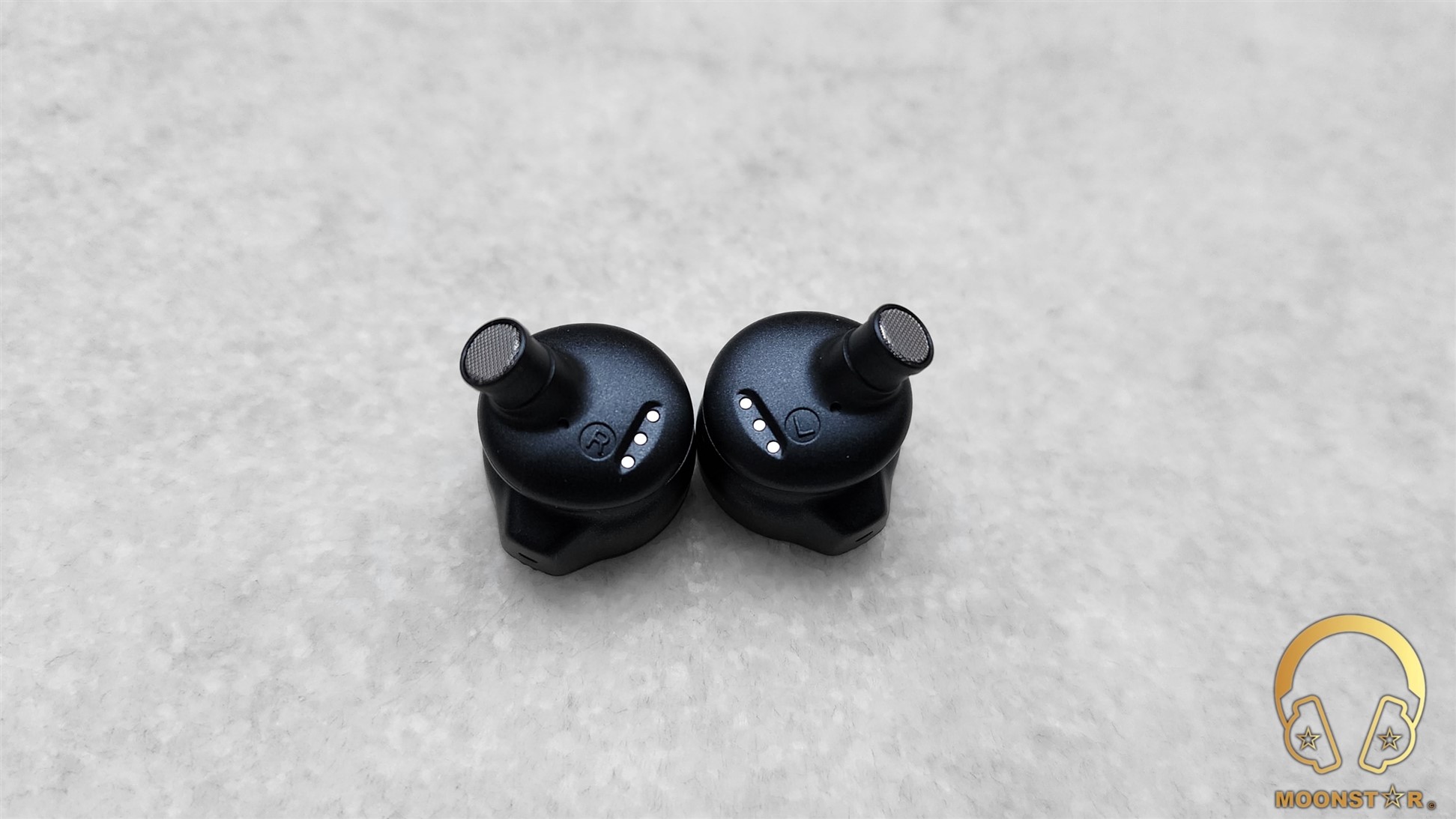
At the bottom and top of each earpiece is a dual microphone setup that features Qualcomm’s latest cVc Noise-Cancelling Microphone Technology.
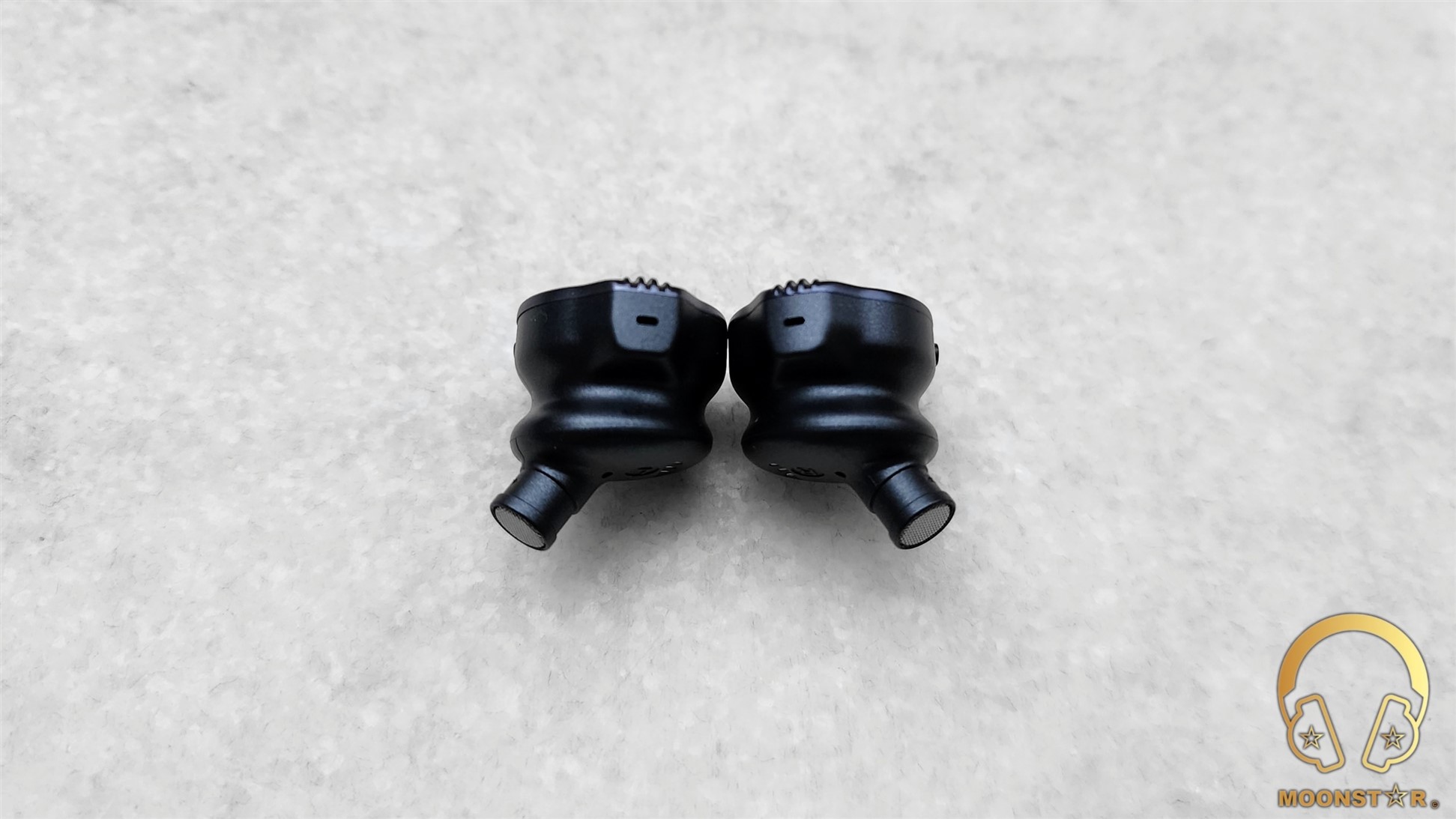
All openings are equipped with waterproof membranes and/or water-resistant sound-permeable cottons in order to fulfill the IPX4 water resistance.
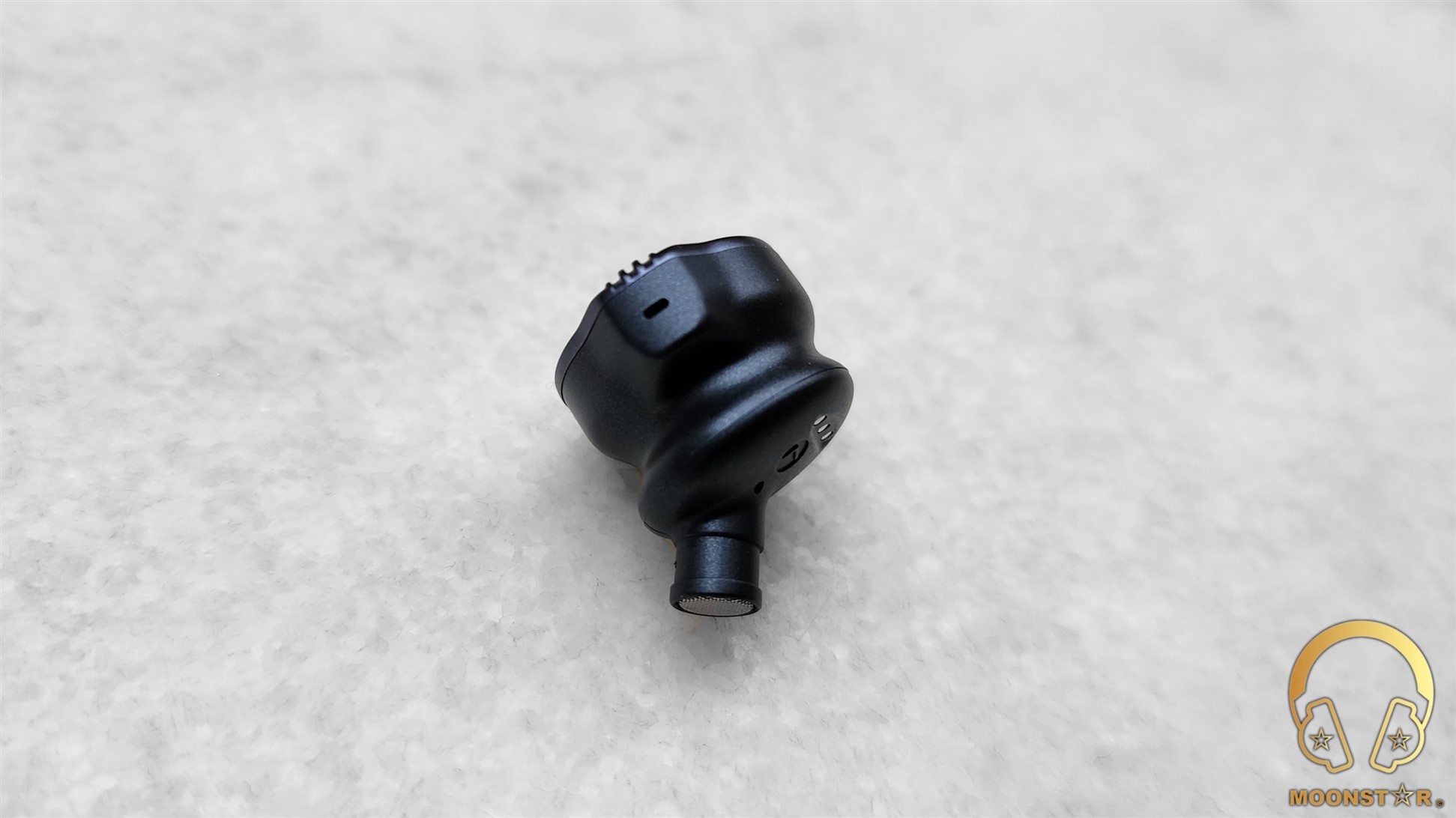
Charging Case & Battery Life:
The FW5 has a quite small battery case made from plastic material in dark grey color that fits easily in to a small pocket, which I really like about it. The case has a rounded shape that is comfortable to hold in my hand.
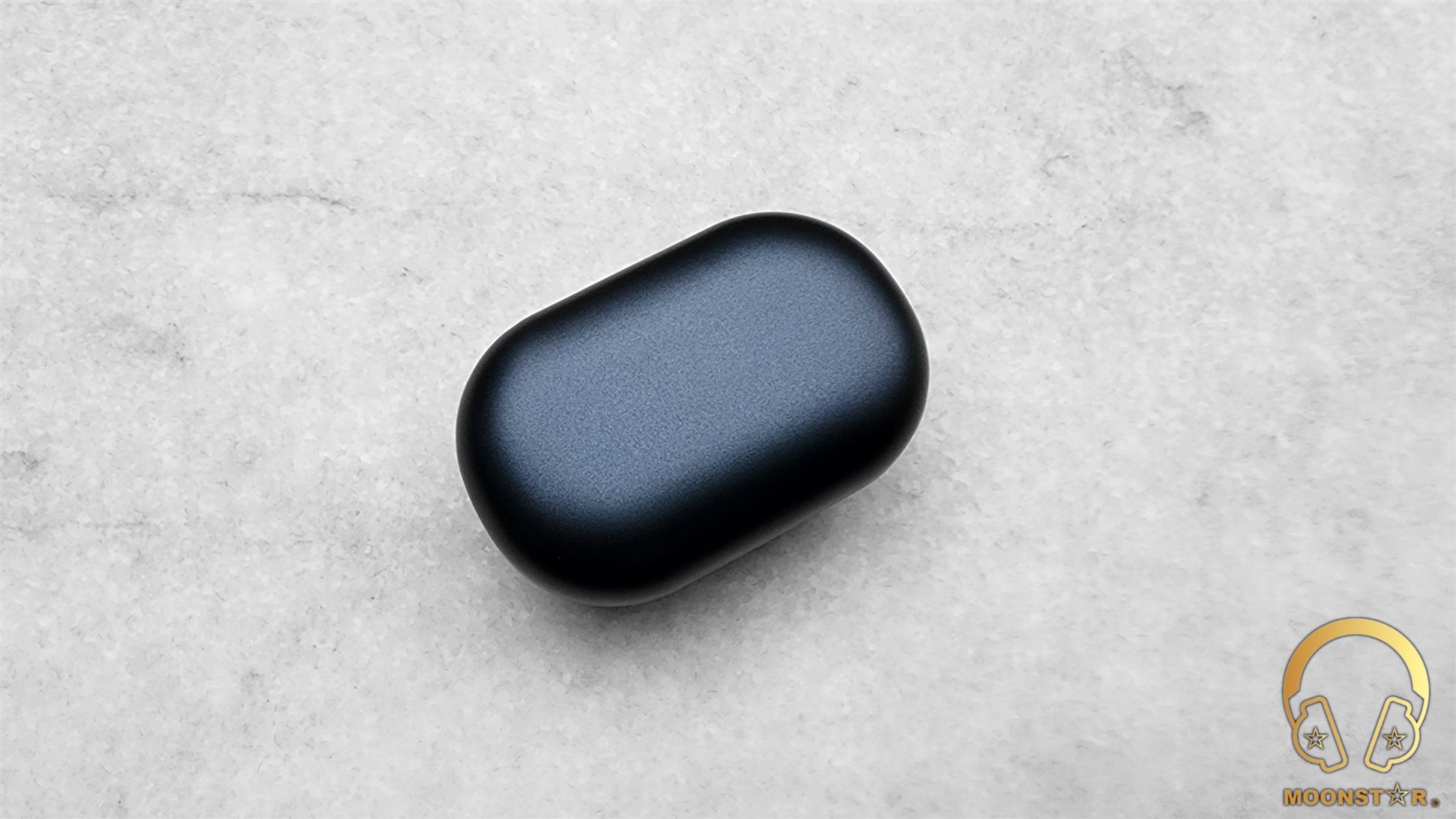
On the front of the charging case are four small LED status indicators and a small recession to open the cover.

The rear surface of the case sports the USB Type-C charging port and the hinge mechanism.

At the bottom of the case are the FiiO logo and some technical specifications and industrial certification about the FW5.
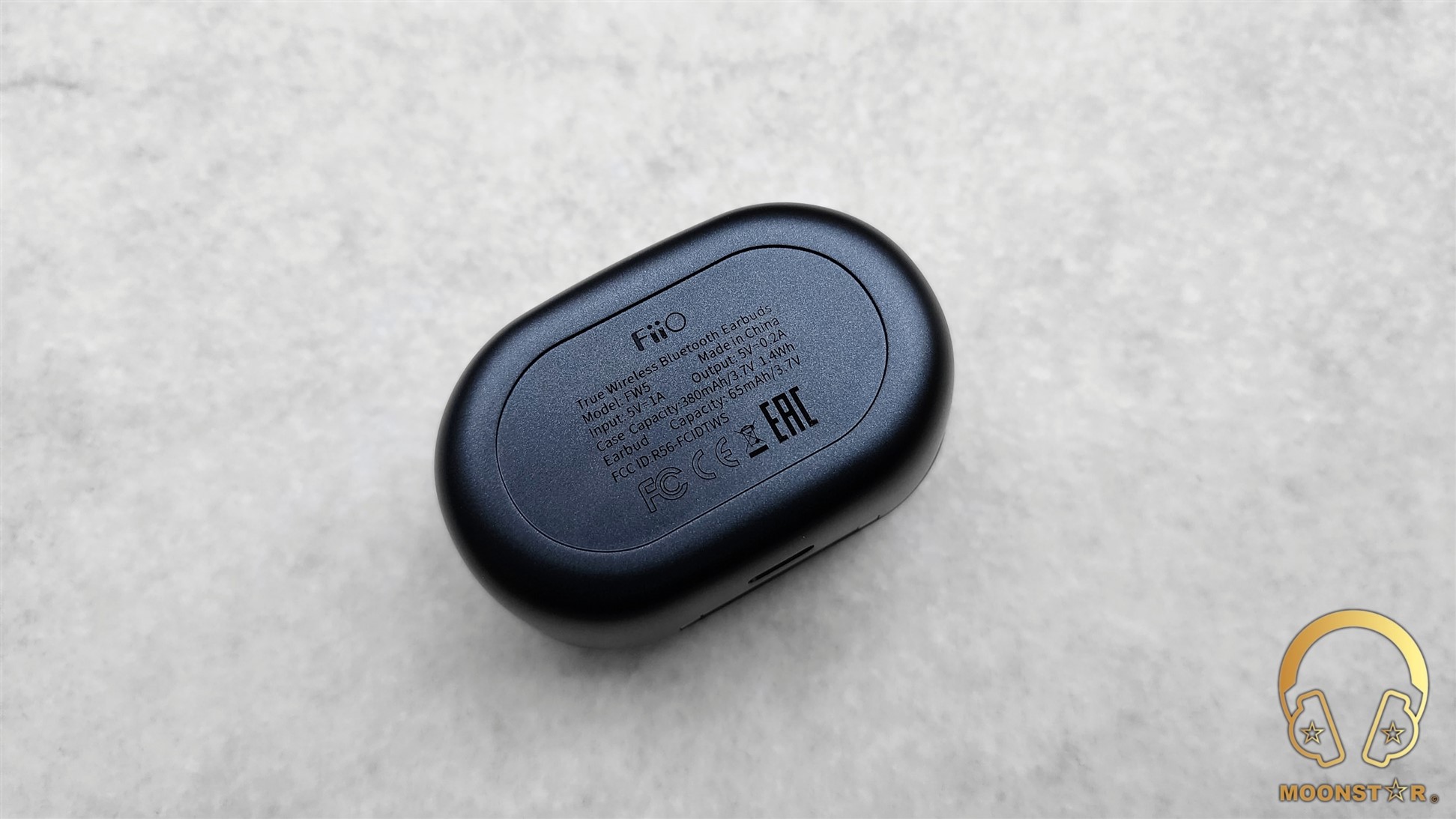
When you open the case you will see the seats, male connectors and L (Left) and R (Right) markings for the TWS monitors.

These seats have a magnetic surface to ensure a tight/save connection for the charging process and to avoid any drop out of the monitors.
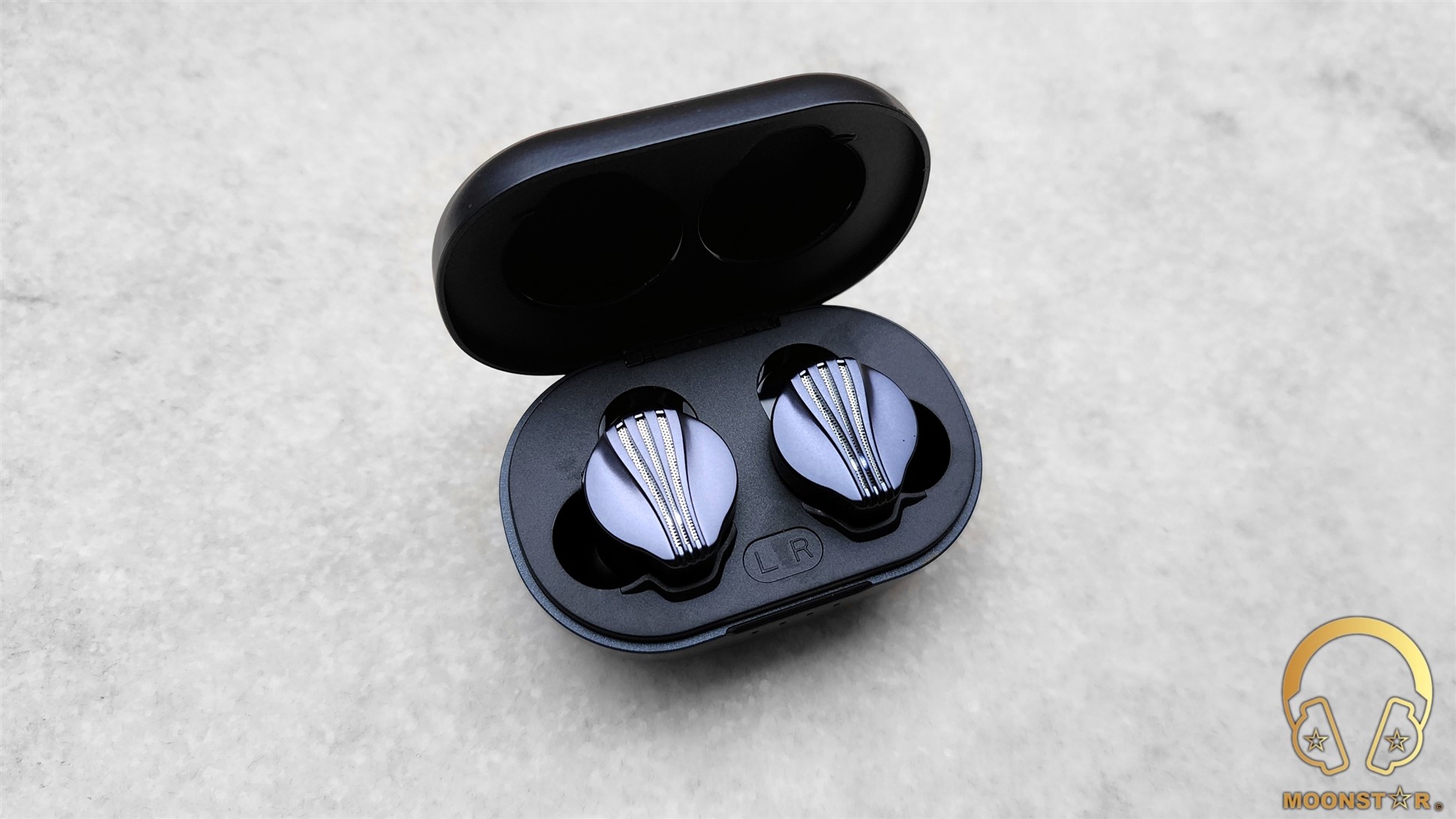
The charging case has battery with a capacity of 380mAh, which means 21+ hours when the when the battery is fully charged. The Charging time for the charging case is approx. 1h40min.
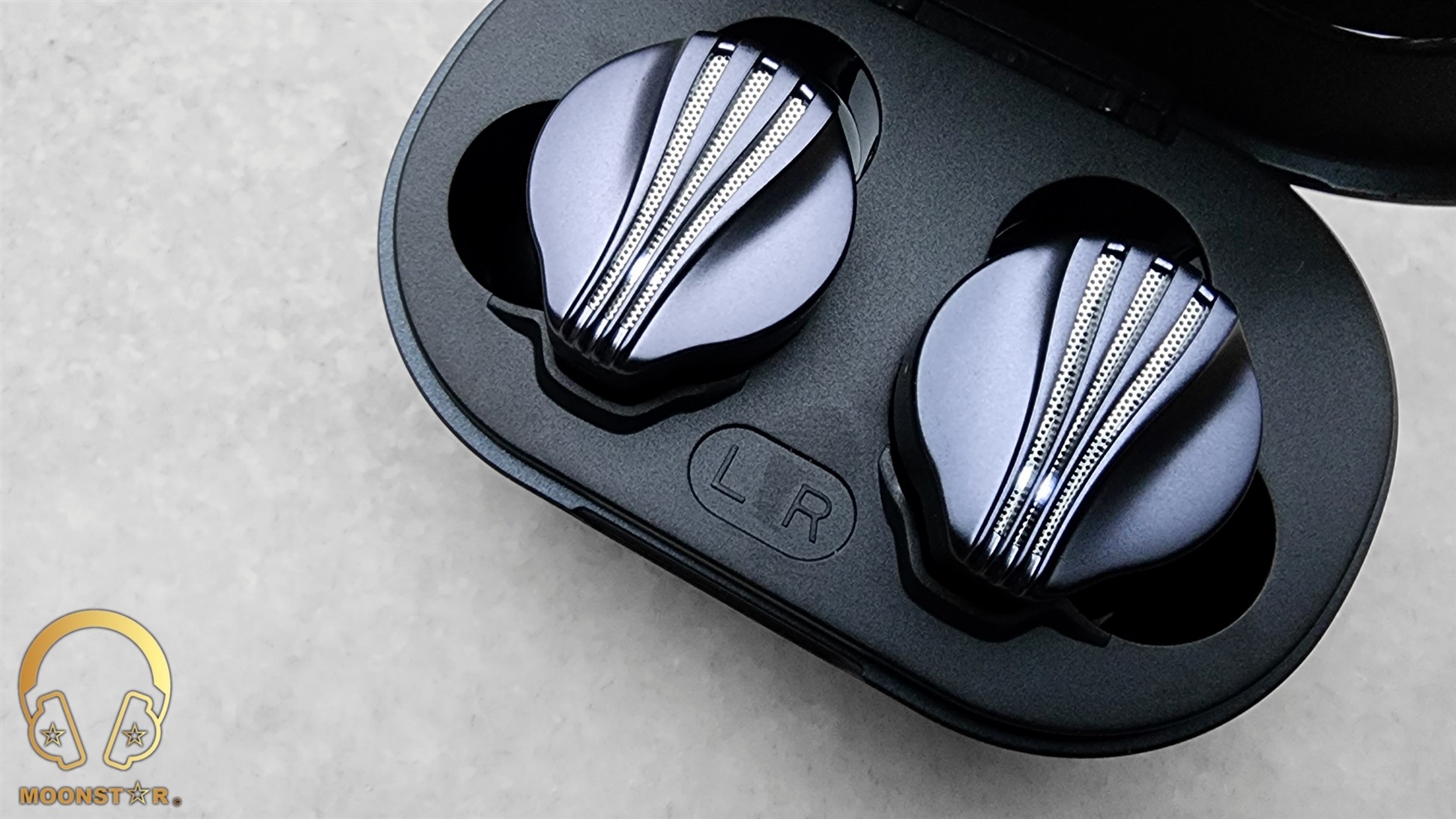
Each monitors is equipped with a 65mAh build in battery that offers continues playback of approx 6.5 – 7 hours, when used with the AAC codec.
Technical Specifications:
- Model : FW5
- Driver Configuration : 2x Knowles RAD BA + 1x 10mm DLC Diaphragm DD
- Frequency response : 20-20kHz
- Sensitivity : 106dB/mW (@ 1 kHz)
- Impedance : 32Ω±20% (@ 1 kHz)
- DAC : AK4332
- DAC Distortion : 0.0016 %.
- DAC Signal to Noise Ratio : 106dB.
- BT SoC : Qualcomm QCC5141
- Bluetooth Version : BT 5.2
- BT Codec’s : SBC/AAC/AptX/AptX Adaptive/LHDC
- Max sampling rate : 96 kHz-24bit
- Supported protocol : A2DP/AVRCP/HFP/HSP
- Transmission distance : approx. 10mt
- Battery Life : about 6.5 – 7 Hours (with AAC Codec)
- Charging Time : approx 1.5 hours (Adapters)
- Waterproof Level : IPX4
- Charging Connector Type : USB Type-C
- Charger dimensions : 68.4*43.9*32.3 mm
- Battery capacity earpiece : 65mAh
- Charger : 380mAh
Pairing, Signal Strength & Call Quality:
The pairing process for the FiiO FW5 is quite easy, just put out the monitors from the charging case and it will automatically go in to pairing mode. Once you have paired FW5 it will automatically connect with the last source.
The operating distance of the FW5 is approx. 10 meters same like many other TWS IEM’s on the market. But what I really like about the FW5 is the very stable connection with the source even if there is a wall.
The FiiO FW5 offers a decent voice transmissions that is fairly clear when paired with my Samsung Galaxy S22 Ultra, thanks to its Dual Microphone setup that supports Qualcomm’s latest cVc Noise-Cancelling Microphone Technology.
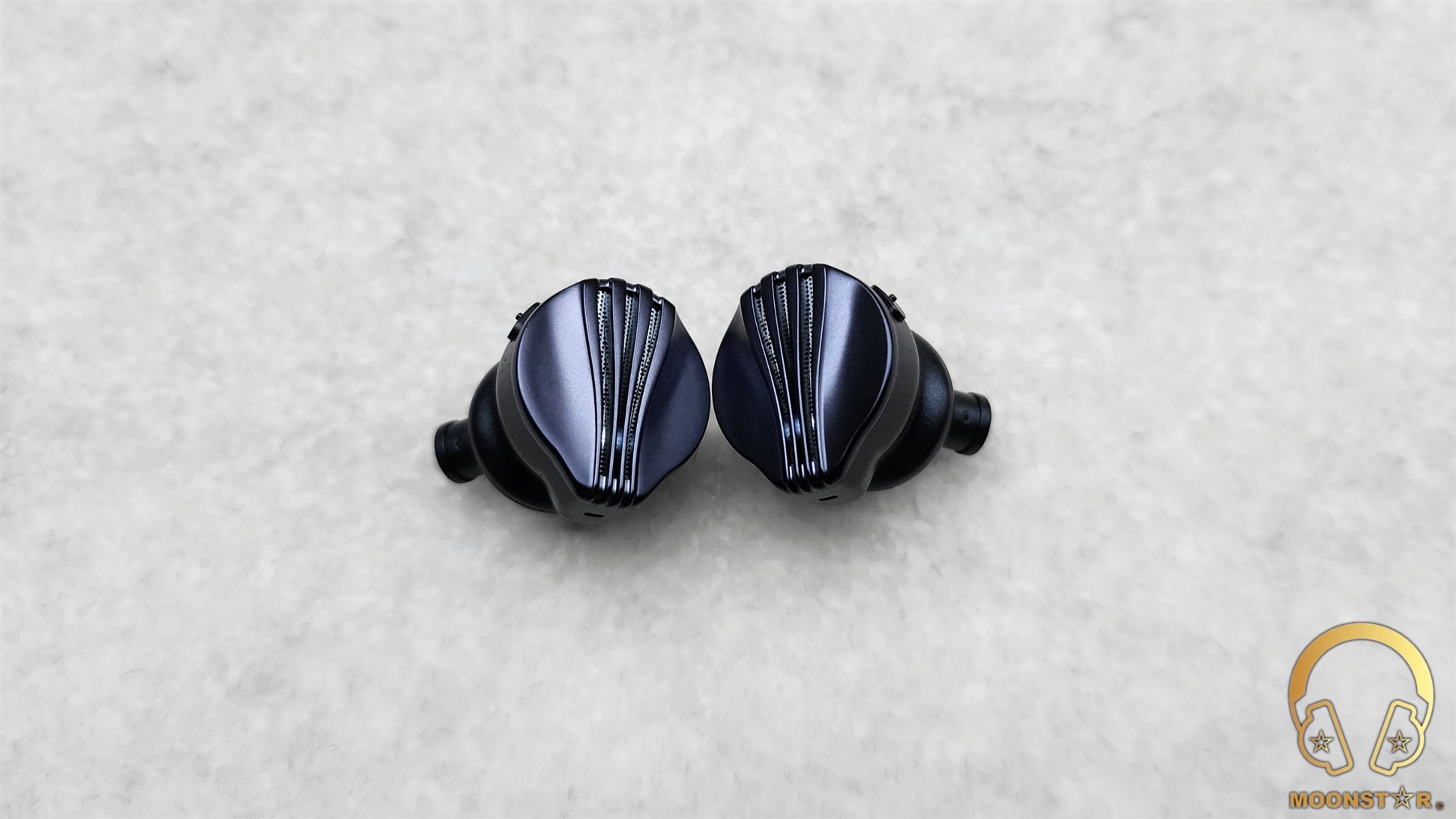
Fit, Comfort & Isolation:
The FiiO FW5 is not the smallest TWS IEM/Earphone due to the 2BA+1DD Hybrid Driver configuration that needs a larger acoustic room. However, the fit is surprisingly good with consideration of its size. The FW5 does not come with Active Noise Cancellation (ANC), while the passive noise isolation is on an sufficient level, efficient enough to use it in relative noisy environments such like a bas us train.
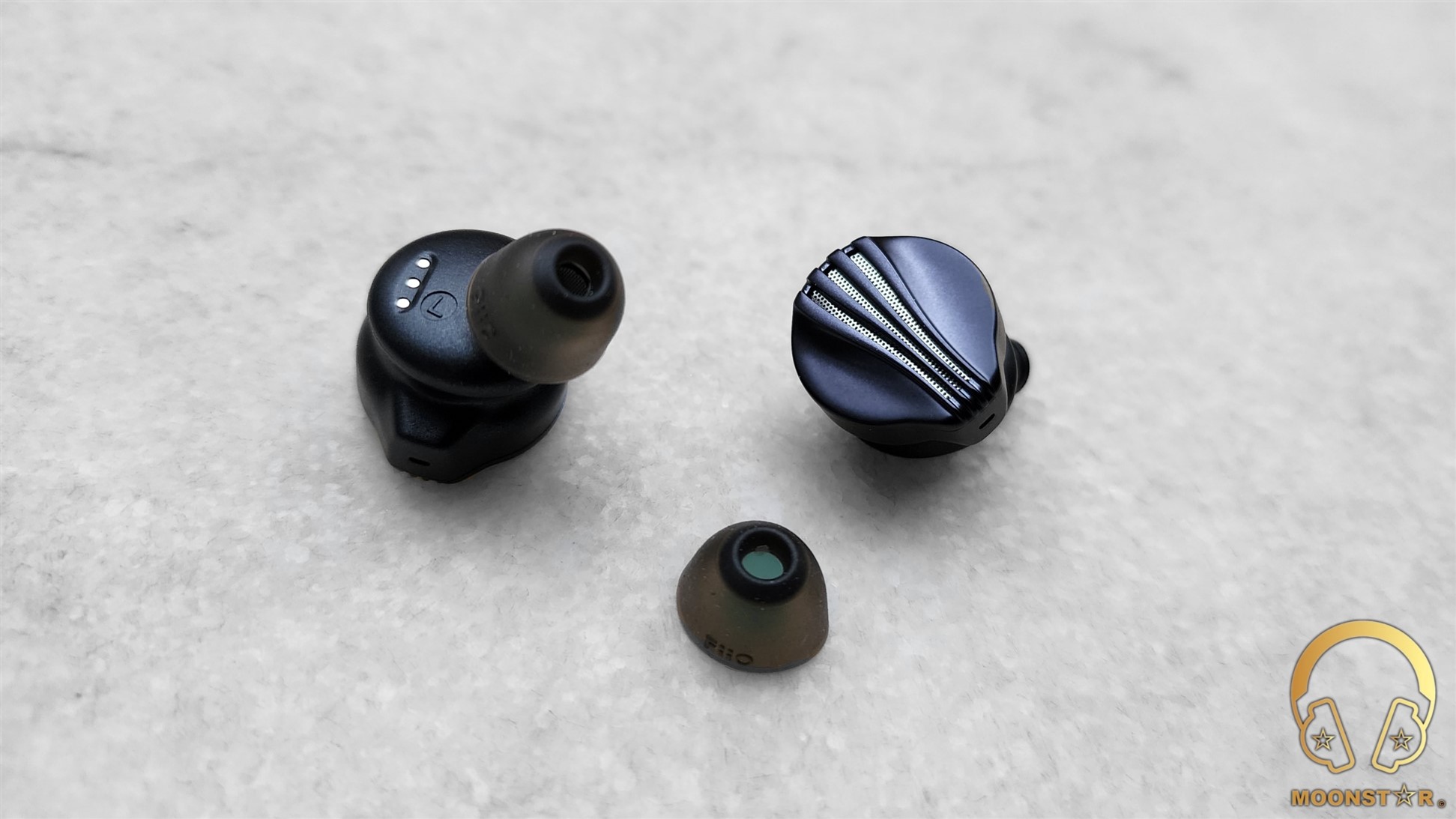
Key Features:
AK4332 Independent DAC Chip:
The FiiO FW5 is equipped with an independent AK4332 DAC (Digital to Analog Converter) chip of the company Asahi Kasei that supports the companies AKM VELVET SOUND Technology. The AK4332 chip achieves a Signal to Noise Ratio (SNR) of up to 106 dB, a distortion of 0.0016% and a Dynamic Range (DNR) of up to 102 dB.
Qualcomm QCC 5141 BT SoC:
FiiO FW5 adopts Qualcomm’s latest QCC5141 Bluetooth signal receiver chip, which brings major performance upgrades over the previous generation CR8675 or QCC3020 SoC in terms of connectivity and stability. The QCC5141 offers a decent Bluetooth audio transmission thanks to its dual-DSP and dual-core architecture. In addition, the FW5 is Snapdragon Sound-certified, which is another major improvement in terms Hi-Res Audio Transmitting.
FiiO Control APP:
The FiiO FW5 has been advertised to be compatible with the FiiO Control APP, which is a pretty useful tool to fine adjust and update Wireless & Wired products of the company. However, the FiiO Control APP couldn’t recognize the FW5, which seems to be added with a future FW update.
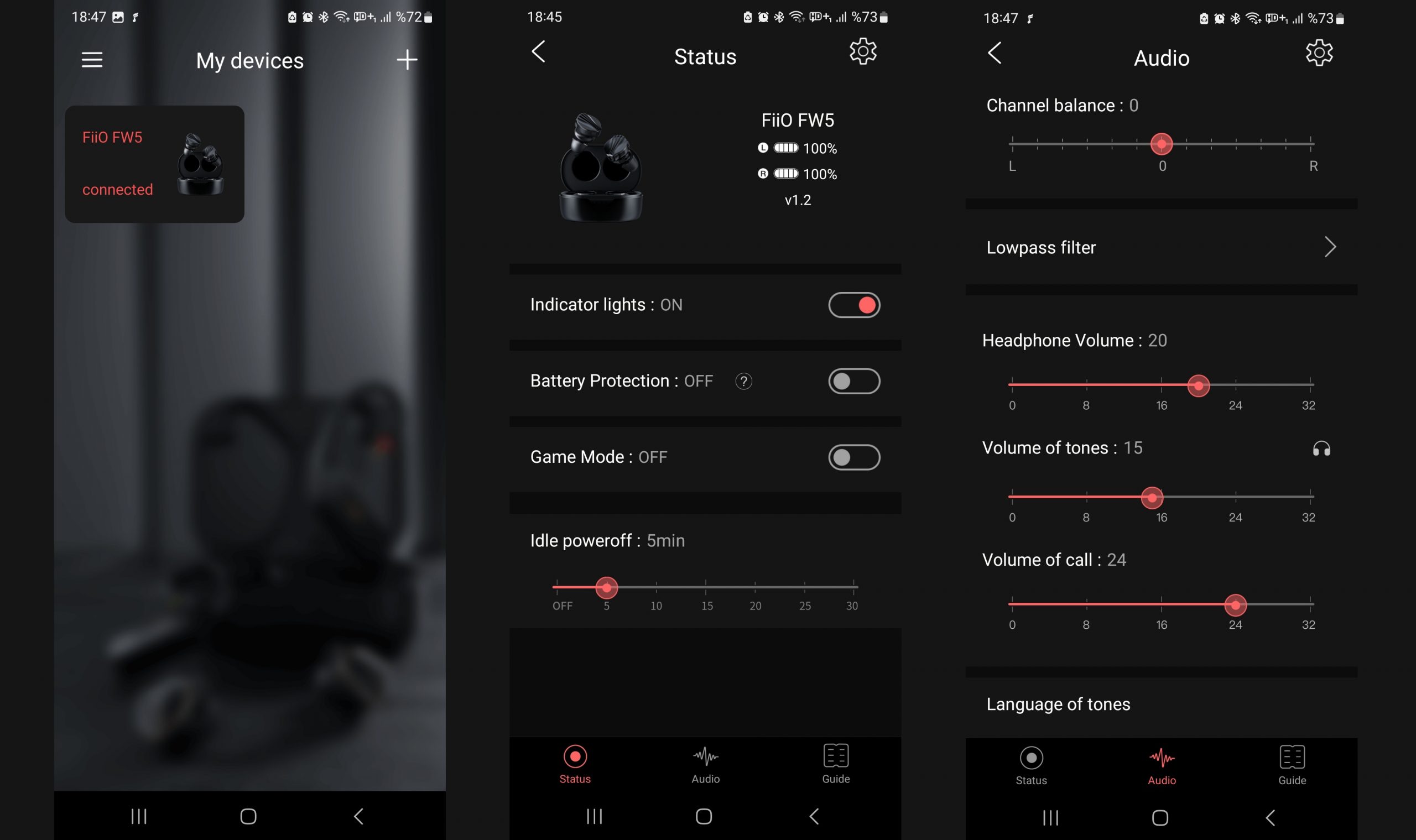
Equipment’s used for this review:
- TWS IEM’s : FiiO FW5
- Paired Sources : FiiO M11 Plus ESS, Samsung Galaxy S22 Ultra
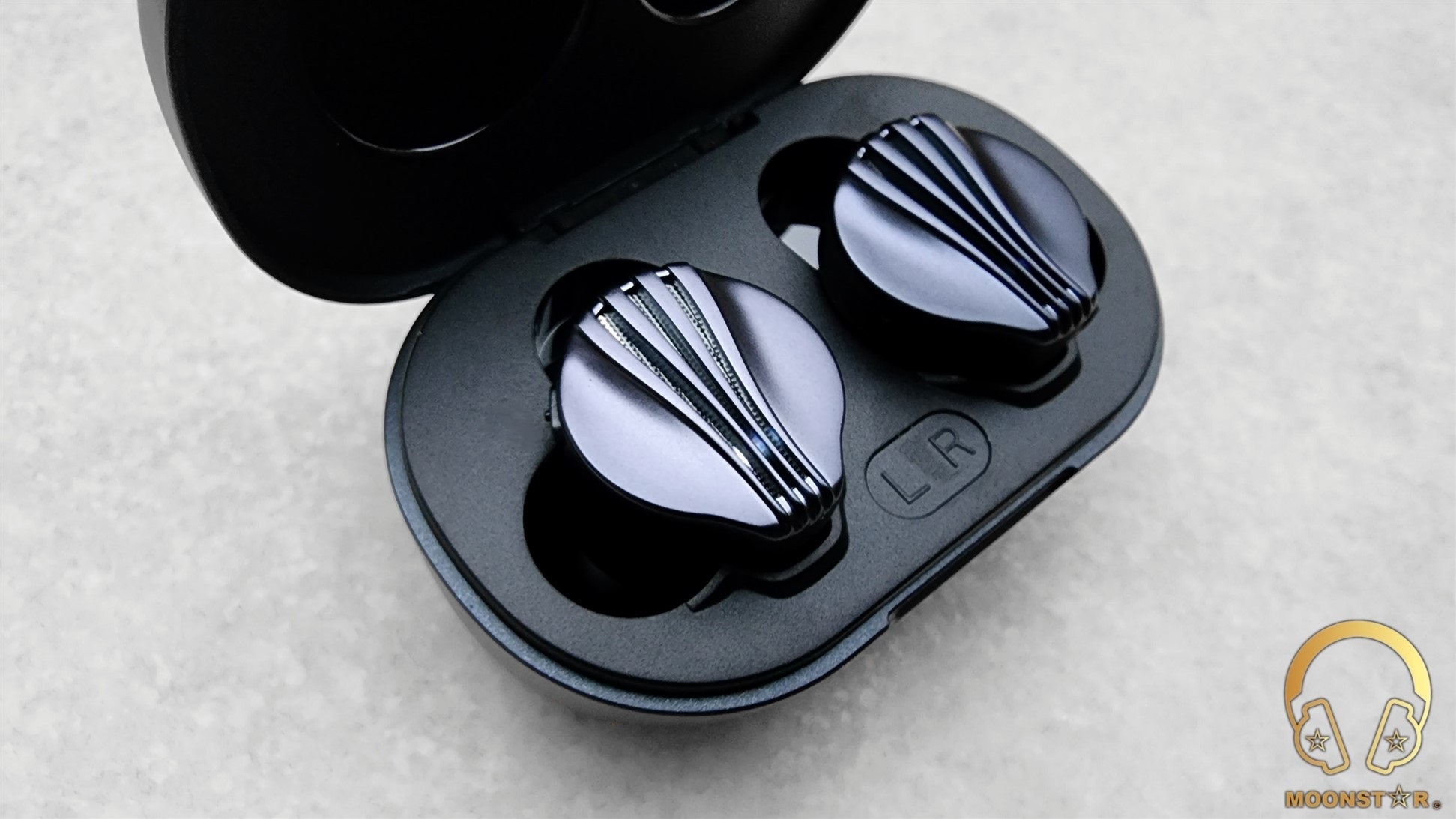
Albums & tracks used for this review:
- Adele – My Little Love
- Randy Crawford – On Day I Will Fly Away
- Aretha Franklin – I Say a Little Prayer
- Hayley Westenra – Odyssey Album
- Dionne Warwick – Walk On By
- Sarah McLachlan – Angel
- Edith Piaf – Non Je Ne Regrette Rien
- Diana Krall – So Wonderful (DSF)
- Dave Gahan – Kingdom
- Sting – Englishman in New York
- Barry White – Just The Way You Are
- Isaac Hayes – Walk On
- Elton John – Rocket Man
- Eric Clapton – Wonderful Tonight
- Sting – Englishman in New York
- Casey Abrams – Robot Lovers
- Fazıl Say – Nazım Oratoryosu (Live)
- Chopin – Nocturn No. 20 In C-Sharp Minor
- Vivaldi – Le QuarttroStagioni “The Four Seasons”
- Otto Liebert & Luna Negra – The River
- Gogo Penguin – Raven
- Lunatic Soul – The Passage
- Metallica – Sad but True
- Megadeth – Sweating Bullets
- Rush’s – Leave That Thing Alone
- Slayer – Angel of Death
- Liquid Tension Experiment 2 – Acid Rain
- Lorde – Royal Massive Attack – Angel
- Toutant – Rebirth
- Really Slow Motion – Deadwood
- Daft Punk (feat. Panda Bear) – Doin’ it Right
- Massive Attack – Angel
- Bear McCreary – Valkyries (Gof of War)
- Muse – The Handler
- Twerl – Lishu
- U2 – Sunday Bloody Sunday
- Yosi Horikawa – Bubbles
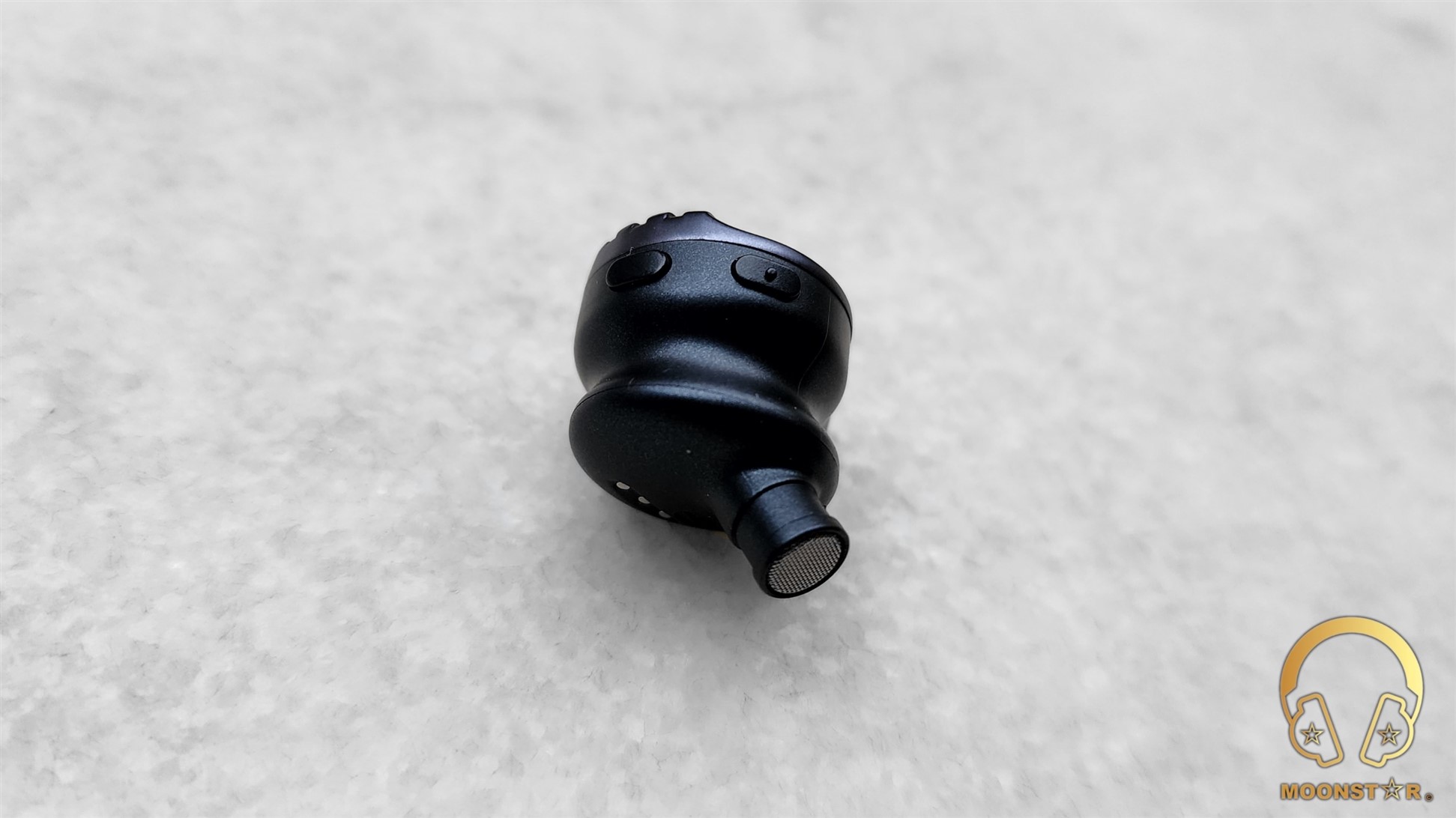
The Sound:
The FiiO FW5 is a pretty spacious sounding TWS Earphone/IEM with a mildly V-shaped sound signature that shows slightly warmer than neutral tonality and relative natural timbre especially for a TWS product while listen to instruments and vocals. The nicely implemented independent AK4332 DAC plays a big roll for the general sound performance of the FW5.
The FiiO FW5 review has been written after a burn-in period of about 50 hours. My sound impressions below are mainly based on pairings with BT sources like the FiiO M11 Plus ESS and Samsung Galaxy S22 Ultra (Snapdragon Version).
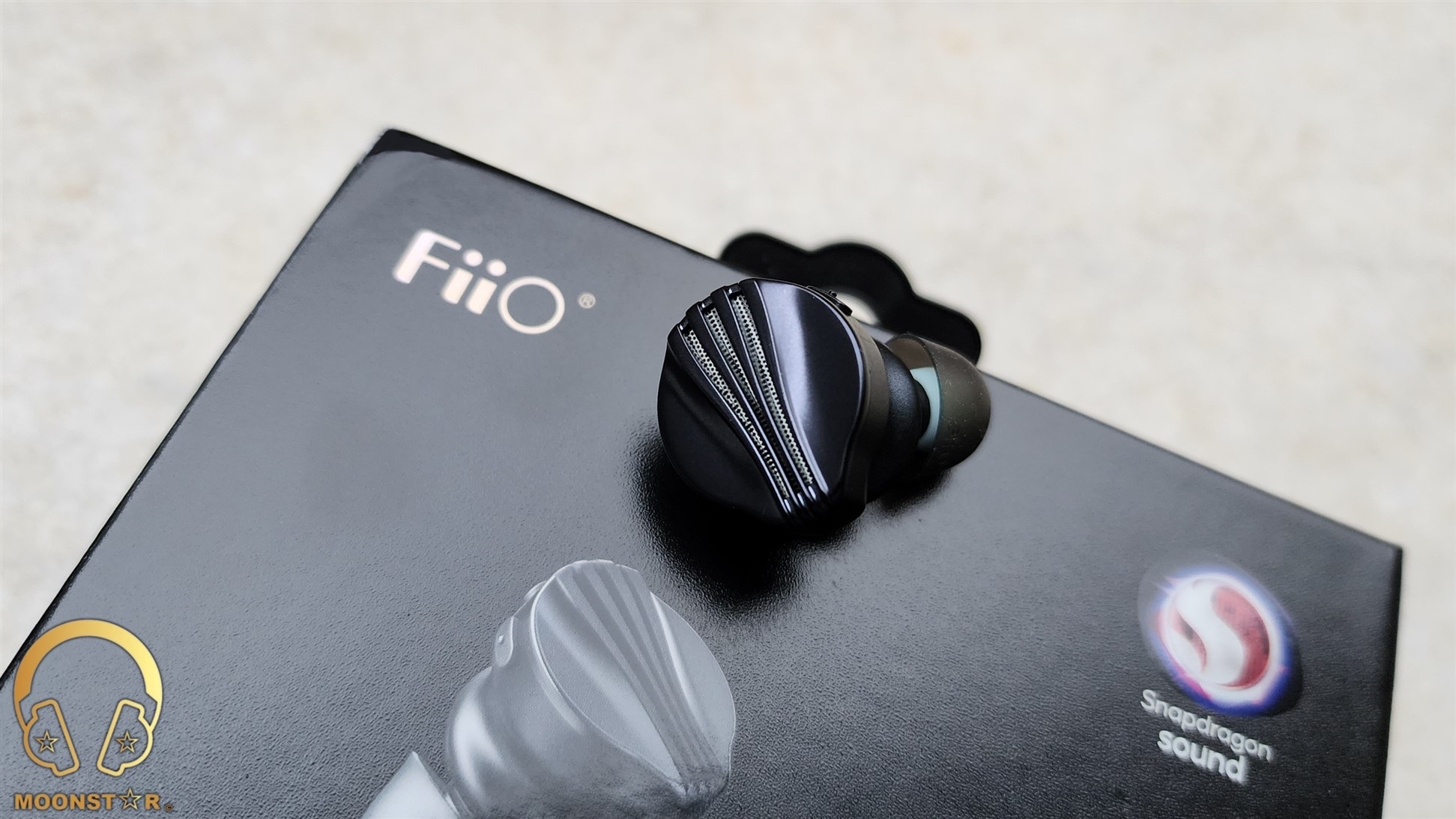
Bass / Midrange / Treble / Soundstage:
The lower frequency response is one of the main highlights of the FW5 that is produced with a pretty capable 10mm DLC Diaphragm Dynamic Driver and shows a pretty entertaining performance with genres like Pop, Hip-Hop, EDM or Trance music. The subbass region has a moderately warm tonality and is able to produce a good level of depth, intensity and rumble that can compete with wired IEM’s, when I have listen to songs like Lorde’s “Royals” and Daft Punk’s “Doin’ it Right”.
The midbass region on the other hand is pronounced but doesn’t show any midbass hump, which could lead to a muddy presentation. The level of clarity, body and impact is excellent for a TWS IEM/Earphone when I listen to instruments such like a bass guitar, cello or kick drum. What I also really like is the sense of authority and speed that can compete with many wired IEM’s at price range between 100 and 200 USD that was pretty audible in complex songs like Gogo Penguin – Raven.
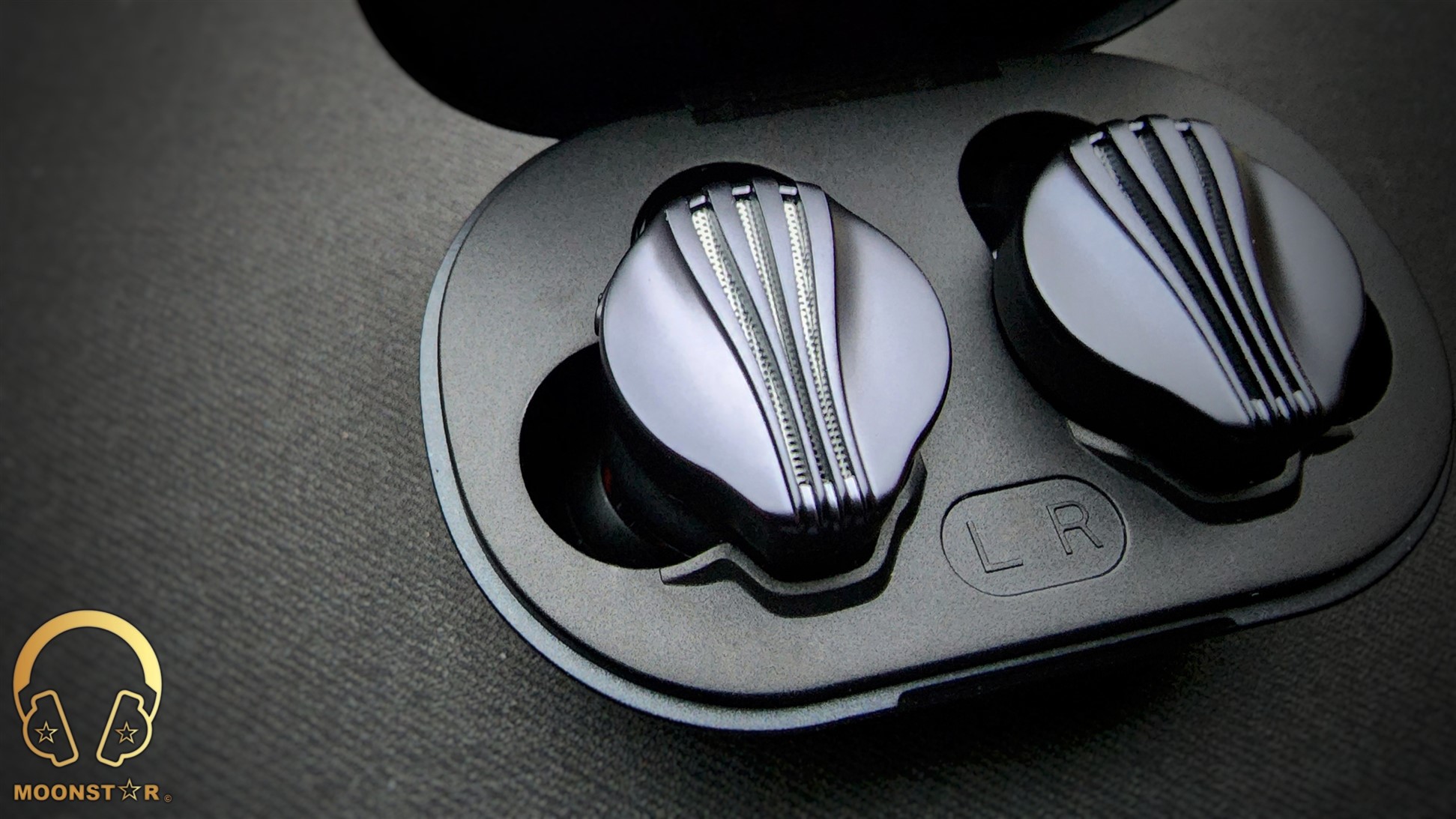
The midrange is slightly recessed compared to the lows and highs due to the mildly V-shaped sound signature, while these tuning creates some headroom/space while listen to songs with a lot of instruments without to make them sound too distant. The general tonality is a bit warmer than neutral and the timbre of both instruments and vocals is pretty natural and rich.
The lower midrange is produced with an adequate grade of depth and fullness, which makes male vocals and instruments like electro guitars, toms or violas are quite enjoyable to listen to. The upper midrange is nicely pronounced but without to sound overly bright or sibilant when I do listen to female voices such like Edith Piaf, Adel or Sertap Erener. Instruments on the other hand are reproduced in general with a good sense of brightness, resolution and extension.
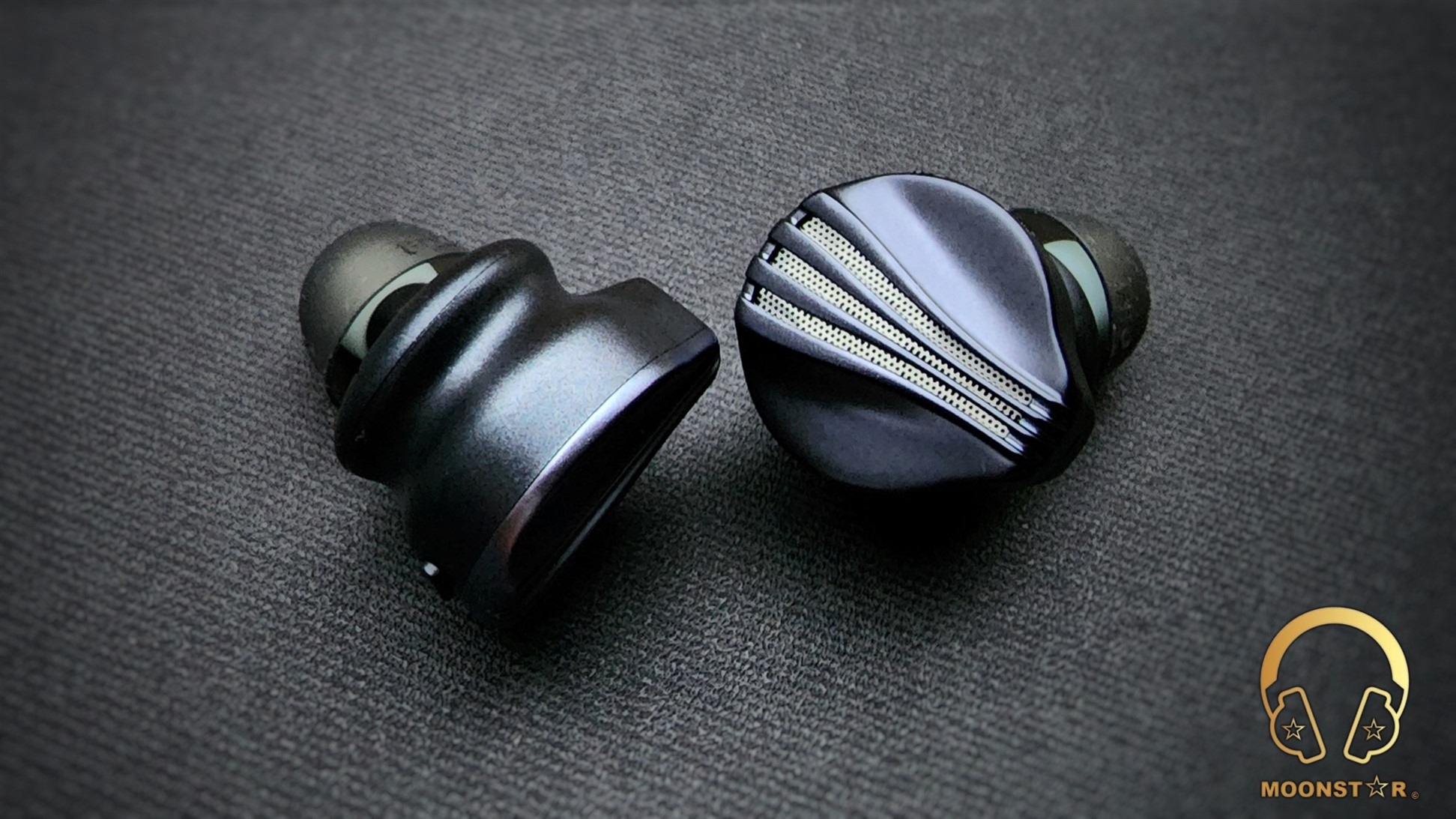
The treble range that is produced with 2 x Knowles RAD Balanced armature drivers, which are located inside the sound nozzle of the FW5, are able to produce a decent sense of clarity, airiness and brilliance, without to create unwanted conditions such like unnaturalness or over-sharpness. The 2x Knowles BA divers do work in a pretty good synergy with the 10mm dia. Dynamic Driver unit.
The lower treble range shows an efficient level of presence so that vocals or instruments such like a violin do have a decent grade of clarity, while kick drums are reproduced with good sense of attack. The upper treble region offers a nice sense of airiness and sparkle, while the extension of instruments such like percussions is on a moderate level.
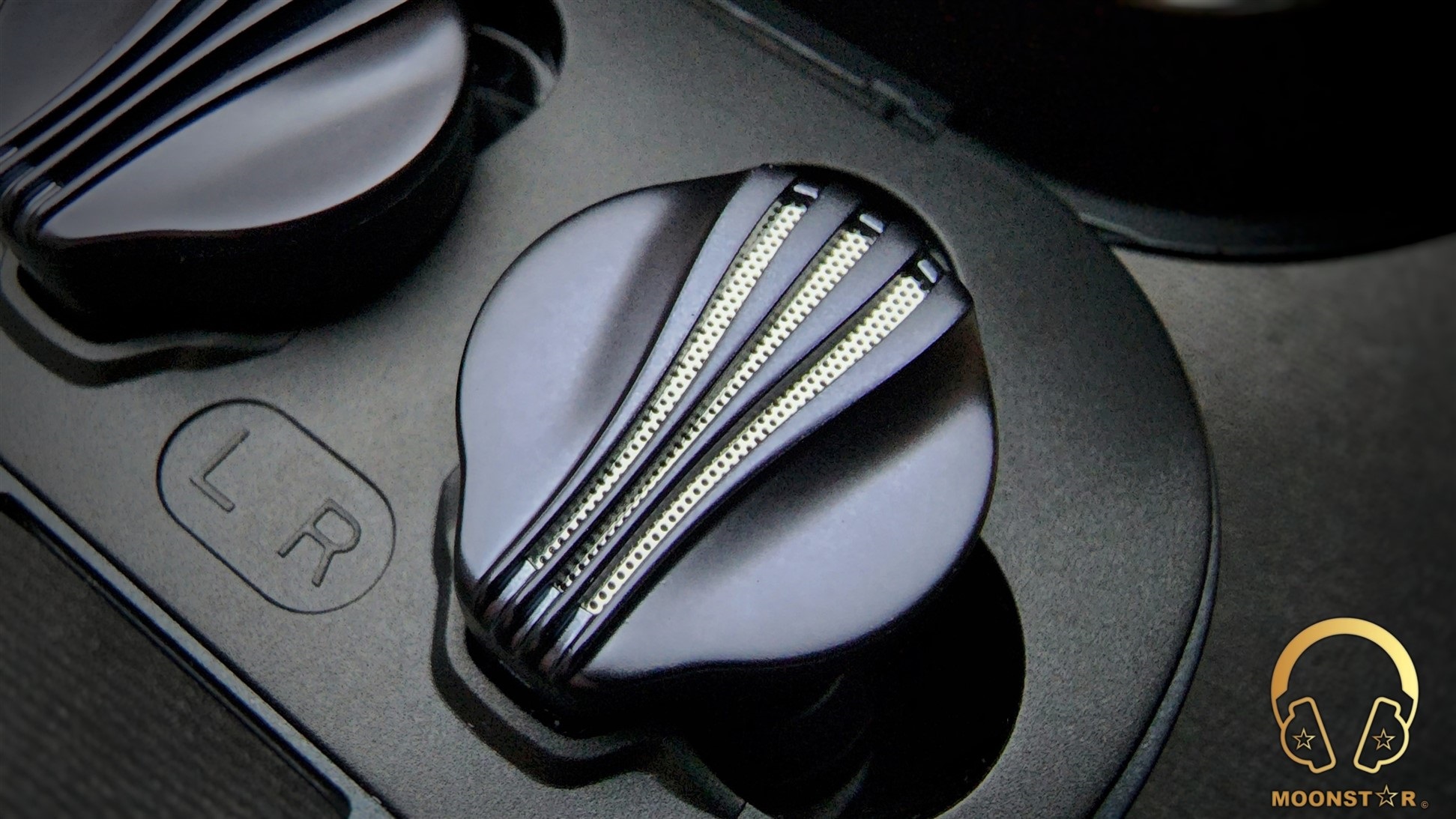
What I really like about the FiiO FW5 is the pretty spacious and airy soundstage atmosphere, which offers a good sense of depth and wideness, especially for a TWS Earphone. The FW5 is also quite successful when it comes to the separation of instruments and vocals.
Conclusion:
The FiiO FW5 is an excellent sounding TWS earphone with a beautiful faceplate design that is equipped with some solid hardware features such like an independent Asahi Kasei AK4332 DAC Chip and Qualcomm’s latest QCC 5141 BT SoC. Moreover, it offers a sound performance that can compete with many wired earphones on the market at the same price range, which impressed me with its nicely tuned mildly v-shaped sound signature and its pretty spacious and airy sound atmosphere.
Thank you for the Read!
Moonstar
@o0genesis0o Thank you!
B
Bay Jingles
Thanks for review. I'm using an iPhone. Do you think I should buy AirPods Pro 2 or FiiO FW5?
Moonstar
@Bay Jingles Thanks! In terms of sound, I definitely think the FW5 is the way to go.
Ceeluh7
500+ Head-Fier
Pros: -Build Quality
-Very ergonomic and feather weighted
-Triple Driver in tws form is more rare
-Great looking set, beautifully designed
-Battery is fantastic for running this Dac Chip (7hrs)
-Two Physical Buttons for controls per earphone
-On board AK4332 Dac Chip
-Fantastic app after update V1.26
-Movies & Videos sound great
-Multi-point connection (connect two devices… latest update)
-Isolation is fantastic with the right tips
-Most any eartips fit in the case (this is a big deal… Lol…Trust me
-Fantastic sound quality in general
-Huge Soundstage for a tws
-Well tuned
-Punchy Bass
-Dynamic Tuning
-Vocals (Male & Female)
-Future updates promise LDAC, Ambient Mode
-Very ergonomic and feather weighted
-Triple Driver in tws form is more rare
-Great looking set, beautifully designed
-Battery is fantastic for running this Dac Chip (7hrs)
-Two Physical Buttons for controls per earphone
-On board AK4332 Dac Chip
-Fantastic app after update V1.26
-Movies & Videos sound great
-Multi-point connection (connect two devices… latest update)
-Isolation is fantastic with the right tips
-Most any eartips fit in the case (this is a big deal… Lol…Trust me
-Fantastic sound quality in general
-Huge Soundstage for a tws
-Well tuned
-Punchy Bass
-Dynamic Tuning
-Vocals (Male & Female)
-Future updates promise LDAC, Ambient Mode
Cons: -Price
-Call quality is average at best
-Lack of features (No ANC, wireless charging, Passive mode etc. etc.)
-Cheap Plasticky case
-May be too bulky for some
-BA Timbre at rare times
-Some slight latency issues unless on gaming mode
-Call quality is average at best
-Lack of features (No ANC, wireless charging, Passive mode etc. etc.)
-Cheap Plasticky case
-May be too bulky for some
-BA Timbre at rare times
-Some slight latency issues unless on gaming mode
Fiio FW5 Review

Fiio FW5 ($149)
Intro
Upon receiving the news that Fiio was going to take another shot at a true wireless iem again I had to check this one out. So, of course I forked over $150 US to Amazon and had my new set of Fiio tws in a matter of about two days. True wireless is not my preferred listening method but when I am out and about you can trust that 100% of my life, I will have a set of tws in my jeans tiny extra pocket. Everywhere I go I have a method for listening to music or videos or podcasts. Lately that set has been the Fiio FW5 which I’ve faithfully carried around for about a month, or just under that. I will try my best to explain this new set and all it does well, and all it does…not so well. With that, let’s get on with it…Inching closer…
True wireless is inching closer to its wired counterparts in overall fidelity and sound quality. However, to an audiophile or practicing audio fanatic this might as well be a mile away. True wireless is very convenient though. The convenience is unmatched in the Audio world. Now I have at least five different Bluetooth dac/amps (ie: IFI Go Blu, FIIO BTR7, Qudelix 5k, Fiio BTR5) which attach to wired iems as well as the Fiio UTWS3 & Fiio UTWS5 and yes, they replay better than any tws by a wide margin. However, I love being able to pop some tws in my ears and get pretty darn good sound quality in such a portable form.Figuring it all out
The reason I purchased the FW5 was to see if Fiio could actually make a set of tws iems which can buck the trend and sound… full, articulate, dynamic and not so compressed. Is the FW5 tuned in a traditional manner, or is the DSP (digital signal processing chip) doing the leg work, or maybe a little bit of both? Fiio has had plenty of time to figure out the obstacles and quandaries associated with wireless audio. Fiio actually has a very extensive list of wireless devices and I have personally owned a few of them…Fiio Lcbt2, Fiio Utws3, Fiio Utws5, Fiio Btr5, Fiio Btr7. If ever there was an audio company with the proper resources and advanced knowledge in the creation and tuning of wireless audio… It’s Fiio.Now, tws will always sound a bit more compressed, smaller in stage, possibly less dynamically vivid and simply less refined than wired audio. It is in this vein which I am judging the FW5. I know where true wireless stands as far as the actual restraints of the technology is concerned. Through this lense I can gauge just how close Fiio has been able to come to my preferred wired iems. Also, I want to compare the FW5 against a few other true wireless iems concerning sound quality and a couple other metrics. Thank you so very much for reading, I hope this review helps… The Fiio FW5…

Gear used
-Samsung Galaxy Z-Fold 4-Shanling M6 Ultra
Full Review can be found here: Fiio FW5 Review
*Note: really quick before I begin, I’d like to preface this entire review by letting all my friends know that I do not use EQ in a review when judging tws. I may add mention of some adjustments within the review that I’ve made, but I do want you all to know, I use the base sound without manipulation of equalization. Also, I switched out tips to the KBear 07 Large tips. I will explain further in the review why that is. I used UAPP as my Android media/music player as well as Poweramp and listened mainly to Flac/WAV/Mp3 files stored on my device.

Packaging
No matter the device, we can rest assured that Fiio will go above and beyond to give a small bounty of packaging and accessories. Now, accessories in a true wireless package are normally not very extensive. No nice cable… obviously, no nice zipper case etc. That said, Fiio understands the importance of a nice presentation. This is what you will get with the Fiio FW5.Inside the box
The FW5 arrived at my door in a larger than necessary rectangular black box. The box feels so sturdy as it is cardboard yet somehow has a plastic feel to it. There is a great looking picture imposed onto the cover of the FW5 and the case hovering over…water? Who knows. Anyways, it’s still pretty cool looking and actually feels neat as well.The box is a flip-open style with a good magnet holding the flap. Open the flap and you are presented with the case on top as well as six sets of eartips. Below the eartips is a small box stuffed into a foam insert which holds the usb-c cable for charging. If you lift out the large foam insert there is one more box with some very compelling reading material, that is if warranty info and quick start guides are your thing. That’s about it. Also, you will find two nozzle cleaning tools and one of them comes with a pointed end and a magnetic end for removing Nozzle filters for cleaning. The other is a tiny brush. Not bad at all Fiio.



Charging Case

The charging case is not the most robust in terms of build, yet it also isn’t the worst I’ve ever encountered. The case is just small enough to fit in my extra little jeans pocket. It is of good size in terms of portability and won’t stick out too far from the pocket looking weird or anything. You will notice four small lights on the front of the case indicating overall battery life of the case as well as some other info pertaining to the FW5.
One fantastic thing about the FW5’s case is the fact that it is deep enough to allow 3rd party tips to actually fit inside. This is a bigger deal than it should be. I have owned around 30-40 tws over the years and one of my biggest issues comes from inability to swap tips because the stupid case won’t allow these 3rd party tips to fit inside and actually close. Fiio! Great job!
Eartips

Fiio added three pairs (L, M, S) of their own “HS18” Vocal tips. Truthfully, I don’t like these tips. They are very flimsy at the flanges, where the seal is made. It’s hard to even know if you have a good seal. However, these tips have their benefits. They have a medium-wide bore and do give off a more open sound, bigger stage, less low-end, they do well to accentuate vocals etc. Also provided in the package is three pairs (L, M, S) of Gray “Balanced” tips. I don’t know how these tips would give a balanced sound as they are narrow bore and a stiffer flange, more rigid stem. Neither are bad accessories but for me to get the most out of the FW5 I went directly to the KBear 07 tips. The sound opens up, tighter Bass and more of a crispy attack/decay.
Features
Chips
As far as features go, the FW5 is slim in some areas and very full in others. The FW5 are heavy in features which promote good fidelity and better sound quality. FW5 supports Snapdragon Sound with 96kHZ/24bit transmission and LHDC with up to 900KbPS bit rate, using Qualcomm flagship TWS SOC Chip QCC5141 + AKM independent DAC/Amp AK4332. The FW5 works off of Bluetooth 5.2 which gives a great connection and audible range from the source. At the moment the FW5 has Lhdc, Aptx, Aptx-Adaptive, AAC, SBC audio codes. Fiio has promised to upgrade to LDAC in the near future so I will edit this review when that does happen.Guys & gals, this is almost unprecedented to have a true wireless with such an established on-board dac chip in the AK4332. Known for its dynamic yet velvet sound technology, a chip such as this would normally be included in a nice dongle dac. Along with this dac chip, I do know that it has its own amplification which really gives the FW5 some good volume and fullness. In fact, this set can get very loud. Fiio also uses this same dac chip within the Fiio UTWS5, however, the UTWS5 also has an independent amplifier.
Physical buttons
The FW5 has four physical buttons, two on each earpiece. I love this, I will always enjoy physical push buttons rather than the easy to screw up touch controls. Plus, Fiio put them in a perfect place at the top of the FW5. Also, having those buttons up top leaves the Faceplate free of unwanted and accidental touches. Having been an owner of many tws iems with a touch surface, I can probably count on my hand the number of sets which can do it right. I have always preferred push button and I am personally glad that Fiio went this route.Battery life
Off the cuff, 7 hours doesn’t seem like a ton of battery life on a set of tws earphones in this day and age. However, let me just remind you of what is under the hood of this set so that you can recognize the feat here. We are working with a Velvet Sound AK4332 Dac/Amp Chip along with a beefy SOC Chip QCC5141. Both of these guzzle battery life like a fat… Never mind, I’ll just stop right here, you know what I mean.The battery life is fantastic for having these onboard chips. Along with these chips is Snapdragon Sound which enables 24 bit/96 kHz transmission. All of these sound features normally equates to less actual listening time. I didn’t actually try to test out how long the battery can last in real-world testing, but I have used these all day in my office and have yet to come even close to a depleted battery.
Seven hours is not bad at all considering what lays underneath. Also, you will receive another 14 hours using the case which brings the total to 21 hours of battery life. I think it’s great. When I heard they’d actually use this particular dac chip, I thought for sure… 4 hours max… Pretty darn nice. Plus, who of you has these in your ears that long? Seriously people, how much do you need? Do any of you actually listen to seven hours of straight music… In your ears?
1PX4
Along with some of the sound features, Fiio is adding IPX4 waterproofing to the earpieces themselves. This means there is a layer of protection using a light film over every gap on this set. This protects from droplets of rain or stray splashes. This is the least they could do for $150. To be honest I’d like to see a bit better rating but, sacrifices.Box switch
This is another feature which I like to see. This is a “box switch”. It is a fantastic feature but hardly recognized. It basically means that the second you put the earphones back into the case the FW5 will shut down. Also, whenever you open the case the FW5 will turn on and pair with the last device.Multi-point connection
Fiio also added multi-point connection to the FW5 in the most recent firmware upgrade. This simply means what the name implies, you can connect to two different devices at once. This is so very handy for me. I use it often with my Qudelix 5k. However, I have yet to actually try this feature out on the FW5. Mainly because I have to go through and figure out how to complete the task. Still, as far as the functionality of multi-point connection is concerned; you don’t know how great this feature is until you’ve gotten used to it and suddenly had to deal without it. I think this feature will become much more commonplace as the Bluetooth tech moves along. We are beginning to see this much more than even a year ago. I will edit this section when I have actually connected with two devices. Sorry.Ambient Mode
Fiio has promised within a future update to add ambient mode. I will surely edit this review and add it to the feature list as well as how it performs when this update takes place.CVC Mics / Call quality
Fiio also added four CVC microphones in total, two per earphone. I might as well add in the call quality into this little paragraph. Honestly, I haven’t had any issues answering calls and my voice has come through clean and clear to my wife and my kids. I even used the FW5 at my office and I have not heard any complaints. The mics do a decent job picking up voices and canceling out other noises during phone calls. I haven’t been in a crowded area making any phone calls so… sorry, I can’t speak on how well the FW5 cancels out noise in busy areas.Game Mode
Fiio describes this as “Game Mode”, but it can also be considered a low-latency mode as well. This makes gaming really nice on the FW5 and particularly good for watching videos as well. One thing I have noticed when this mode isn’t on is that latency isn’t perfect all the time. On YouTube for instance, sometimes I’ll have to pause the video and hit play a couple times before words are synced up correctly to what the screen is showing. With game mode toggled on this is not a problem at all. Please understand, this latency issue is barely recognizable, I am simply ridiculously petty about how voices sync up to lips. Also, this is rarely ever an issue, in fact this has only ever happened a couple times in about a month so… YMMV.Independant Volume System
Just like Fiio’s own UTWS5, the FW5 has its own unique volume system which enables up to #32 steps of volume which is much more than most Android or Apple systems allow. This is an independent volume system which gives the user a much more precise listening level and is handier than it sounds. Fiio does suggest that you crank your source volume all the way up and use the FW5 button volume controls to dial in your earphones so that you can acquire complete audio dynamics from the Bluetooth transmission process.Fiio’s Apps
One last thing I need to add is the two apps (“FIIO Control” & “Fiio Music”) which can be used to switch things up on the FW5. Inside you can do things like, read battery percentage, mess with the lights, toggle “Game Mode”, set your idle time clock. The app has a low-pass filter setting as well as volume controls for various functionality. In the app you can conduct firmware upgrades as well. It has been stated that in the next Fiio Control App and Fiio Music App update that they will add “PEQ functionality” to the FW5, um… how cool is that?
Build / Design / Internals / Fit
Build
Build quality is fantastic. Flat-out and hands-down. This set is built wonderfully. Of course, the FW5 is made out of hard plastics, but this isn’t any cheap feeling type of plastic. There is density to the feel of this set making it feel premium in hand. Almost like a certain sense of quality in the materials used to build the FW5. There is also a semi-open looking grill on the faceplate but I’m fairly positive that the FW5’s Faceplate grill is mostly ornamental being that there is a waterproof rating. There is one noticeable small vent near the nozzle stem as well.The FW5 are rather large and do stick out a little bit from the ear but don’t look stupid or odd at all. The. FW5 won’t make you look like Frankenstein, with giant bolts sticking out of your ears like some tws iems. You’ll find the mics situated closest to your mouth at the bottom of the FW5. Also, you can see that the acoustic cavity is somewhat separate from the area under the Faceplate which houses the tech.



Full Review can be found here: Fiio FW5 Review
Design
The design is reminiscent of many Fiio iems. Namely, the Fiio FD7, FD5, JD7, FA7S, FDX and the FD3 as they all share the same common look of the round Faceplate and underlying grill, and all share the same basic shape. Truthfully, I think this is one of the most handsome looking tws sets out there at this price. It’s easy to get it wrong with tws. There is so much tech to cram inside of these things and trying to make a set to look like a traditional iem is not easy to do. In one word the FW5 looks… DOPE! There’s no other way to put it. Like I said in the build section, the FW5 has a premium design with nicely contoured lines and smooth edges.In Fiio’s promotional ads they mention that the same team which created the fantastic Fiio FH9 (My FH9 Review HERE)is the same team which designed this set. I really like the Black color with the angled lines or ridges on the faceplate which are separated by a silver grill. Fiio managed to keep everything as compact as possible and as sleek and modern as can be without looking cheesy or overplayed. It is a minimalist design to a degree and also just damn cool to look at.
Internals
Internally, there is quite a lot going on. First off, one thing Fiio set out to do was to actually tune the FW5 mostly through traditional means. Meaning, they aren’t simply relying on the DSP to digitally tune this set. There surely is an acoustic cavity and the FW5 is most certainly tuned as it would if it was a wired set. If you asked me, I would say it’s probably a little bit of both. Below is Fiio’s promotional material describing this tuning philosophy…This is almost unprecedented in tws. Very few companies go the more difficult route of using traditional methods for their true wireless iems. Not only does it present an issue with size, as now you have to account for not only the acoustic cavity but also the dac chip, SOC chip and any other tech which would add space. Now, look at the FW5 and tell me that they didn’t do one HELL OF A JOB! I can think of a few other companies who went this route, one other is TinHifi with their latest true wireless the TinHifi Tin Buds 3. They too went the more traditional route. There are a handful of others, but they don’t cost under $300.“As the first TWS earphones fully developed by FiiO,
for the FW5 we did not put our focus on features
such as active noise canceling (ANC). Instead, we
focused on bringing the ultimate in sound quality
in a fully integrated TWS earphone. And while it is
easy to adjust the frequency response curve via
DSP, we chose not to do so. We instead chose to
refine the physical design of the unit to reduce
distortion, retain the unique sound of the drivers –
to maximize the sound quality through good design
to fully respect the original music.”
Fiio Promotional
Internals cont…
Fiio went with a hybrid system of drivers in one Dynamic Driver and two Balanced Armature Drivers. The DD is a 10mm DLC Driver with a PU gasket while utilizing N50 Neodymium magnets. The DLC Dynamic takes care of the low-end and part of the midrange. Taking up the highs, Fiio decided to go with two Knowles Balanced Armatures. Fiio went all out trying to put forth a best effort in using good and quality drivers to assist the people tuning the FW5. I already mentioned the other tech crammed within the FW5.Fit / Isolation
As far as fit goes, these fit me perfectly. I have a fantastic seal every time I put these in my ears. I have absolutely zero idea how they will do in your ears. Thankfully God chose to create us uniquely and so this is obviously very subjective. What isn’t subjective is what happens when a good seal is achieved. Isolation is fantastic, especially for a set without any inboard ANC. Outside noises are attenuated very well as the passive noise isolation is one of the best I’ve seen, well… heard… in a tws to date. Who needs Active Noise Canceling anyways? Its way overrated.Controls
One great feature that I’ve slightly touched on was the button controls. I will always be partial to a button I can feel and push. In the case of the FW5 we have two buttons per earphone. Fiio went this route based on user feedback, adding a “primary button” and a raised dot “secondary button. Both buttons serve different functions, and both are very easy to distinguish between. The primary button is smooth while the secondary button has raised dots, almost like braille. As far as controls, thankfully Fiio gives us control of everything from the buds themselves. This is a bigger deal than I’m letting on. Most tws only offer some controls and many times they leave out volume controls, which… Sucks. Fiio fortunately did not negate this most basic and needed function. Obviously, these commands can change with firmware updates, so be aware.Left side Primary Button
Single click: Pause / Resume / Answer a callDouble click: Activate voice assistant
Long press for about 1s: Decline a call / Hang up
Long press for about 2s: Power on
Long press for about 5s: Power off
Left side Secondary Button
Single click: Volume- / Answer a callLong press for about 1s: Previous track/Decline a call / Hang up
Long press for about 8s: Reset
Right side Primary Button
Single click: Pause / Resume / Answer a callDouble click: Activate voice assistant
Long press for about 1s: Decline a call / Hang up
Long press for about 2s: Power on
Long press for about 5s: Power off
Left side Secondary Button
Single click: Volume+ / Answer a callLong press for about 1s: Next track/Decline a call / Hang up
Long press for about 2s: Reset
Specs
Before I go into the sound, I want to put up some specs for my friends here…Model: FW5
Configuration: (QCC5141+AK4332
Acoustic setup: 1 Dynamic 2 BA
BA drivers: Knowles RAD
Dynamic driver: 10mm DLC diaphragm + PU gasket
Bluetooth: 5.2
Frequency response: 20-20kHz
Sensitivity: 106dB/mW (@1kHz)
Impedance: 320-+20% (@1kHz)
Charging time: For charging case about 1h40min
Battery life: About 7h (ear unit) +14h (charging case)
Battery capacity: Ear unit: 65mAh; Charging case: 380mAh
Ear unit weight: About 6.4g
Total weight: About 57.2g
Ear unit dimensions: About 28.4 x 22.9 x 22.6mm
Charging case dimensions: About 68.4 X 43.9X 32.3mm

Quick Sound Impressions
Finally, we can talk about the sound, which is normally why we are all here. It’s true the FW5 is not the most feature rich tws iems out there but I like that Fiio decided that sound quality is their measuring stick for this newest creation. They did well. It is noted that the FW5 do need to go through some usage or burn-in to perform at its peak. I normally do this anyway for every review to take this step out of the equation. The sound most certainly tightened up and there was some BA timbre which somehow is way dialed back from when I first received the FW5.How does it sound??
The FW5 has a slightly V-shaped sound signature with a definite rise in the bass region as well as the upper midrange. This is a more warm and smooth sound overall with the Independant AKM dac chip. The FW5 is a very musical tws iem and that is a quality which often lacks within many tws sets. I love how there is a definite balance at the peaks as not any area of the frequency takes on any serious precedence over another. Let’s call it a dynamically balanced V-shape…I suppose. If I could describe the sound of the FW5 in one word, it would be… Full. There is a definite profusion of richness which has its benefits but also can also cause some issues too.I hear a pretty deep and linear sounding bass region with a very nice punch. The midrange is slightly recessed but with nice definition for a true wireless. The highs have nice extension and add good levity and even some details to the mix. All in all, the FW5 is a very fun sounding and clean sounding unit with great dynamic expression which not many tws iems can boast. Soundstage isn’t as hampered as most tws and technicalities are not lost on this one. Fiio did a great job in my opinion. There are slight issues, but they are mostly subjective to my likes and dislikes. The FW5 has a very nice transient response per the tuning with a smooth but pretty snappy sound.

Bass
The bass region has nice elevation for genres which cater to a bigger bass section. With that said, the elevation is not too large to become a nuisance. The bass is deep & tight for the size with good texture and nicely linear as well. I can appreciate Fiio’s tuning of the bass as it isn’t overly bloated and doesn’t fall into the midrange to any horrible detriment. Yes, it bleeds over but more so just adds warmth and weight to the lower midrange.The sub-bass has a rich and deep tactile rumble with nice haptic feedback. The mid-bass slams hard. This is a fun set after all, Fiio tuned it to be fun so take that into consideration. Honestly it just hits hard. Notes could use a hint more refined definition as there is the most subtle softness at note ends but the boom goes deep and sounds really great. Let’s put it this way, you won’t find many tws which have a hard edged and tight transient response while maintaining a bigger bass profile.
Bass guitar has some nice growl, something I always look for. There is a depth to the sound which shows itself very well in the bass region. “Thick” by Breland flat-out thumps on the FW5. However, along with thump you also get a clean bass, there is a roundness and fullness that hardly shows up on tws priced at $150. I would consider the FW5 to have a speedy bass for its size as well. It can handle faster passages of music and is pretty nimble. Remember, I am saying per the quantity of its bass it is agile and sonorous too.
Midrange
The midrange is pretty lush and nicely energetic, it’s clear and pretty clean too. The low-mids have nicely rendered male vocals with natural enough sounding weight and inflection to male vocals. Like I stated earlier the bass does bleed over into the mids, yet I like the outcome of this. The FW5 sound more like a wired iem to me than they do a tws iem in this region. I hear a lucidity or clarity to the sound with decently separated instrumentation and voices that doesn’t come across muddy or tainted by grain & only rare instances of sibilance.Females sound forward compared to their male counterparts with a touch of liveliness and even some shimmer. This is not some dark and veiled midrange at all. In fact, everything comes across very clear and with proper resolution. I always enjoy more forward vocals and to me the vocals here don’t sit too far back, and they aren’t overshadowed and really do have decent crispness and authority to the sound.
Not for Everyone
If anything, they (FW5) could possibly be a bit more open sounding and an airier midrange, but we are also looking at a V-shaped tws with ample bass. I do also hear the slightest bit of BA timbre on some rare occasions and seems to show up in more busy tracks and in female vocals. Mostly this is done away with through burn-in or usage.Obviously not everyone will enjoy this more “fun” style of tuning. Some will feel that the midrange isn’t detailed enough, not neutral enough, not enough air, too much bass for the mids. However, for the tuning that Fiio went with, which wasn’t a shocker, the FW5 does the midrange nicely. “High Enough” by Noah Guthrie sounds absolutely fantastic. Or “Stoned at the Nail Salon“ by Lorde… fantastic, with such nice clarity. Both male and female come across with good note weight and presence.
Treble
The treble region has sufficient energy and amplitude to not get excluded from the party. The highs are certainly enough to uplift the whole mix just enough to not sound too warm and dark. There is good information presented past 10k and it is obvious. Secondary harmonics to instrumentation like cymbals actually have some life and come across with somebody while not sounding tizzy or attenuated. The treble region really does a nice job at bringing a more open and elevated sound all together. I hear some crispness and even a bit of shine to the treble region without it offering any pierce or glare, or any sheen to instruments and voices. I was honestly expecting some metallic timbre. Now, when I first got this set, I did hear some off-timbre but after hours and hours of usage that has all but gone away.Add a bit of luster
What I like about this treble performance is that it takes you just past the point of being too laid back. Instead Fiio added some treble luster with a more luminous feeling to my music while still remaining somewhat safe. No, it isn’t perfect, but the Knowles Balanced Armature Drivers do very well to handle this part of the frequency. The promotional material shows the BA Drivers coupled together at the nozzle. Now, if you have been around the audio scene the last four to five years then you know what BAs in the nozzle can do. Thankfully there is no such issue here. No, the treble does such a nice job of adding that needed boost and really does bring the whole mix together.
Technicalities
Soundstage
The soundstage of the FW5 is pretty massive for a true wireless. In fact, the FW5 is above average for a wired iem. We have a very nice depth of sound field with good width and height. There is a sense of sound all around and even 3D to a degree which I can promise you will almost never hear using tws iems. Very few do the soundstage nicely. They are out there but very rare. This set is one of the few.Separation / Imaging
Separation of elements within an imaginary stage is pretty good, not perfect though, especially in tracks that are crazy and chaotic. The FW5 can handle chaos okay for a tws iem but even on these standards there are sets which separate better. I mean, the tech alone doesn’t help with compression going on either. That said, I give the FW5 good marks for their separation abilities of instruments and vocals. Imaging is actually pretty spot on too. I didn’t notice anything out of place or veering around the stage or blurring within the placement of elements. Left to right sounded as it should and even front to back does well. There is a sense of layering as well.Details
Details are nice. The tuning is not one which draws out the minutia within a song but still the quality of the tuning and drivers does illuminate some macro and even some micro details depending on the track. I will say that if you are listening to a loud and congested track, or a low-quality track that things do begin to blur a bit, however that is to be expected on most sets, wireless or wired.No, the FW5 isn’t a tws detail freak, but it does very well. This is helped by the nice transient behavior and nice ADSR along with a fairly tight response for such a full sound. There is obviously some give and take and no the FW5 isn’t perfect. I hardly think anyone is purchasing this set because they think it will invoke some sort of planar behavior. You are purchasing this set for the fun factor and DOPE look. It just so happens that technicalities do pretty well for this V-shaped tws iem.

Comparisons
Soundpeats H1 ($79)

Soundpeats is a huge tws outfit which makes some banger price to performance sets. One of the best they have ever made is the Soundpeats H1. The Soundpeats H1 have been well received pretty much across the board for their good sound quality as well as great battery life of 10 hrs. on a single charge. The H1 are a Dual Driver (1DD / 1BA) hybrid with a matte finish, black shell and tan/silver Faceplates using a nice soft rubber material and are shaped much like an iem. Really a great set that does very well in the sound quality department.
Differences
As for the differences, the FW5 has a cleaner overall sound with a more rich and natural timbre. The lows are a bit tighter and larger in quantity. Note weight is also more weighted and denser. The midrange is more forward on the FW5 with better shimmer for females and better authority for males. The H1 equals the FW5 in the detail department but sound smaller in stage and more closed in.
I think if you cannot afford the FW5 at $150 then settling for the H1 at $79 is a great settlement. I could sit here and list all of the benefits of owning the H1 but that would take too long and…I’m not reviewing the H1.
Lypertek Pureplay Z7 ($150 – $199)

The sound of this set deserves a review by themselves. These too are a 3-driver hybrid setup (1DD / 2BA) with deep and controlled bass, slightly recessed but clean and clear midrange and slightly boosted treble. One of my favorite sets with a nice and almost neutral sound that is very dynamic and musical. The Z7 has a few more features and is pretty highly regarded to those which have reviewed them.
Differences
Now, the Z7 has a tighter and snappier bass region but it is much less in quantity. Obviously, you could always EQ. Anyways, the bass of the FW5 is much deeper and authoritative. The midrange of the FW5 is more forward and rich in sound and more musical. The Z7 are drier but also a bit better in detail and separation and maybe more refined to a degree but that is up for debate. The treble region is more lifted on the Z7, but I also hear instances of some glare at times. However, the Z7 is the more detailed and technically savvy of the two by the thinnest of hairs.
I don’t like comparing all the time because sometimes it implies that one is worse than the other. This is simply not the case. I can easily adapt my ears to the Z7, and my review may be different. This is why I like to only show differences. Still, at this point in time, I’d take the FW5 hands down.
I like both sets to be honest but the FW5 looks much better and the Z7 can sometimes give off that Frankenstein look. Kinda, like you have two large bolts sticking out of your ears. Also, the buttons are more difficult to push on the Z7. Still there is an appeal about the Z7 which few sets can offer at the price as far as sonics are concerned. The FW5 simply does a lot nicely and fares very well against a greatly tuned Z7.

Is the Fiio FW5 worth the asking price?
This is a tough question to answer. For a couple reasons actually. Some people only buy tws for their feature set, some for-phone calls, some for ANC capabilities, some for gaming and some just need them to sound good. The list could go on and on to be honest. So, I would say yes and no. I would say no if you needed something which is an all-rounder tws that is full to the brim in features. I could point you toward something like the Soundcore Liberty 3 Pro or Liberty 4 among about fifty others which could pounce on the FW5 in this regard. I have owned or tried most of them and can absolutely state with conviction that there are better all round tws iems at the $150 price point.To profusely counter that I would say that yes, this set is worth every penny if sound quality is worth something to you in your portable audio. Now, there are better wireless solutions like the Fiio UTWS5 with a good iem attached or something like the Qudelix 5k or IFi Go Blu or Fiio’s own Btr7 with wired iems attached. But, if you are squarely talking about tws iems, in audio’s most portable form, then I would be pretty hard pressed to find a better sounding set at $150. The dynamic range and auditory expression are big on the FW5 with a fullness very close to that of wired iems. Great job Fiio… Do not stop in your tws quest, please keep improving and inching this technology closer to that wired sound.

Conclusion
I have had a lot of time spent with the FW5 in my ears. I’ve watched hundreds of videos, countless songs, and simply used them for their passive isolation capabilities. Comfort is top notch on this set, sound quality is very nice, and the look is one of the best I’ve seen in a true wireless iem. Fiio brought out the best in this price point and used all their tricks and came away with a nice product. You can certainly do much worse for $150.Other opinions
Please, I implore you to take in other thoughts from other reviewers. I say this in every review, and I mean it every time I say it. We are all very different in this most subjective hobby. We all have different likes and dislikes, different hearing capabilities and we aren’t all on similar audio journeys. I would advise you to get to know some reviewers so you may gauge what they like over time to help understand what they are hearing which will in turn help you make an informed decision.Thank you
Well, this is the end of my review and take on the Fiio FW5. I want to sincerely thank anyone who chose to read my words and my thoughts. It means a lot and I certainly hope it helps you to make a purchasing decision. With that, please take good care and stay safe.Attachments
o0genesis0o
Second the huge soundstage impression. These IEMs sound genuinely impressive.
Ceeluh7
Ya as far as tws are concerned I haven't heard many, if any that offer a more grand stage
o0genesis0o
I did A/B tests with my AirPods Pro 1 with personalised spatial audio (the one with 3D scan of face and ears), and I found that FW5 can easily match the soundstage. The AirPods Pro only has an edge when the music is mixed just right. In that case, it would project the soundstage as if the music happens in the room. Other than that, same staging but with better resolution and separation on FW5. These are with the stock HS18 tips, btw.
Dsnuts
Headphoneus Supremus
Pros: Newest cutting-edge design TWS hybrid IEM from Fiio
Light ergonomic shape, well fitting for average sized ears.
Lighter in design for everyday comfort.
Good passive isolation
Superb sound quality
10mm DLC bass to mids+ 2 Knowles for trebles/ cohesive immersion
AK4332 DAC- you can't say your TWS has this.
Bluetooth 5.2 compatible
Excellent long-range connectivity
LHDC & AptX adaptive codecs.
IPX4 water/ sweat resistance
Well balanced frequency with very good dynamics
Long battery use for up to 7 hours on a single charge.
Cradle charges the earpieces fully up to 3x for all day use.
Easy to use, intuitive controls
loud clear vocal calls
Control app with more added functionality
Great for gaming and media
Excellent for movie watching
Future firmware that will make it even better
Will make you a believer in TWS sound quality
Aggressively priced for what you're getting.
FW5 parameters https://www.fiio.com/fw5_parameters
Light ergonomic shape, well fitting for average sized ears.
Lighter in design for everyday comfort.
Good passive isolation
Superb sound quality
10mm DLC bass to mids+ 2 Knowles for trebles/ cohesive immersion
AK4332 DAC- you can't say your TWS has this.
Bluetooth 5.2 compatible
Excellent long-range connectivity
LHDC & AptX adaptive codecs.
IPX4 water/ sweat resistance
Well balanced frequency with very good dynamics
Long battery use for up to 7 hours on a single charge.
Cradle charges the earpieces fully up to 3x for all day use.
Easy to use, intuitive controls
loud clear vocal calls
Control app with more added functionality
Great for gaming and media
Excellent for movie watching
Future firmware that will make it even better
Will make you a believer in TWS sound quality
Aggressively priced for what you're getting.
FW5 parameters https://www.fiio.com/fw5_parameters
Cons: No LDAC- Fiio working on updates
No ANC-You're not going to care once you hear it
Charging cradle could use a beefier battery.
Thanks to @BigZ12 for additional negatives.
- No wireless charging.
- No ambient/transparency mode.
- No EQ in the Fiio app.
- No multipoint connection.
No ANC-You're not going to care once you hear it
Charging cradle could use a beefier battery.
Thanks to @BigZ12 for additional negatives.
- No wireless charging.
- No ambient/transparency mode.
- No EQ in the Fiio app.
- No multipoint connection.
Fiio FW5

Progressive designs from Fiio means they take their prior experiences in making audio goods, learn what was good and what was bad about them to make better, more advancements in their newer offerings. It seems for Fiio engineering, anything new they make means it is a step forward and never a step back. Case in point, the new FW5 is the culmination of 5 different prior wireless products. Their more recent UTWS5 brought something new for wireless arms that attach to your favorite wired IEMs making your wired IEMs wireless. What was innovative with that particular product was that it incorporated an efficient AK4332 DAC chip.
Why not use the same chip in a new wireless IEM for everyday use? The advantage of using this particular AKM chip is that you get a better signal to noise ratio with lower distortion levels with an enhanced dynamic range. In other words aka better sound performance. Then on the bluetooth end Fiio is utilizing the latest Qualcomm bluetooth chip in the QCC5141 with bluetooth 5.2 compatibility. As far as I know Fiio is the only company that has integrated this particular DAC chip with a bluetooth device in a Bluetooth IEM.
I reviewed Fiio’s UTWS5 arms here and have used it with numerous IEMs so I am very familiar with its sound performance. I had a good idea of just how that would have translated to the new TW5 even before receiving it. The end results, I will get into in this review.

I would like to thank Fiio for providing a sample of their newest FW5, it was provided for the purpose of a review and my take on them. If you feel the need to grab yourself the latest Fiio tech inspired wireless earphones for you, you can get yourself one here on their aliexpress page. The FW5 so happens to be on sale for the holidays and at the sale price for these. Would make for a perfect gift. They have been used nonstop for 3 weeks straight and I am now ready to share my thoughts about the FW5. My testing method is using them in real world situations and most importantly just listening to them. The FW5 was used on my phone for mic and music testing. The Fiio M15 for further music testing and my laptop for media use.
In designing the FW5, Fiio could have gone for the latest ANC tech to include in their FW5 but they didn’t. You gotta leave something for Fiio to focus on in the future I suppose. But instead, the FW5 is all about the sound. I have done my share of TWS reviews, and it seems wireless products are here to stay and for traditional enthusiasts that feel wireless can’t achieve sound quality levels of a wired IEM. Well yes and no.

If any wireless IEM is going to sound like your precious wired IEM connected to a nice sounding source. It will be the FW5. The limitation however is that you will not be able to connect the FW5 with different higher end sources with different sound tunings and or use your favorite cables to tweak the sound to your liking. However, you're not going to care once you hear how good the FW5 sounds.
There is a need for wireless IEMs for your outdoor excursions, even better when the sound quality is on point. If you think about it, do you need to listen to your stupid expensive, high end uber quality wired IEMs on the go? Does that even matter? What I am asking is, what is the likelihood you are going to be walking around with your expensive IEMs during your outdoor excursions and or exercising. Chilling in your backyard doesn't count. I am talking about using them for your commutes and or exercising with. I certainly wouldn’t. I actually see my higher end IEMs as something to be cherished for my solitary music listening. And no way am I going to use my best IEMs for walks and or exercising.

I suppose the idea of using an IEM is that you can plug them into your ears and be outdoors but at the same time. Usually, people that are into IEMs own more than a few of them. That is how the hobby goes of course. Most enthusiasts I know relegate a decent budget set for those times but even then, you got them wires that hang out of your ears to contend with not to mention in order to have your best sound quality you gotta carry around some type of dedicated source.
The better solution many have discovered are TWS products. The FW5 sound quality is ideal of being outdoors, and all the new tech involved in making it seems to have paid off. Even more surprising is Fiios' focus on sound quality and how they are bridging the gap between wireless and wired sound quality.
So why on this planet would you need to take out your overpriced wired IEMs for use on your busy commutes or for exercising if you can get a TWS product that not only sounds just as good but also allows you to have conversations when you get on a phone call? IPX4 certified meaning you can sweat on them? You want to sweat on your 1,000 IEM? That my friend is up to you. If you want to see your precious IEM die a tragic death. Go ahead and use them for exercising.

The FW5 consists of a 10mm DLC dynamic which is taxed with the bass to mids duties plus the addition of two Knowles BAs in the nozzle handling the treble duties. But then all of this is properly tuned by our friends at Fiio with the addition of the AK4332 DAC with its velvet sound enhancement and you get a sound quality that is not only acceptable to replace your best IEMs outdoors, but something that will actually be ideal for such use case scenarios.
Indoors the FW5 gets an astounding 30-40 ft of signal from its source through walls. Meaning you can leave your sound source playing and go about doing chores in the house. Outdoors get even a greater signal at almost double that of the indoor use. Its strong signal is one aspect I appreciate but then it has very good battery power. Rated at having 7 hours of use outside of the charging cradle. I found this to be accurate. I am getting close to that in 6.5 hours of real-world use. Charging case allows for 21 hours of use after charging. You can get a solid 3 full charge cycles from the cradle.The charging cradle comes with 4 led lights signaling how much charge it has. The cradle charges fully in roughly 1 hour 40 minutes. The earpieces fully charge within an hour of docking them inside the cradle. One aspect of this charging cradle I appreciate is that even though it is compact in size. The cradle actually closes with aftermarket large size tips on the earpieces. I have had charging cradles on other TWS products that you have to take the tips off of the earpieces to close tightly. This is a minor annoyance but one the FW5 has no problems with.
Pairing is simple and intuitive. Each housing has two buttons which gives you full functionality of your music and calls, the main button has a small, raised dot so you can feel the button, the secondary button does not so you can feel which button is what for easy access without taking them out of the ear. Functions are easy and work as intended with a press of the buttons. Pause, play, FF, rewind track, volume, answer calls, decline and or hang up calls. Fiio includes two mics from both earpieces that are used with a CVC noise canceling tech for cleaner clear vocal calls. My voice is heard loud and clear on phone calls as a result.
As of writing Fiio is considering adding an ambient mode for the FW5 in a future firmware as well with LDAC compatibility.

The housing for the FW5 is a strong industrial grade plastic with a metal plate for the outside aesthetics which mimics Fiios dynamic IEM offerings the FD5, FD7 in looks. The entire earpiece is much lighter in the ear than you would imagine. No fear of it being too big or too heavy, the actual part of the earpiece that fits inside your ears is the bottom portion with the driver in it. The general shape of the part that fits your ears has similar dimensions of an earbud but angled. Very comfortable to use for hours on my end. The outer portion houses the electronics needed for the FW5 to function. While the outside half is a bit bulky looking, you're not going to notice the bulkiness at all due to the earpiece actually being lighter weight in the ears.
Passive isolation is very similar to all resin IEMs or roughly 28dbs worth in my guesstimation. Which is not bad for having no ANC. Using foam tips helps isolation to a greater extent as well. The included two sets of silicones does a good enough job. One set is Fiios new HS18 tips which are a bit too soft for my own use, but certainly good tips included. Last bit of accessory is of course some cleaning tools and a USB charging cable. Fairly minimum in what you get but TWS IEMs don't need much. Current sales promo also includes a leatherette carry sleeve for the cradle. Excellent little bonus.

Fiio Control app. Using your android or apple device gives some extra functionality with the TW5. Unfortunately, as of writing I can’t get my Fiio control app to recognize the FW5 even when I reinstalled the app. I would imagine Fiio bringing an update for the control app to be better utilized but for now my review here is based on not using the control app.

Sound
So, what do all them fancy DAC chips and bluetooth tech get you for your sound? The FW5 has a mild v shaped tuning but balanced well in execution. What is important here is the sound is properly sourced and amplified which you can’t say about your other TWS products. The TW5 sounds like how you would hear with your favorite wired IEM using a nice powerful DAP. I do recommend a good run in with your music for the DLC driver to settle. Out of the box bass was boomy and mids a bit distant but since then the bass has tightened with the mids opening up quite a bit. Much better balanced as a result. I appreciate that the DLC driver is handling the bulk of your music. Excellent rangy dynamic qualities to your music as well as very good technicalities especially stage. If you take precedence for sound quality on your TWS IEMs, who doesn't? You have to take the FW5 very seriously.

Trebles
Is handled via two Knowles BAs in the nozzle. The BA in the nozzle design works despite what folks in the media may say about that design. It comes down to implementation and tuning more than this causing any problems with too much forced treble. In fact, the reason why this works really well in the FW5 is that the AK4332 happens to be a warm smooth sounding DAC. This smaller efficient DAC chip is not going to wow a person that is coming from a dedicated higher end DAP or desktop DAC/AMP. But for something like a smaller TWS housing to amply power the drivers to sound correct. The AK4332 chip is perfect for such applications. Fiio tuned the FW5 to be more dynamic full-bodied sounding than anything truly neutral in presentation. Which includes some treble emphasis to balance out its bass performance.
Trebles has good extension and is balanced well with enough presence to balance out the overall sound performance of the FW5. Trebles does a great job to compliment the DLC driver and this statement is actually a compliment to the sound design on the FW5. Cohesion is surprisingly very good on the FW5. Usually due to differences in type of drivers used, tonal and transient differences between drivers can cause a certain level of disconnect among hybrids but the FW5 actually sounds like the sound is emanating from one driver.
Overall trebles sound clean, crisp moderately airy and have very good details treble BAs are known for. It has the right amount of transient response and enhances the nicely done sound quality of the FW5. Treble tuning here plays relatively safe but with just enough edge to give you a bit of bite when called for. No irritating spikes to cause glare for the trebles. Utilizing two BAs seems to give greater control and adds to the realism for the treble end of the FW5s tuning. I have no concerns about the treble aspect of its sound. Its detail and ability is a pure win for the sound on the FW5.

Mids
Of the FW5 takes just a step back in the sound design. This helps to give a sense of grandeur, the reason why the FW5 sounds so spacious with a wide diffused sound field is due to the sound tuning. Its treble and bass ends both are moderately emphasized over the mid bands. The FW5 has a good 10dbs of upper mids emphasis to bring clarity and presence to the mid bands. Not too far off from my goldilocks for upper mids emphasis at 8dbs.
Mids overall has a good if not solid level of technicalities with excellent stage, note separation and details associated with its DLC driver. Its imaging is about average for hybrids in the price range, but I am talking about compared to the best wired IEMs which is not a bad thing, but it does have what stands out to be a glorious full wide deep soundstage that will wow a person hearing its sound for the first time. Its timbral performance is actually quite good given that it is tuned with a bit of coloration for outdoor use. The true trump card for its tuning is the stage of the FW5 which is tremendous. Wide for IEMs and even wider for TWS products. Its depth and height of sound is roughly equal in moderation but sounds superbly wider than most IEMs. You get a sense of grandeur that you don’t necessarily get from most IEMs. I would have liked the mids to be a touch more forward for my own likes in a sound, but you know what? This design works out just fine and actually sounds better balanced when using the FW5 out and about.

Bass
No way was Fiio not going to focus on this important aspect in the FW5 sound tuning. Bass is not an afterthought but a clear design choice for the FW5. Bass has a good elevation to about 10 dbs roughly equal to that of its upper mids and treble emphasis. 10 dbs of bass is actually borderline basshead territory for IEMs actually. But this was done on purpose. Bass is the first part of a sound tuning that wanes as you are outdoors. Bassy IEMS actually end up sounding more balanced as a result. Extra bass compensates for ambient noise and the bass end of the FW5 is pronounced but ultimately balances the sound tuning for the FW5. There is a clear difference in how much bass you will perceive when indoors using the FW5 vs being outdoors.
Since there is no ANC involved to help you hear all the details without any external noise. Having a bit of extra bass emphasis is actually a good thing.

Bass end of the FW5 can get brawny when called for, an aspect of the bass I appreciate is that it is well controlled for how much is emphasized. Bass for the most part is tight with good speed for dynamics. Bass digs deep with zero roll off that I can perceive. Bass texture is very good at the price point and will be satisfactory for folks that love to have some authoritative thump and rumble to their music. FW5 bass emphasis is ideal for out and about use. While the tuning is clearly a v shaped tuning. When you're actually using them outdoors it sounds even better balanced as the bass end is drowned out a bit by some external noise. Carbon based drivers excel in the bass arena for IEMS and the FW5 has a no compromise bass end with plenty of power backing it using that AK4332 chip that will surprise folks as you can have your wireless IEMs with full bass and it sounds just as good as any wired IEM if not a bit better. Can it rumble? Well yes and with good authority.

In the end
The FW5 is an excellent achievement by Fiio. It's a culmination of a lot of their prior TWS products but also one with excellent sound quality in mind. Who needs ANC when your sound quality is everything you want on the go. It has a very decent battery life and is quick to charge. Vocal calls sound great. Its intuitive music and mic controls are very convenient. Light weight with a secure fit, the passive isolation is good but not outstanding for TWS products but once you hear how good these things sound, you're not going to care. The FW5 will have more added functionality in the future with newer firmwares as LDAC and ambient mode is also being tested for possible firmware update. Its APTx adaptive and LHDC codecs are nice with 5.2 bluetooth compatibility. If you're looking for a wireless IEM that has excellent sound quality with solid hardware which ends up making the FW5 sound just as good as your wired IEMs. The FW5 is an excellent choice for your outdoor excursions, gaming, watching a movie or conversing with your no-good buddies. And remember, friends don’t let friends use their expensive IEMs to exercise. Just don’t do it. Thanks for taking the time to read.

Progressive designs from Fiio means they take their prior experiences in making audio goods, learn what was good and what was bad about them to make better, more advancements in their newer offerings. It seems for Fiio engineering, anything new they make means it is a step forward and never a step back. Case in point, the new FW5 is the culmination of 5 different prior wireless products. Their more recent UTWS5 brought something new for wireless arms that attach to your favorite wired IEMs making your wired IEMs wireless. What was innovative with that particular product was that it incorporated an efficient AK4332 DAC chip.
Why not use the same chip in a new wireless IEM for everyday use? The advantage of using this particular AKM chip is that you get a better signal to noise ratio with lower distortion levels with an enhanced dynamic range. In other words aka better sound performance. Then on the bluetooth end Fiio is utilizing the latest Qualcomm bluetooth chip in the QCC5141 with bluetooth 5.2 compatibility. As far as I know Fiio is the only company that has integrated this particular DAC chip with a bluetooth device in a Bluetooth IEM.
I reviewed Fiio’s UTWS5 arms here and have used it with numerous IEMs so I am very familiar with its sound performance. I had a good idea of just how that would have translated to the new TW5 even before receiving it. The end results, I will get into in this review.

I would like to thank Fiio for providing a sample of their newest FW5, it was provided for the purpose of a review and my take on them. If you feel the need to grab yourself the latest Fiio tech inspired wireless earphones for you, you can get yourself one here on their aliexpress page. The FW5 so happens to be on sale for the holidays and at the sale price for these. Would make for a perfect gift. They have been used nonstop for 3 weeks straight and I am now ready to share my thoughts about the FW5. My testing method is using them in real world situations and most importantly just listening to them. The FW5 was used on my phone for mic and music testing. The Fiio M15 for further music testing and my laptop for media use.
In designing the FW5, Fiio could have gone for the latest ANC tech to include in their FW5 but they didn’t. You gotta leave something for Fiio to focus on in the future I suppose. But instead, the FW5 is all about the sound. I have done my share of TWS reviews, and it seems wireless products are here to stay and for traditional enthusiasts that feel wireless can’t achieve sound quality levels of a wired IEM. Well yes and no.

If any wireless IEM is going to sound like your precious wired IEM connected to a nice sounding source. It will be the FW5. The limitation however is that you will not be able to connect the FW5 with different higher end sources with different sound tunings and or use your favorite cables to tweak the sound to your liking. However, you're not going to care once you hear how good the FW5 sounds.
There is a need for wireless IEMs for your outdoor excursions, even better when the sound quality is on point. If you think about it, do you need to listen to your stupid expensive, high end uber quality wired IEMs on the go? Does that even matter? What I am asking is, what is the likelihood you are going to be walking around with your expensive IEMs during your outdoor excursions and or exercising. Chilling in your backyard doesn't count. I am talking about using them for your commutes and or exercising with. I certainly wouldn’t. I actually see my higher end IEMs as something to be cherished for my solitary music listening. And no way am I going to use my best IEMs for walks and or exercising.

I suppose the idea of using an IEM is that you can plug them into your ears and be outdoors but at the same time. Usually, people that are into IEMs own more than a few of them. That is how the hobby goes of course. Most enthusiasts I know relegate a decent budget set for those times but even then, you got them wires that hang out of your ears to contend with not to mention in order to have your best sound quality you gotta carry around some type of dedicated source.
The better solution many have discovered are TWS products. The FW5 sound quality is ideal of being outdoors, and all the new tech involved in making it seems to have paid off. Even more surprising is Fiios' focus on sound quality and how they are bridging the gap between wireless and wired sound quality.
So why on this planet would you need to take out your overpriced wired IEMs for use on your busy commutes or for exercising if you can get a TWS product that not only sounds just as good but also allows you to have conversations when you get on a phone call? IPX4 certified meaning you can sweat on them? You want to sweat on your 1,000 IEM? That my friend is up to you. If you want to see your precious IEM die a tragic death. Go ahead and use them for exercising.

The FW5 consists of a 10mm DLC dynamic which is taxed with the bass to mids duties plus the addition of two Knowles BAs in the nozzle handling the treble duties. But then all of this is properly tuned by our friends at Fiio with the addition of the AK4332 DAC with its velvet sound enhancement and you get a sound quality that is not only acceptable to replace your best IEMs outdoors, but something that will actually be ideal for such use case scenarios.
Indoors the FW5 gets an astounding 30-40 ft of signal from its source through walls. Meaning you can leave your sound source playing and go about doing chores in the house. Outdoors get even a greater signal at almost double that of the indoor use. Its strong signal is one aspect I appreciate but then it has very good battery power. Rated at having 7 hours of use outside of the charging cradle. I found this to be accurate. I am getting close to that in 6.5 hours of real-world use. Charging case allows for 21 hours of use after charging. You can get a solid 3 full charge cycles from the cradle.The charging cradle comes with 4 led lights signaling how much charge it has. The cradle charges fully in roughly 1 hour 40 minutes. The earpieces fully charge within an hour of docking them inside the cradle. One aspect of this charging cradle I appreciate is that even though it is compact in size. The cradle actually closes with aftermarket large size tips on the earpieces. I have had charging cradles on other TWS products that you have to take the tips off of the earpieces to close tightly. This is a minor annoyance but one the FW5 has no problems with.
Pairing is simple and intuitive. Each housing has two buttons which gives you full functionality of your music and calls, the main button has a small, raised dot so you can feel the button, the secondary button does not so you can feel which button is what for easy access without taking them out of the ear. Functions are easy and work as intended with a press of the buttons. Pause, play, FF, rewind track, volume, answer calls, decline and or hang up calls. Fiio includes two mics from both earpieces that are used with a CVC noise canceling tech for cleaner clear vocal calls. My voice is heard loud and clear on phone calls as a result.
As of writing Fiio is considering adding an ambient mode for the FW5 in a future firmware as well with LDAC compatibility.

The housing for the FW5 is a strong industrial grade plastic with a metal plate for the outside aesthetics which mimics Fiios dynamic IEM offerings the FD5, FD7 in looks. The entire earpiece is much lighter in the ear than you would imagine. No fear of it being too big or too heavy, the actual part of the earpiece that fits inside your ears is the bottom portion with the driver in it. The general shape of the part that fits your ears has similar dimensions of an earbud but angled. Very comfortable to use for hours on my end. The outer portion houses the electronics needed for the FW5 to function. While the outside half is a bit bulky looking, you're not going to notice the bulkiness at all due to the earpiece actually being lighter weight in the ears.
Passive isolation is very similar to all resin IEMs or roughly 28dbs worth in my guesstimation. Which is not bad for having no ANC. Using foam tips helps isolation to a greater extent as well. The included two sets of silicones does a good enough job. One set is Fiios new HS18 tips which are a bit too soft for my own use, but certainly good tips included. Last bit of accessory is of course some cleaning tools and a USB charging cable. Fairly minimum in what you get but TWS IEMs don't need much. Current sales promo also includes a leatherette carry sleeve for the cradle. Excellent little bonus.

Fiio Control app. Using your android or apple device gives some extra functionality with the TW5. Unfortunately, as of writing I can’t get my Fiio control app to recognize the FW5 even when I reinstalled the app. I would imagine Fiio bringing an update for the control app to be better utilized but for now my review here is based on not using the control app.

Sound
So, what do all them fancy DAC chips and bluetooth tech get you for your sound? The FW5 has a mild v shaped tuning but balanced well in execution. What is important here is the sound is properly sourced and amplified which you can’t say about your other TWS products. The TW5 sounds like how you would hear with your favorite wired IEM using a nice powerful DAP. I do recommend a good run in with your music for the DLC driver to settle. Out of the box bass was boomy and mids a bit distant but since then the bass has tightened with the mids opening up quite a bit. Much better balanced as a result. I appreciate that the DLC driver is handling the bulk of your music. Excellent rangy dynamic qualities to your music as well as very good technicalities especially stage. If you take precedence for sound quality on your TWS IEMs, who doesn't? You have to take the FW5 very seriously.

Trebles
Is handled via two Knowles BAs in the nozzle. The BA in the nozzle design works despite what folks in the media may say about that design. It comes down to implementation and tuning more than this causing any problems with too much forced treble. In fact, the reason why this works really well in the FW5 is that the AK4332 happens to be a warm smooth sounding DAC. This smaller efficient DAC chip is not going to wow a person that is coming from a dedicated higher end DAP or desktop DAC/AMP. But for something like a smaller TWS housing to amply power the drivers to sound correct. The AK4332 chip is perfect for such applications. Fiio tuned the FW5 to be more dynamic full-bodied sounding than anything truly neutral in presentation. Which includes some treble emphasis to balance out its bass performance.
Trebles has good extension and is balanced well with enough presence to balance out the overall sound performance of the FW5. Trebles does a great job to compliment the DLC driver and this statement is actually a compliment to the sound design on the FW5. Cohesion is surprisingly very good on the FW5. Usually due to differences in type of drivers used, tonal and transient differences between drivers can cause a certain level of disconnect among hybrids but the FW5 actually sounds like the sound is emanating from one driver.
Overall trebles sound clean, crisp moderately airy and have very good details treble BAs are known for. It has the right amount of transient response and enhances the nicely done sound quality of the FW5. Treble tuning here plays relatively safe but with just enough edge to give you a bit of bite when called for. No irritating spikes to cause glare for the trebles. Utilizing two BAs seems to give greater control and adds to the realism for the treble end of the FW5s tuning. I have no concerns about the treble aspect of its sound. Its detail and ability is a pure win for the sound on the FW5.

Mids
Of the FW5 takes just a step back in the sound design. This helps to give a sense of grandeur, the reason why the FW5 sounds so spacious with a wide diffused sound field is due to the sound tuning. Its treble and bass ends both are moderately emphasized over the mid bands. The FW5 has a good 10dbs of upper mids emphasis to bring clarity and presence to the mid bands. Not too far off from my goldilocks for upper mids emphasis at 8dbs.
Mids overall has a good if not solid level of technicalities with excellent stage, note separation and details associated with its DLC driver. Its imaging is about average for hybrids in the price range, but I am talking about compared to the best wired IEMs which is not a bad thing, but it does have what stands out to be a glorious full wide deep soundstage that will wow a person hearing its sound for the first time. Its timbral performance is actually quite good given that it is tuned with a bit of coloration for outdoor use. The true trump card for its tuning is the stage of the FW5 which is tremendous. Wide for IEMs and even wider for TWS products. Its depth and height of sound is roughly equal in moderation but sounds superbly wider than most IEMs. You get a sense of grandeur that you don’t necessarily get from most IEMs. I would have liked the mids to be a touch more forward for my own likes in a sound, but you know what? This design works out just fine and actually sounds better balanced when using the FW5 out and about.

Bass
No way was Fiio not going to focus on this important aspect in the FW5 sound tuning. Bass is not an afterthought but a clear design choice for the FW5. Bass has a good elevation to about 10 dbs roughly equal to that of its upper mids and treble emphasis. 10 dbs of bass is actually borderline basshead territory for IEMs actually. But this was done on purpose. Bass is the first part of a sound tuning that wanes as you are outdoors. Bassy IEMS actually end up sounding more balanced as a result. Extra bass compensates for ambient noise and the bass end of the FW5 is pronounced but ultimately balances the sound tuning for the FW5. There is a clear difference in how much bass you will perceive when indoors using the FW5 vs being outdoors.
Since there is no ANC involved to help you hear all the details without any external noise. Having a bit of extra bass emphasis is actually a good thing.

Bass end of the FW5 can get brawny when called for, an aspect of the bass I appreciate is that it is well controlled for how much is emphasized. Bass for the most part is tight with good speed for dynamics. Bass digs deep with zero roll off that I can perceive. Bass texture is very good at the price point and will be satisfactory for folks that love to have some authoritative thump and rumble to their music. FW5 bass emphasis is ideal for out and about use. While the tuning is clearly a v shaped tuning. When you're actually using them outdoors it sounds even better balanced as the bass end is drowned out a bit by some external noise. Carbon based drivers excel in the bass arena for IEMS and the FW5 has a no compromise bass end with plenty of power backing it using that AK4332 chip that will surprise folks as you can have your wireless IEMs with full bass and it sounds just as good as any wired IEM if not a bit better. Can it rumble? Well yes and with good authority.

In the end
The FW5 is an excellent achievement by Fiio. It's a culmination of a lot of their prior TWS products but also one with excellent sound quality in mind. Who needs ANC when your sound quality is everything you want on the go. It has a very decent battery life and is quick to charge. Vocal calls sound great. Its intuitive music and mic controls are very convenient. Light weight with a secure fit, the passive isolation is good but not outstanding for TWS products but once you hear how good these things sound, you're not going to care. The FW5 will have more added functionality in the future with newer firmwares as LDAC and ambient mode is also being tested for possible firmware update. Its APTx adaptive and LHDC codecs are nice with 5.2 bluetooth compatibility. If you're looking for a wireless IEM that has excellent sound quality with solid hardware which ends up making the FW5 sound just as good as your wired IEMs. The FW5 is an excellent choice for your outdoor excursions, gaming, watching a movie or conversing with your no-good buddies. And remember, friends don’t let friends use their expensive IEMs to exercise. Just don’t do it. Thanks for taking the time to read.
Last edited:
Dsnuts
Ya unfortuantely I had to work on a bunch of IEM reviews over the weekend. I will test out some more perameters soon. Thanks for your input guys.
Rochambeaux
I'm having nothing but issues with the FW5 not disconnecting when put in the case. It's causing the battery to run down and crowding out other bluetooth connections (like my Android Auto wireless dongle). Also seems like the buds don't charge reliably when put in the case. Hoping firmware update can correct some of these issues.
Also, the physical buttons were designed for 12 year old Japanese girls - so small as to be unfunctional for normal male adult hands
Also, the physical buttons were designed for 12 year old Japanese girls - so small as to be unfunctional for normal male adult hands

ElcomeSoft
As someone who uses an Earstudio ES100 (LDAC to my Samsung Fold 4) with some Fiio FA7 IEMs, I have been looking for a change-up. As I am doing some more long-distance travel (4-5 hours), true wireless in-ears have become more interesting, especially as the battery on my ES100 is starting to wane after 3-4 years. My last 2 pairs of wired IEMs have been Fiio (F9 Pro and FA7).
Having tried the Audio Technica ATH-SQ1TW and the Sennheiser True Momentum 3, I'm wondering whether these Fiios are my way forward. The Senns sound nice but fit pretty poorly for me and thanks to Samsung, there's no Aptx Adaptive for my Fold 4. I had the original Sony WF-1000X and that was somewhat unimpressive so I am hesitant to try the XM4's.
You have given me much to think about!
Having tried the Audio Technica ATH-SQ1TW and the Sennheiser True Momentum 3, I'm wondering whether these Fiios are my way forward. The Senns sound nice but fit pretty poorly for me and thanks to Samsung, there's no Aptx Adaptive for my Fold 4. I had the original Sony WF-1000X and that was somewhat unimpressive so I am hesitant to try the XM4's.
You have given me much to think about!



